HYUNDAI MOBIS ADC31A9AN Car Audio System User Manual
HYUNDAI MOBIS CO., LTD. Car Audio System Users Manual
Users Manual

CAR MULTIMEDIA SYSTEM
USER'S MANUAL
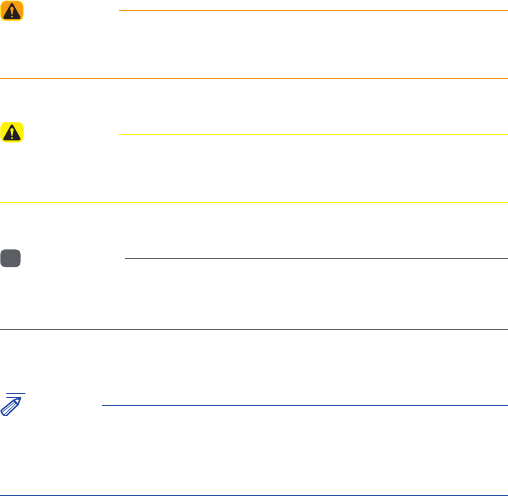
Read the following safety precautions
for your safety
Before using the product, read the contents of this user's manual
carefully and use this product safely.
※ The design and specifi cations of this product may change without prior
notifi cation for product and service improvement.
The actual features in the vehicle may differ from the illustrations.
For more accurate information about the vehicle, please refer to the
catalogue.
※ This Audio system contains open source software, including without
limitation, software distributed and/or modifi ed under the GNU General
Public license, Version 2, June 1991, and the GNU lesser General Public
License, Version 2.1, February 1999.
For additional information and to obtain related materials including
without limitation, the previous referred to licenses and software, please
contact us at MOBIS_OSSrequest@mobis.co.kr
Notations used within this User's Manual
WARNING
• Failure to observe the instructions within this category could result in death
or serious injury or damage to the vehicle.
CAUTION
• Information on matters that could potentially lead to injury or vehicle
damage/malfunction Information that could lead to higher user safety
i
Information
• Information and tips that provide additional user convenience in using the
product
NOTICE
• Information on specific features that facilitate proper product use and
functional understanding
• Information on terminology used within this manual
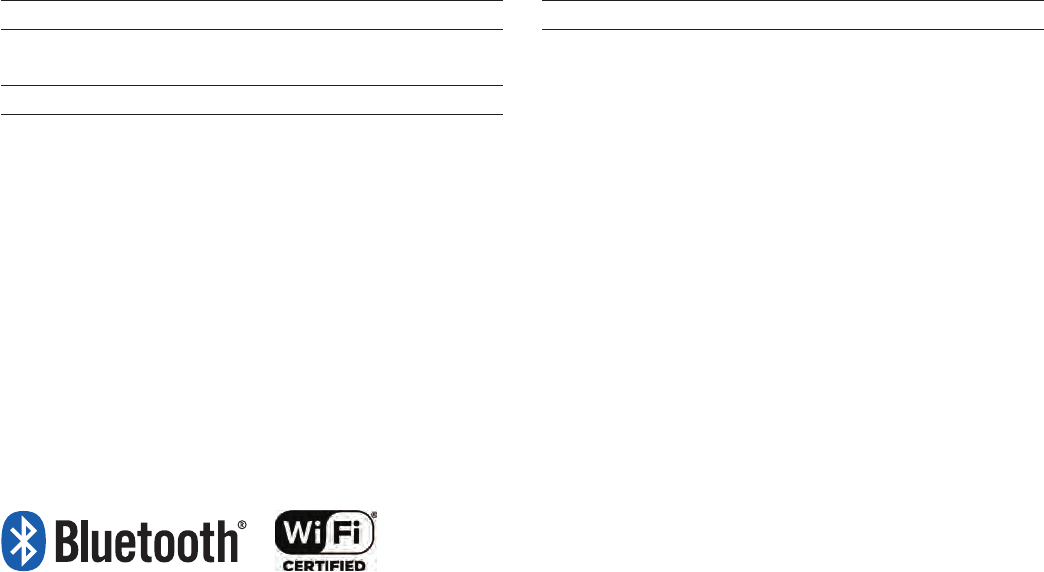
iPod®
iPod® is a registered trademark of Apple Inc.
Bluetooth
®
Wireless Technology
A compatible
Bluetooth
®
Wireless Technology-enabled cell phone is
required to use
Bluetooth
®
Wireless Technology.
The
Bluetooth
® word mark and logos are registered trademarks owned by
Bluetooth SIG, Inc. and any use of such marks by Kia is under license.
Other trademarks and trade names are those of their respective owners.
A Bluetooth® enabled cell phone is required to use
Bluetooth
®
Wireless
Technology.
Bluetooth
®
Wireless Technology phone compatibility can be checked by
visiting http://www.kia.com.
Wi-Fi®
The Wi-Fi CERTIFIED™ Logo is a certifi cation mark of Wi-Fi Alliance.

Warnings and Cautions
Key Product Features
Component Names and Functions
Starting the System for the First Time
part.1 Basic

1-2 I Basic
Safety Warnings
• Do not stare at the screen while driving.
Staring at the screen for prolonged peri-
ods of time could lead to traffic accidents.
• Do not disassemble, assemble, or modify
the Multimedia system. Such acts could
result in accidents, fire, or electric shock.
• Heed caution not to spill water or intro-
duce foreign objects into the device.
Such acts could lead to smoke, fire, or
product malfunction.
• If you use phone related functions while
driving, you will find it difficult to concen-
trate on operating the vehicle and the
current traffic conditions, so the possibility
of an accident may increase. Please
use phone related functions only when
parked.
• Please refrain from use if the screen
is blank or no sound can be heard as
these signs may indicate product mal-
function. Continued use in such con-
ditions could lead to accidents (fires,
electric shock) or product malfunctions.
• Do not touch the antenna during thun-
der or lightening as such acts may lead
to lightning induced electric shock.
• Do not stop or park in parking-restricted
areas to operate the product. Such acts
could lead to traffic accidents.
• For most Audio and multimedia modes,
the display will not operate when the
vehicle is in motion. For your safety, first
park the vehicle to watch or view the
screen.(The screen will only operate
when the parking brake is ON for man-
ual transmission vehicles and when the
parking brake is ON or the gearshift is in
the P (PARK) position for automatic.)
• Some functions other than the one
mentioned above cannot be used while
driving. These functions operate only
when the vehicle is parked.
Basic

Warnings and Cautions I 1-3
01
Safety Cautions
Pay attention to traffic conditions while
driving.
• Operating the device while driving could
lead to accidents due to a lack of atten-
tion to external surroundings. First park
the vehicle before operating the device.
In addition, the touch screen may not
work for some functions when the vehi-
cle is in motion. The touch screen fea-
ture will be supported once the vehicle
has stopped.
• Adjust the volume to levels that allow
the driver to hear sounds from outside
of the vehicle. Driving in a state where
external sounds cannot be heard may
lead to accidents.
• Pay attention to the volume setting when
turning the device on. A sudden output
of extreme volume upon turning the
device on could lead to hearing impair-
ment. (Adjust the volume to a suitable
levels before turning off the device.)
• If you want to change the position of
device installation, please inquire with
your place of purchase or service main-
tenance center. Technical expertise is
required to install or disassemble the
device.
• Turn on the car ignition before using this
device. Do not operate the Multimedia
system for long periods of time with the
ignition turned off as such operations
may lead to battery discharge.
• Upon using the Multimedia system
for more than 10 minutes with the car
engine turned off, the following warning
will be displayed. After 10 minutes, the
warning will be displayed for 5 seconds
every 1 minute.
• Do not subject the device to severe
shock or impact. Direct pressure onto
the front side of the monitor may cause
damage to the LCD or touch screen.
• When cleaning the device, make sure
to turn off the device and use a dry and
smooth cloth. Never use tough materi-
als, chemical cloths, or solvents(alcohol,
benzene, thinners, etc.) as such mate-
rials may damage the device panel or
cause color/quality deterioration. When
experiencing product concerns, inquire
with your place of purchase or service
maintenance center.
• Prevent caustic solutions such as per-
fume and cosmetic oil from contacting
the dashboard because they may cause
damage or discoloration.

1-4 I Basic
Key Product Features
This device is a Multimedia system equipped with a multifunc-
tional player that supports Radio (FM, AM), SiriusXM™, USB,
iPod, AUX, Bluetooth Audio and My Music features. The WIDE
VGA LCD provides a high quality resolution while the powerful
and rich sound system adds to the driving enjoyment.
Display
Wide TFT-LCD Display
• Provides high quality video through a Wide
TFT-LCD Display using an LED Back Light.
• Touch screen for maximum user convenience.
Radio
Digital Tuner Feature
• Digital Tuner using PLL method that supports
memory of 40 broadcast stations.
Radio broadcast station name
• Displays broadcast station names.
Multimedia
Player
Support for various Media Formats
• Support for various media formats, including
Radio, USB, iPod, AUX and Bluetooth
®
Audio
Streaming modes
My Music
• Supports copying of music stored within USB
devices into My Music (internal memory) mode
Miscellaneous
Bluetooth
®
Wireless Technology
• Convenient use of Bluetooth
®
Handsfree by
using buttons within the steering wheel control
Digital Screen Control Features
• Easy control of features through touch screen
options
Steering Wheel Control
• Control over audio features, voice recognition
and Bluetooth
®
through the steering wheel
control for maximum convenience
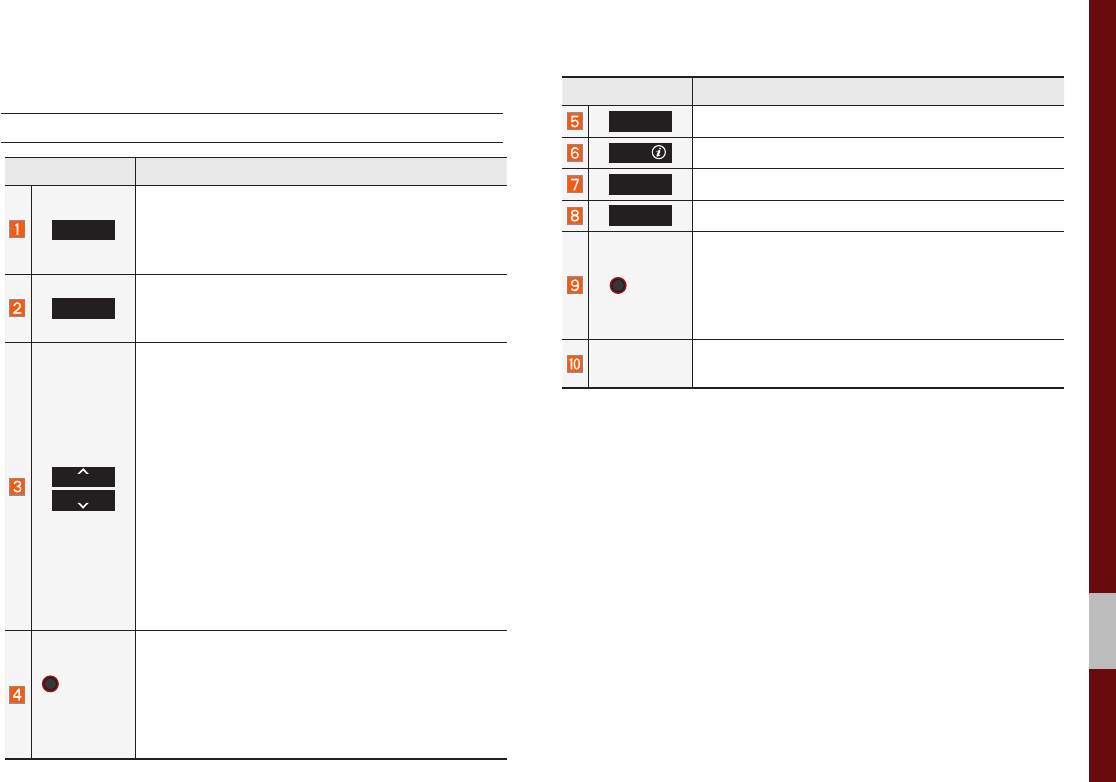
Component Names and Functions I 1-5
01
Component Names and Functions
Head Unit
Name Description
RADIO
Selects FM/AM/SiriusXM™ mode
• Each time this is pressed, the mode is changed
in the following order: FM → AM → SiriusXM™
→ FM.
MEDIA
Selects MEDIA mode.
• If the media is not connected MEDIA mode will
not be activated.
TRACK
SEEK
When pressed quickly (less than 0.8 seconds),
• FM/AM mode: Plays the previous/next fre-
quency.
• SiriusXM™ mode: Changes the channel.
• MEDIA (USB/iPod/My Music) mode: Changes
the track, file or title (except for USB Image and
AUX).
When pressed and held down (more than 0.8 sec-
onds),
• FM/AM mode: Continuously changes the fre-
quency until the key is released.
• MEDIA (USB/iPod/My Music) mode: Rewinds
or fast forwards the track or file (except for USB
Image, Bluetooth Audio, and AUX).
POWER/
VOL
• When power is off, press to turn power on.
• When power is on, press and hold (more than
0.8 seconds) to turn the power off.
• When power is on, press quickly (less than 0.8
seconds) to turn Audio off.
• Turn left/right to adjust the volume.
Name Description
PHONE
Displays the Bluetooth phone mode.
APPS/
Moves to the Apps/Info screen.
UVO
Moves to the UVO mode
SETUP
Moves to the Setup screen.
TUNE
• FM/AM mode: Changes the frequency.
• SiriusXM™ mode: Changes the channel.
• MEDIA (USB/iPod/My Music) mode: Changes
the track, file or title (except USB Image,
Bluetooth Audio, and AUX).
RESET Resets the system settings. (Preset radio channels
and other data will not be deleted)
※ The actual feature in the vehicle may differ from the illustration.
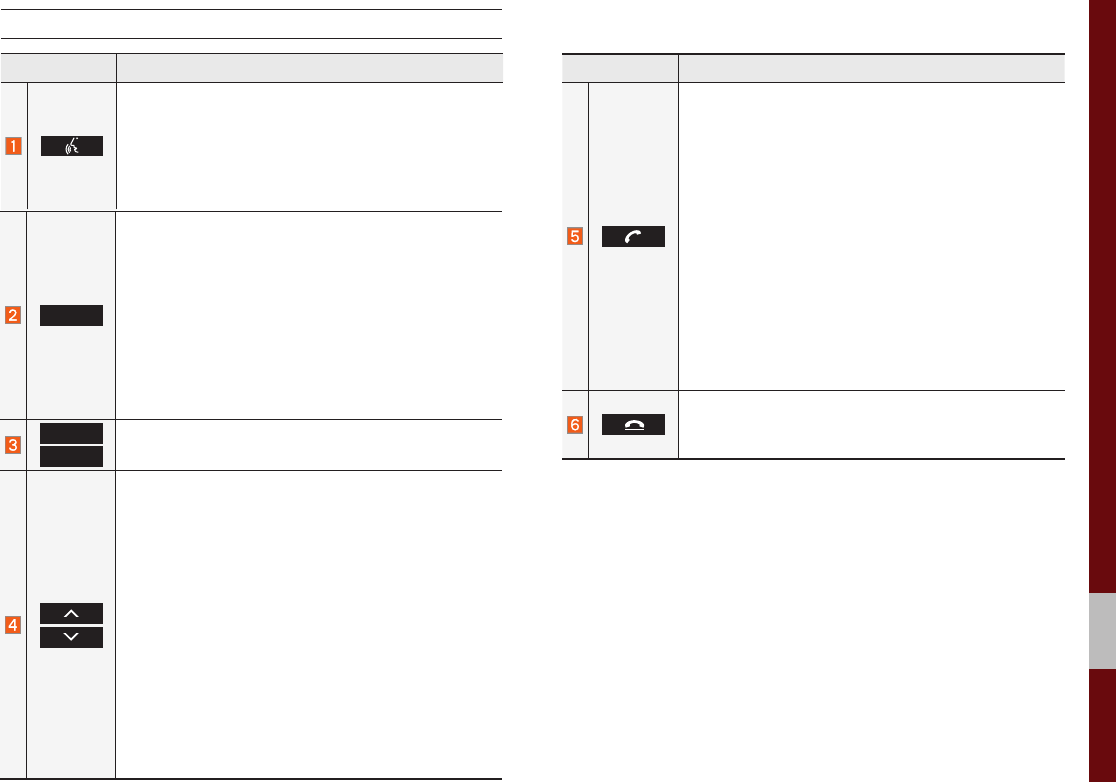
Component Names and Functions I 1-7
01
Name Description
When pressed quickly (less than 0.8 seconds),
• Activates voice recognition.
When pressed and held (more than 0.8 seconds),
• Ends voice recognition.
• If iOS device is connected through Bluetooth,
activates or ends Siri Eyes Free.
MODE
• Each time this is pressed, the mode is changed in
the following order: FM → AM → SiriusXM → USB
or iPod → AUX → Bluetooth Audio → My Music →
→ FM
• If the media is not connected, the corresponding
modes will be disabled
• Press and hold (more than 0.8 seconds) to turn
the Audio system on/off
• When power is off, press button to turn power
back on
VOL +
VOL -
Controls the volume
When pressed quickly (less than 0.8 seconds),
• FM/AM mode: searches broadcast frequencies
saved to Presets
• SiriusXM™ mode: searches broadcast channels
saved to Presets
• MEDIA (USB/iPod/My Music) mode: changes the
track, file or title (except USB Image, AUX)
When pressed and held (more than 0.8 seconds),
• FM/AM mode: automatically searches broadcast
frequencies
• SiriusXM™ mode: automatically searches broad-
cast channels
• MEDIA (USB/iPod/My Music) mode: quickly
looks up songs (excluding USB images, AUX and
Bluetooth audio files)
Steering Wheel Controls
Name Description
When pressed quickly (less than 0.8 seconds),
• When pressed in the dial screen, makes a call
• When pressed in the incoming call screen,
answers the call
• When pressed during call waiting, switches to
waiting call (Call Waiting)
When pressed and held (more than 0.8 seconds),
• When pressed in Bluetooth
®
Hands-free, redials
the last dialed call
• When pressed during a Bluetooth
®
Hands-free
call, switches call back to mobile phone (Private)
• When pressed while calling on the mobile phone,
switches call back to Bluetooth
®
Hands-free
(operates only when Bluetooth
®
Hands-free is
connected)
• When pressed during a call, ends the phone call
• When pressed in the incoming call screen, rejects
the call
※ The actual feature in the vehicle may differ from the illustration.
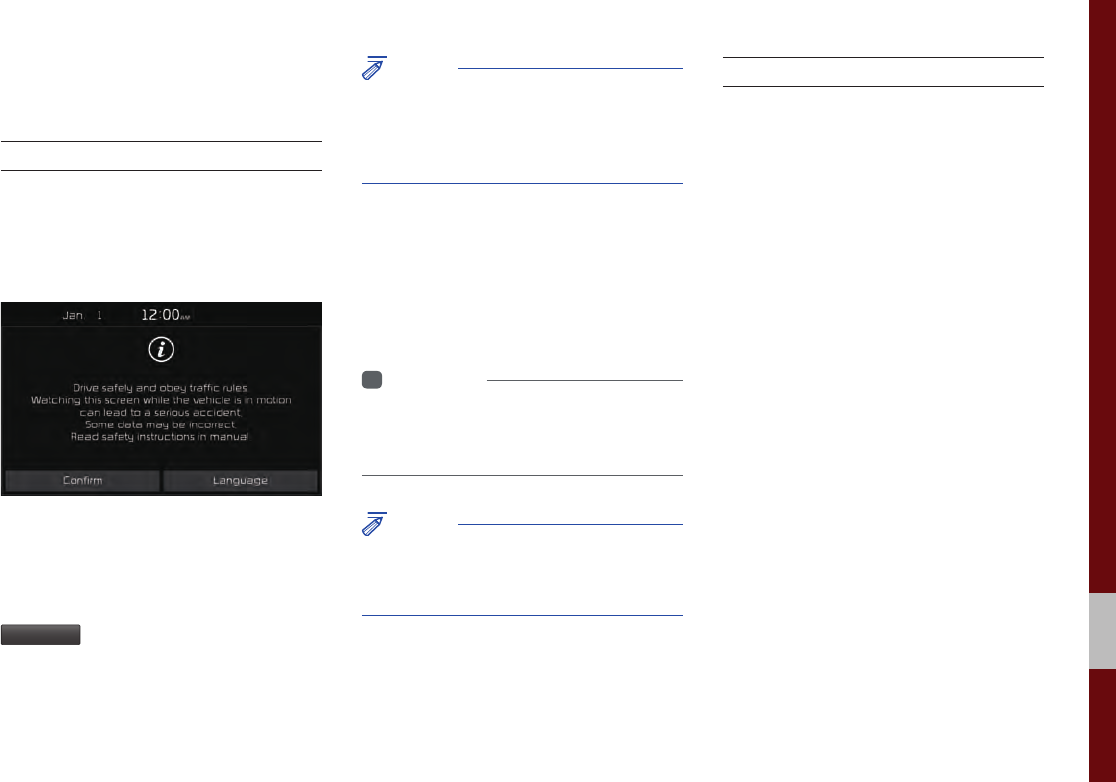
Starting the System for the First Time I 1-9
01
Starting the System for
the First Time
Turning the System On/Off
Press the engine start button or set the
ignition key to On or ACC. Each time you
turn on the system, a boot logo and safety
warning will appear.
Pressing the power key on the head unit
will display the safety guide. To change the
system language between English,
French, Spanish and Korean, select the
Language
button.
NOTICE
• You cannot operate the system while it is
booting up. It may take some time for all of
features of the system, particularly the voice
recognition system, to be ready for use.
Pressing and holding the power key on the
head unit will turn off the system.
You can change Screen Saver Settings
in Setup to display a clock on the Screen
Saver.
i
Information
• If you turn off the system during a phone call
using the Hands-free feature, then the call will
automatically switch to your mobile phone.
NOTICE
• Check the volume when turning on the
system. Before turning on the system, adjust
the volume to a reasonable level.
System Reset
The System Reset function restores the
system when it is not operating correctly.
Press and hold the RESET key for a sec-
ond or longer. (It is recommended that you
press the RESET key using a tool, such as
a pin or a clip.)
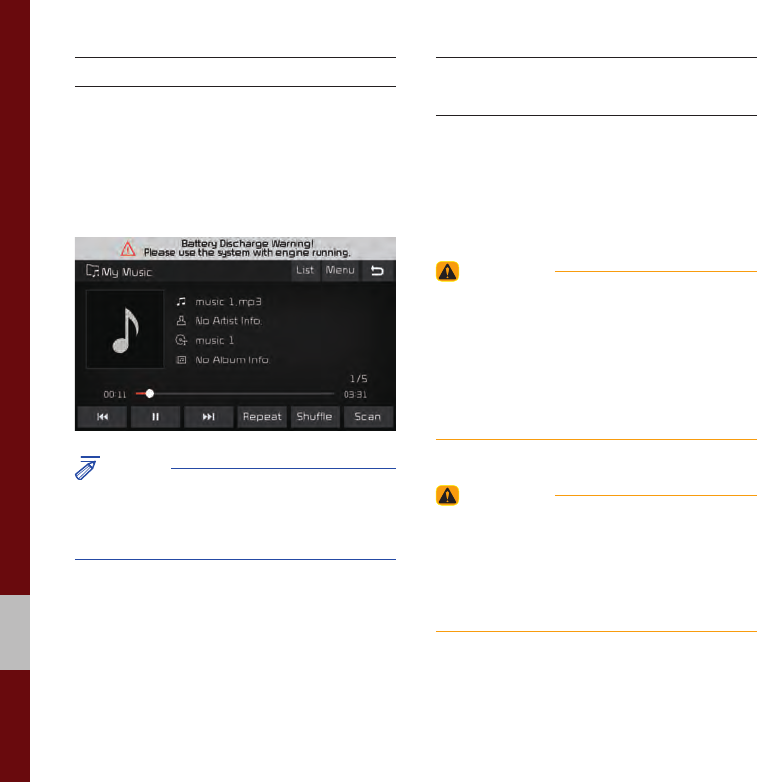
1-10 I Basic
Battery Warning Message
Always use the system while the car
engine is running. If you turn on the sys-
tem while the engine is off, a battery warn-
ing message will appear. When the engine
starts, the message will disappear.
NOTICE
• If you use the system for a long time with
the engine off, the battery may become
completely discharged.
Restrictions on Features for
Safety Measures
Several features are limited while driving.
The restriction screen will disappear when
shifting gears into P or putting the parking
brake on.
WARNING
- Blank Screen
• Refrain from use if the screen is blank or
no sound can be heard as these signs may
indicate product malfunction. Continued use in
such conditions could lead to accidents (fi res,
electric shock).
WARNING
- Touching the Antenna During A
Thunder Storm
• Do not touch the antenna during thunder or
lightning as such acts may lead to lightning
induced electric shock.
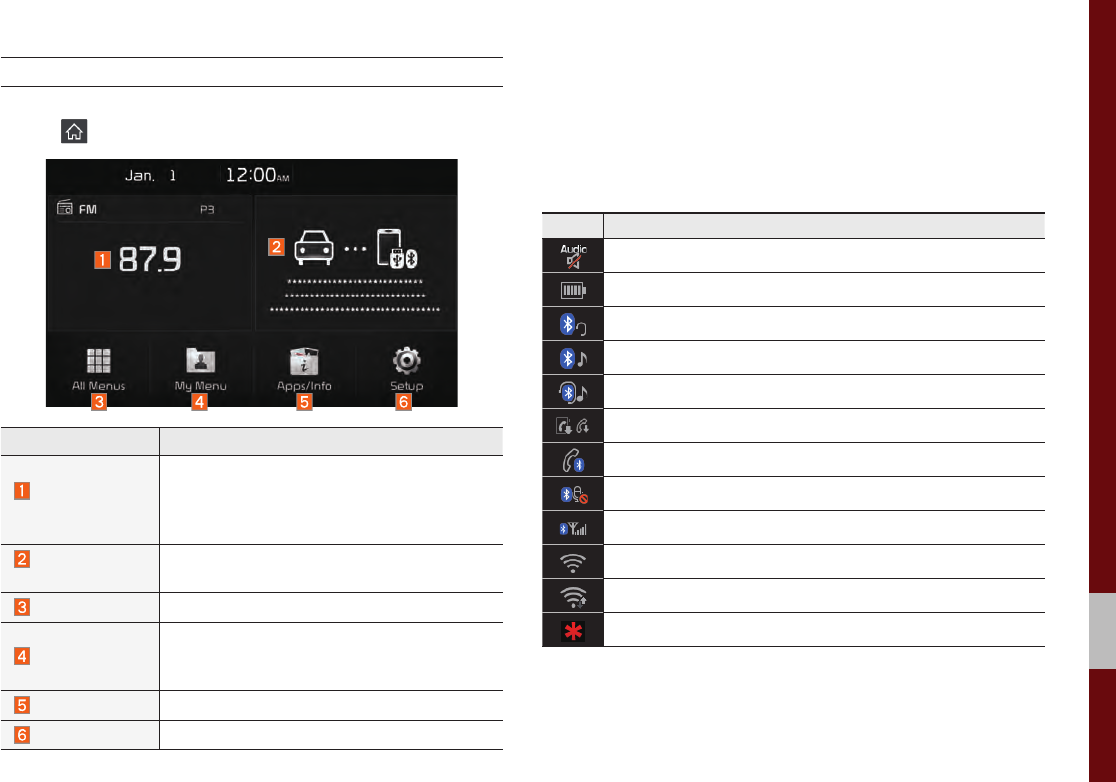
Starting the System for the First Time I 1-11
01
Home Screen
Controls Menu Confi guration for the Home Screen
Tap the icon on any screen to display the Home Screen below.
Features Description
Radio/
Media Widget
• Shows brief information on the radio or
media that is now playing.
• Tap the area to move to the mode that
you are listening to.
Connectivity
Widget
Shows any connected devices such as iPod,
and Bluetooth.
All Menus Shows all of the items in the system menu.
My Menu
• You can add up to eight menus here.
• Add your favorite menus to have quick
and easy access to them.
Apps/Info Moves to the Apps/Info screen.
Setup Moves to the Setup screen.
Information Display on the Status Bar
Displays the date and time, along with the system status shown by
the various icons to the right of the clock.
The icons in the following table indicate the various types of sys-
tem status details and events.
Icon Description
Displayed when the audio is muted.
Displays the remaining battery of the Bluetooth phone.
Displayed when connected to Bluetooth for handsfree.
Displayed when connected to Bluetooth for streaming audio.
Displayed when connected to Bluetooth for streaming audio and handsfree.
Displayed when downloading contacts or recent calls from the Bluetooth phone.
Displayed while on a call with the Bluetooth phone.
Displayed when the microphone of the Bluetooth is muted.
Displays the signal strength of the Bluetooth phone.
Displayed when connected to Wi-Fi.
Displayed when connecting to Wi-Fi.
Displayed when 911 connect is available.
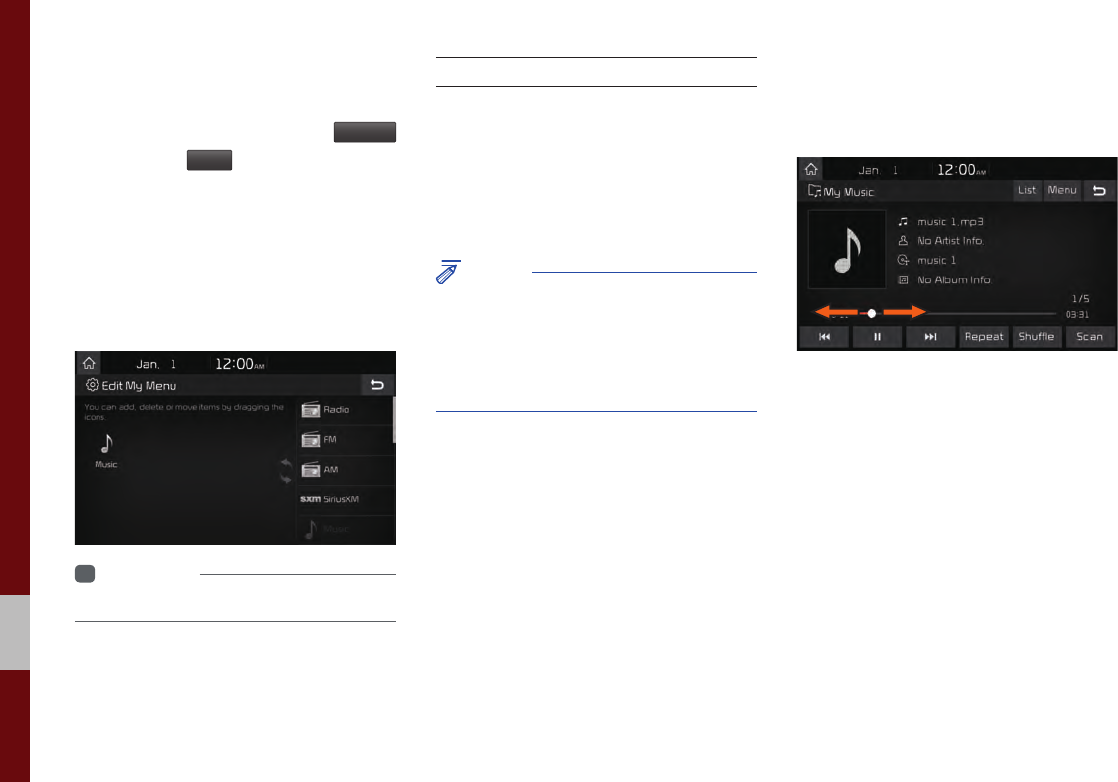
1-12 I Basic
Adding Your Favorite Menu Items to My
Menu
From the Home screen, select
My Menu
icon, and then
Edit
.
From the Edit My Menu screen, select
menu items from the list on the right, then
drag and drop them to a desired place on
the left.
To remove the item from My Menu, drag
item from the left and drop them on the right.
i
Information
• Up to eight items can be added to My Menu.
On-Screen Touch Controls
Learn how to touch the screen to operate
the system.
Select
Tap lightly on a menu or an item to select it.
NOTICE
• The system will not recognize your touch if
you wear a glove or other non-conductive
material. Touch the screen using your fi nger,
an electrostatic touch-screen glove, or a stylus
pen.
Drag & Drop
Select a menu or item you want, then drag
and drop it to where you want to place it.
Drag or touch the slider along the play bar
in the music screens to jump to the point
that you want to play from.
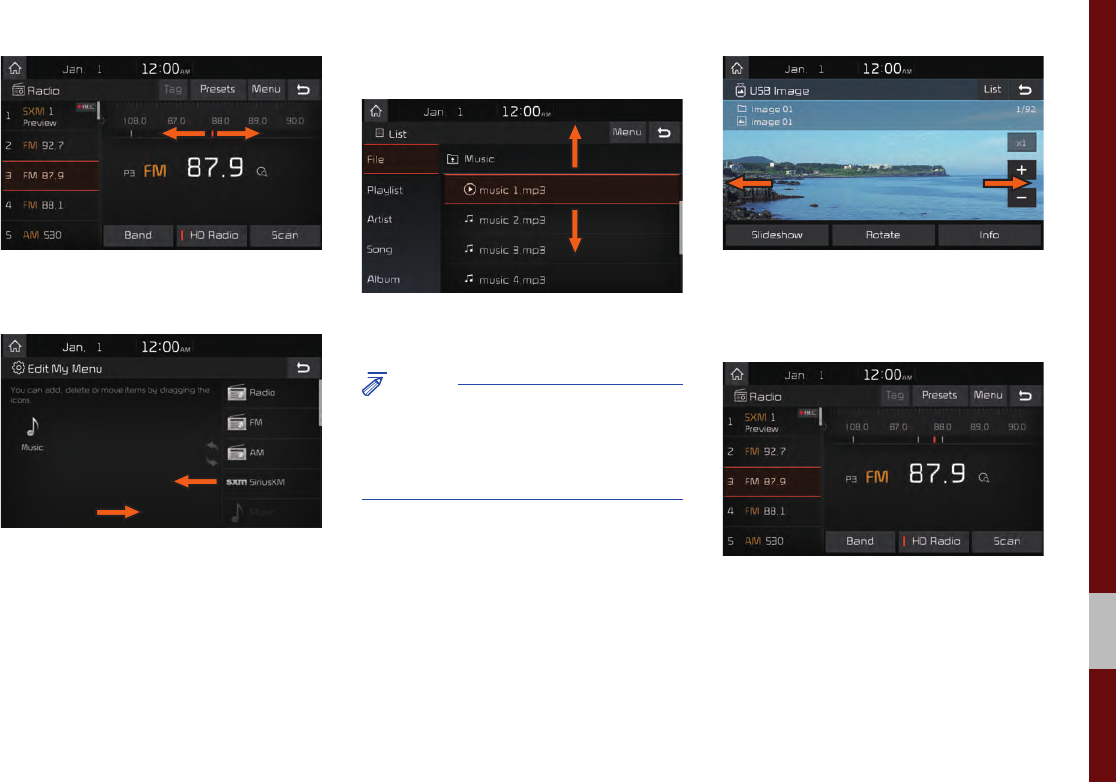
Starting the System for the First Time I 1-13
01
Drag the frequency bar to the left or right
to move to the frequency that you want.
From the Edit My Menu screen, drag and
drop icons to add, delete, or move to/from
My Menu.
Flick (Quick Scrolling)
Quickly moves up and down in the list.
NOTICE
• Moving the list when there are many items will
display a handler on the right of the display.
You can easily move many items at a time
with the handler.
You can view the previous or next image
by flicking left/right on an image on the
USB Image screen.
Flick left/right on the frequency bar in the
radio player to look up the previous/next
frequency available.
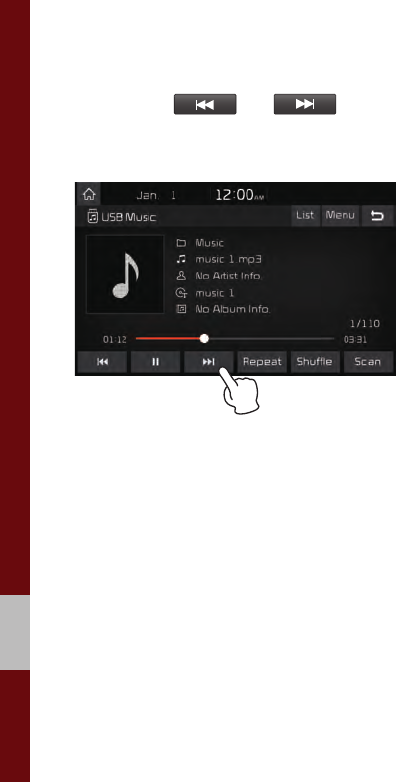
1-14 I Basic
Press and Hold
Pressing the and buttons
in the music player will fast forward/rewind
the music.

FM/AM (with HD Radio™)
HD Radio™ Technology (if equipped)
FM/AM
SiriusXM™
USB
iPod
AUX
Bluetooth® Audio
My Music
part.2 Radio/Media
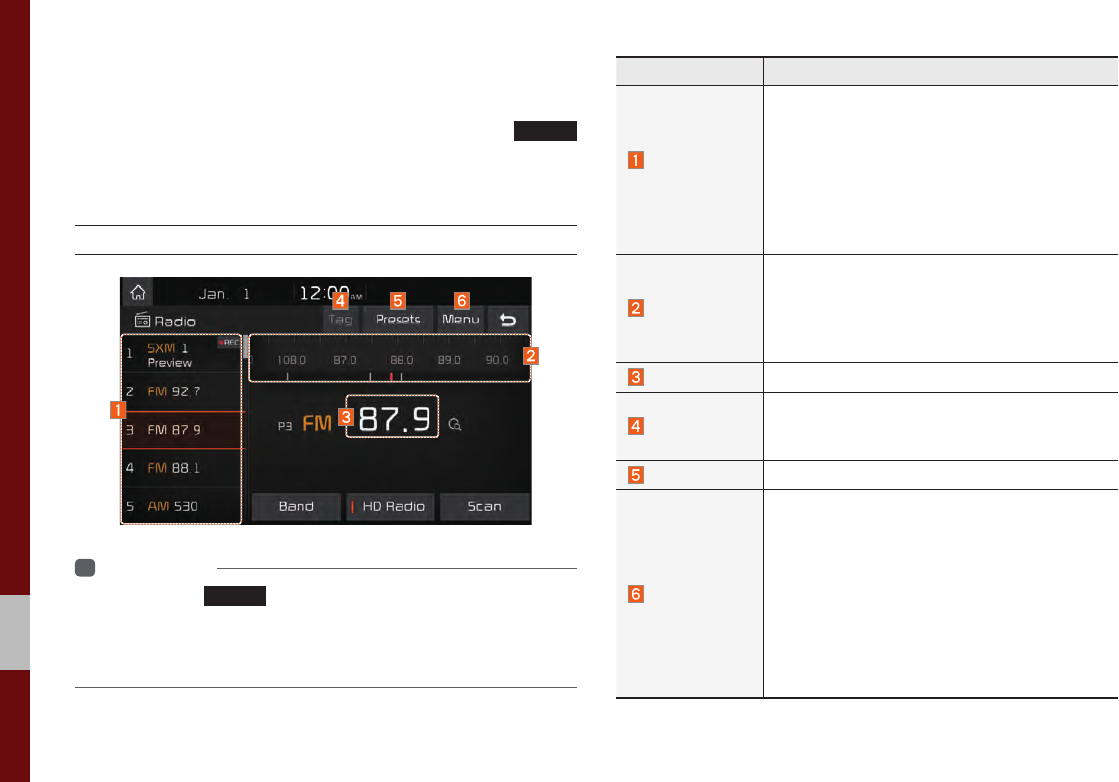
2-2 I Radio/Media
FM/AM (with HD Radio
TM
)
You can access the radio player either by pressing the
RADIO
key or by selecting the Radio menu from All Menus on the Home
screen.
FM/AM Mode Display Controls
i
Information
• If you press the
RADIO
key when power is off, the power will turn on
and a radio broadcast will be tuned from the current mode.
• If you are in radio mode, select the media widget from the Home screen
to access the radio player.
Features Description
Preset
Frequencies
• The stored preset frequencies are displayed
for user selection.
• After selecting frequency, press and hold
the preset button for more than 0.8 seconds.
A beep sound will be heard and the frequency
is to be stored in the selected preset button.
• Flick the preset frequencies up/down to scroll
quickly through presets.
Frequency Bar
• Flick the frequency bar left/right to search for
available radio channels to the left or right of
the current channel.
• Dragging: Drag the frequency bar to the left/
right to find the radio channel that you want.
Frequency Displays the current frequency.
Ta g
Saves the current music’s tag information to the
head unit. If connected to iPod, the tag informa-
tion can be saved on the device.
Presets Shows the stored presets for user selection.
Menu
• List
Moves to the frequency list.
• Info
Turns the Radio text information transmitted
from the broadcasting station on and off.
• Preset Scan
Plays preset frequencies for 10 seconds per
item.
• Sound Settings
Moves to the Sound Settings.
Radio/Media
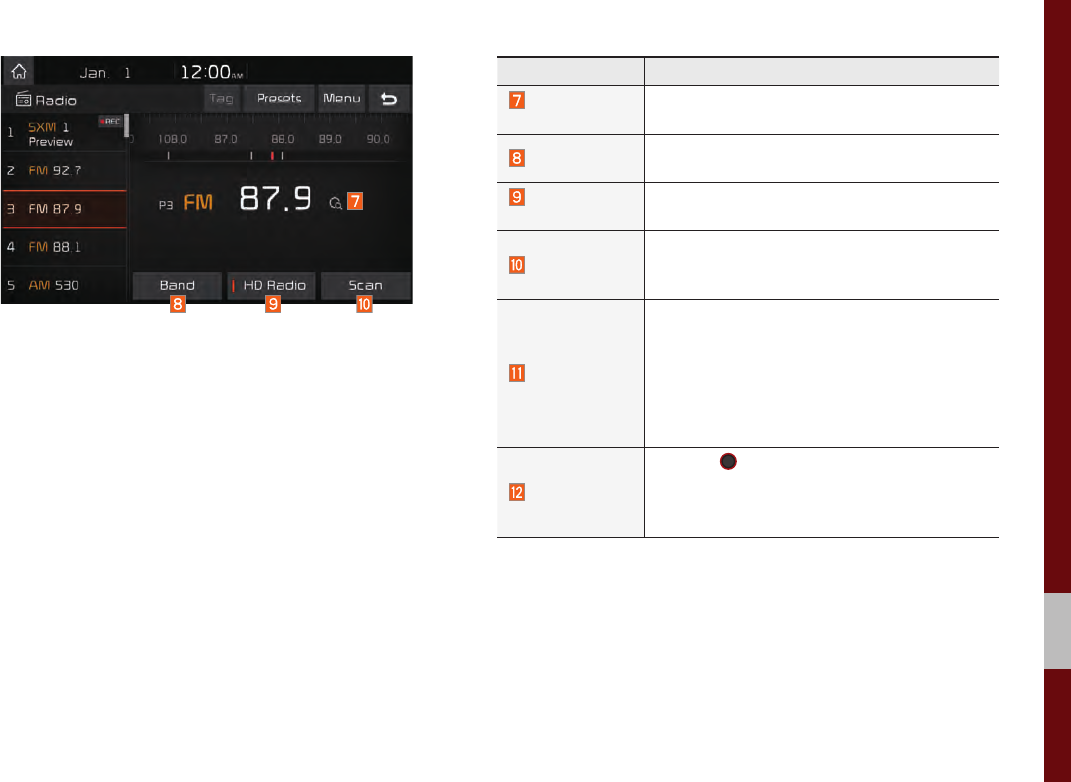
02
FM/AM (with HD Radio™) I 2-3
Features Description
Scan/Preset
Scan
Displays an active mode from Scan and Preset
Scan modes.
Band Changes to the desired band from among FM,
AM, and SiriusXM.
HD Radio
(if equipped)
Used to set whether to turn HD Radio™ recep-
tion On or Off.
Scan
Shortly plays the broadcasts for the frequen-
cies with superior reception for 5 seconds per
item.
SEEK/TRACK
• When pressed quickly (less than 0.8 sec-
onds): Seeks the previous/next frequency.
• When pressed and held (more than 0.8 sec-
onds): Moves quickly through all of the fre-
quencies. The moment that you release the
button, the system seeks the next available
frequency.
TUNE
Turn the
TUNE
knob to manually seek avail-
able frequencies.
• FM: Increment/decrement by 200 kHz
• AM: Increment/decrement by 10 kHz
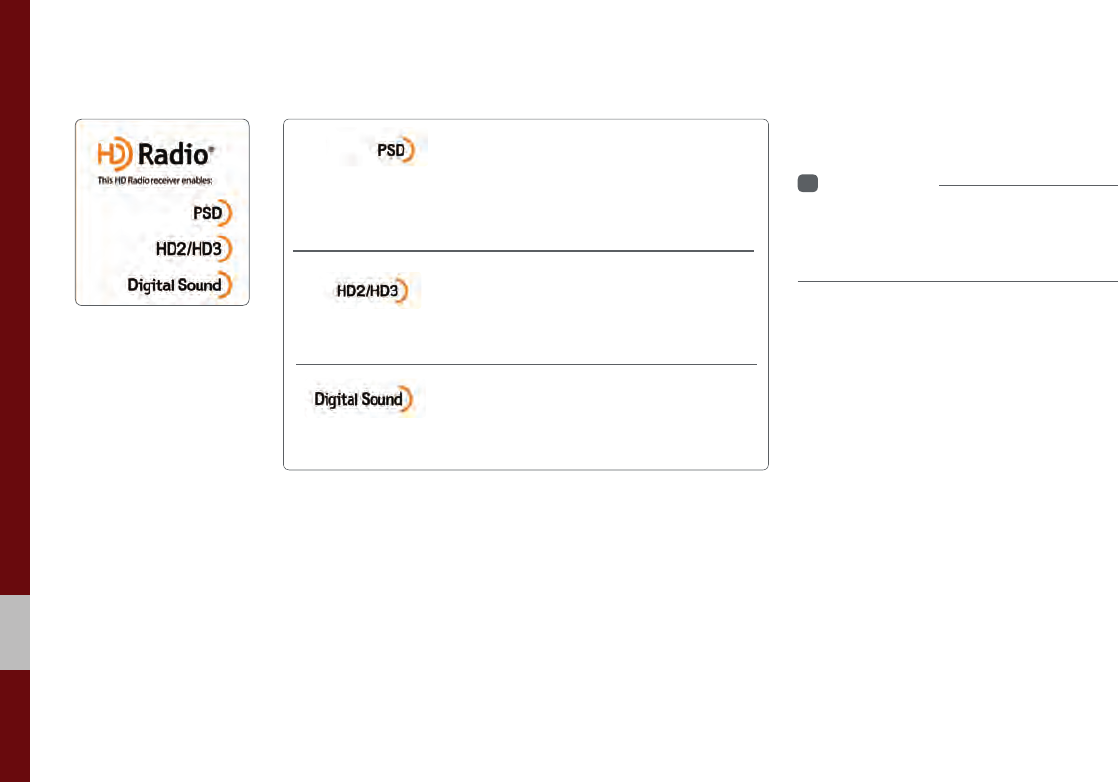
2-4 I Radio/Media
If an HD Radio™ broadcast is received,
the radio mode will switch from analog
broadcast to HD Radio™ broadcast.
i
Information
• The
HD Radio™
screen is displayed only
when a HD Radio™ broadcast is being
received.
Program Service Data:
Contributes to the superior user experience of HD
Radio™ Technology. Presents song name, artist, station IDs, HD2/HD3
Channel Guide, and other relevant data streams.
Adjacent traditional main stations are extra local FM
channels. These HD2/HD3 Channels provide new, origi-
nal music as well as deep cuts into traditional genre.
Digital, CD-quality sound. HD Radio™ Technology
enables local radio stations to broadcast a clean digital
signal. AM sounds like today’s FM and FM sounds like a CD.
HD Radio™ Technology (if equipped)
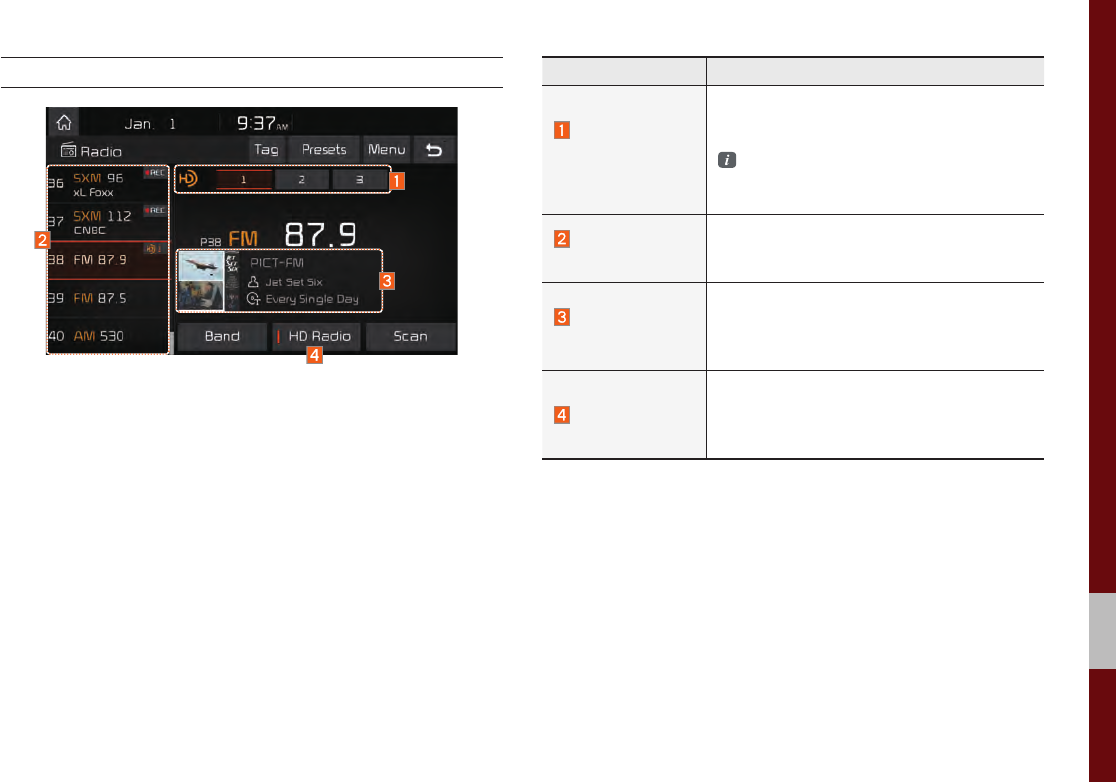
HD Radio™ Technology (if equipped) I 2-5
02
HD Radio™ Mode Display Controls
Name Description
HD Radio™
Reception &
Channel buttons
Displays main HD Radio™ channels and
used to directly select the current available
channels.
The HD Radio™ related icon display
becomes active within regions where an
HD Radio™ signal can be received.
HD Channel
Number
Analog station and corresponding HD
Radio™ channel number saved in the pre-
set list.
HD Broadcast
Info
Displays detailed information about the cur-
rent broadcast (the details of the information
shown are different depending on whether
the Info button is selected)
HD Radio
When the HD Radio™ soft button is ON
(the red indicator on the HD Radio™ button
is illuminated), HD Radio™ signals will be
received.
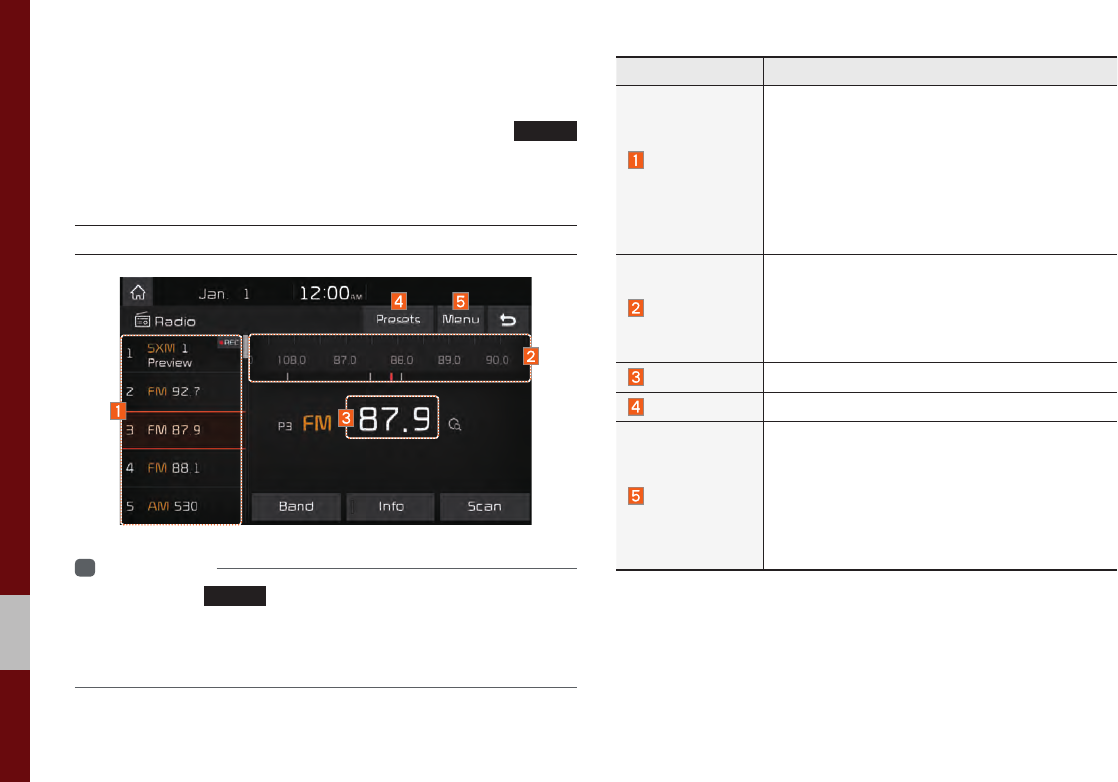
2-6 I Radio/Media
FM/AM
You can access the radio player either by pressing the
RADIO
key or by selecting the Radio menu from All Menus on the Home
screen.
FM/AM Mode Display Controls
i
Information
• If you press the
RADIO
key when power is off, the power will turn on
and a radio broadcast will be tuned from the current mode.
• If you are in radio mode, select the media widget from the Home screen
to access the radio player.
Features Description
Preset
Frequencies
• The stored preset frequencies are displayed
for user selection.
• After selecting frequency, press and hold
the preset button for more than 0.8 seconds.
A beep sound will be heard and the frequency
is to be stored in the selected preset button.
• Flick the preset frequencies up/down to scroll
quickly through presets.
Frequency Bar
• Flick the frequency bar left/right to search for
available radio channels to the left or right of
the current channel.
• Dragging: Drag the frequency bar to the left/
right to find the radio channel that you want.
Frequency Displays the current frequency.
Presets Shows the stored presets for user selection.
Menu
• List
Moves to the frequency list.
• Preset Scan
Plays preset frequencies for 10 seconds per
item.
• Sound Settings
Moves to the Sound Settings.
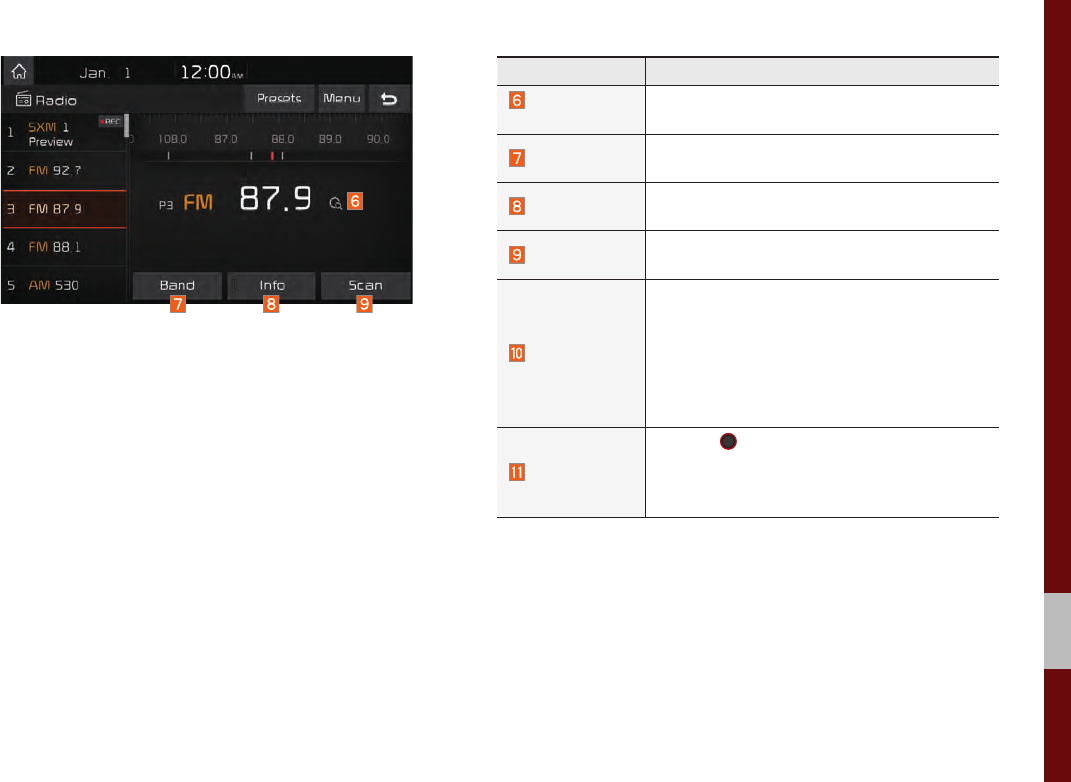
FM/AM I 2-7
02
Features Description
Scan/
Preset Scan
Displays an active mode from Scan and Preset
Scan modes.
Band Changes to the desired band from among FM,
AM, and SiriusXM.
Info Turns the Radio text information transmitted
from the broadcasting station on and off.
Scan Shortly plays the broadcasts for the frequencies
with superior reception for 5 seconds per item.
SEEK/TRACK
• When pressed quickly (less than 0.8 sec-
onds): Seeks the previous/next frequency.
• When pressed and held (more than 0.8 sec-
onds): Moves quickly through all of the fre-
quencies. The moment that you release the
button, the system seeks the next available
frequency.
TUNE
Turn the
TUNE
knob to manually seek avail-
able frequencies.
• FM: Increment/decrement by 200 kHz
• AM: Increment/decrement by 10 kHz
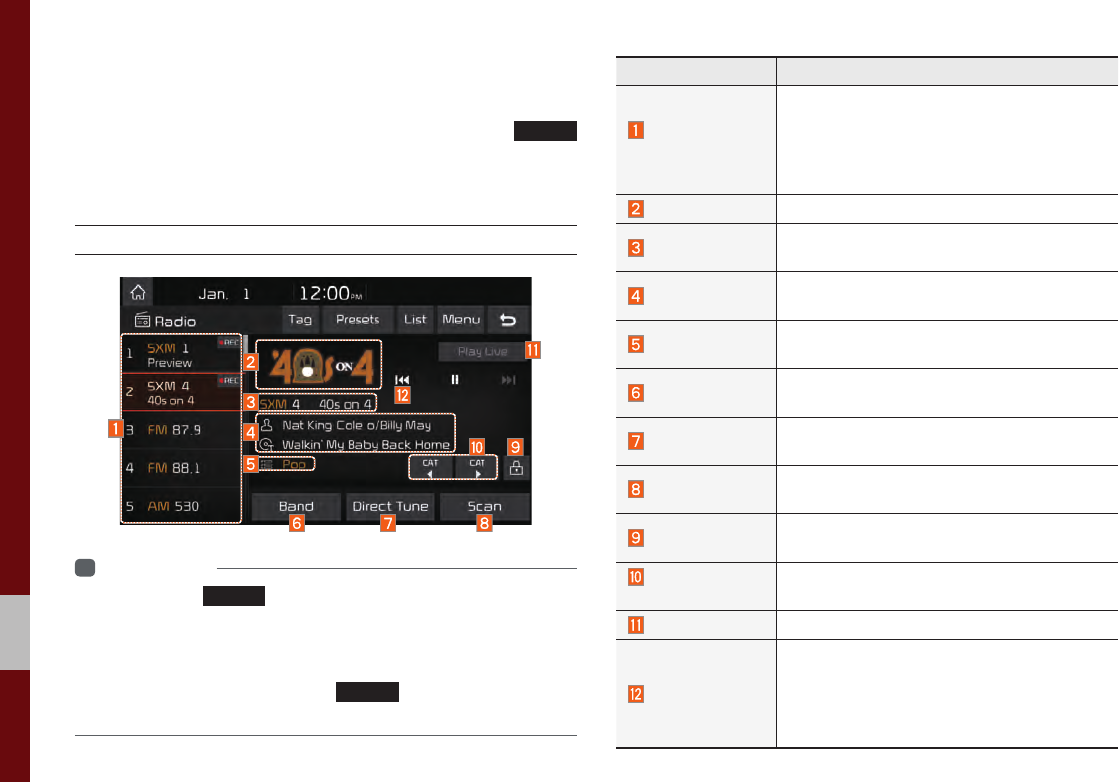
2-8 I Radio/Media
SiriusXM™
You can access the radio player either by pressing the
RADIO
key or by selecting the Radio menu option from All Menus on the
Home screen. Select the SiriusXM™ band from the radio player.
SiriusXM™ Mode Display Controls
i
Information
• If you press the
RADIO
key when the power is off, the power will turn
on and a radio broadcast will be tuned from the current mode.
• If you are in the SiriusXM™ mode, select the SiriusXM™ radio widget
from the Home screen to access the radio player.
• When the power is off, pressing the
RADIO
key will turn the power on
and play a SiriusXM™ Radio broadcast.
Features Description
Preset
Frequencies
• Shows the stored presets for user selection.
• After selecting frequency, press and hold
the preset button for more than 0.8 seconds.
A beep sound will be heard and the frequency
is to be stored in the selected preset button.
Channel Logo Displays the current channel logo.
Channel Info Displays the current channel number and
name.
Content Info Displays the artist, title and other information
about the current playing song.
Category Info Displays the category of the currently playing
song.
Band Changes to the desired band from among FM,
AM, and SiriusXM.
Direct Tune Used to search for the desired channel by
entering the channel number.
Scan Plays all receivable channels for 10 seconds
per item.
Category Lock If pressed, only the channels for the current
category can be searched or scanned.
Category
Selection Buttons Used to select the previous/next category.
Play Live Switches to the live broadcast mode.
Skip Backward
Repeats the previously broadcasted program.
• Holding for less than 0.8 seconds: Moves to
the previous segment.
• Holding for more than 0.8 seconds: Moves
to the previous 5 seconds.
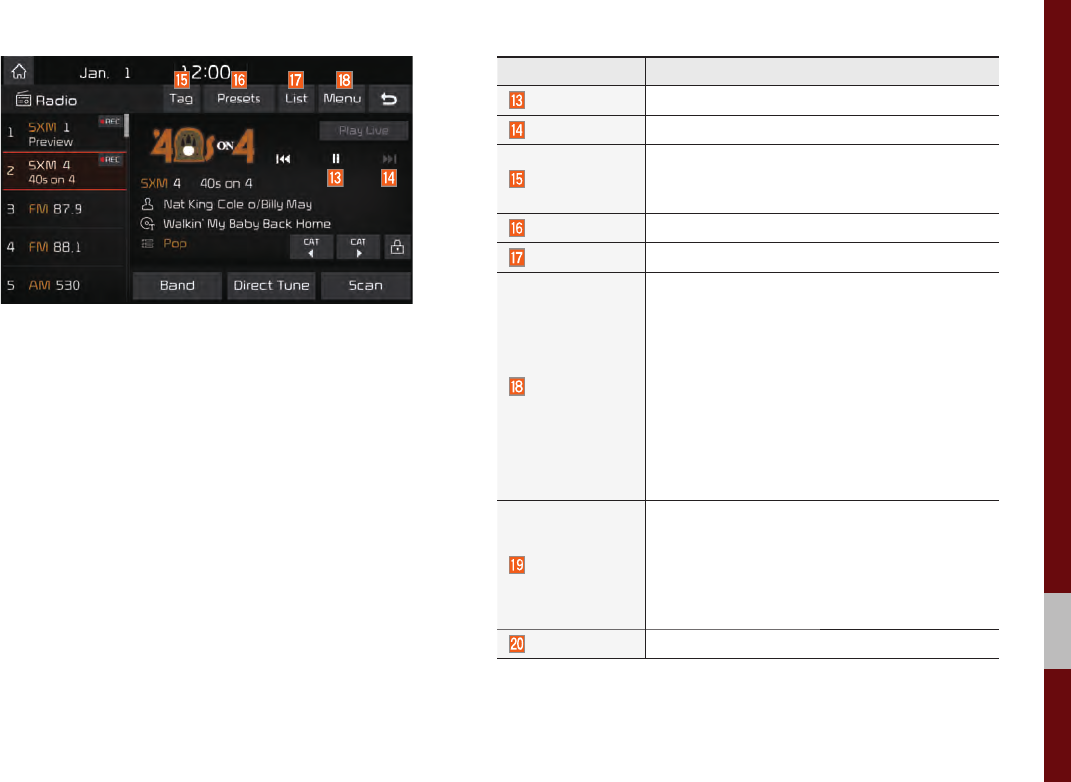
SiriusXM™ I 2-9
02
Features Description
Play/Pause Pauses/plays the current broadcasting program.
Skip Forward Moves to the next segment.
Ta g
Saves the current music’s tag information to the
head unit. If connected to iPod, the tag informa-
tion can be saved on the device.
Presets Shows the stored presets for user selection.
List Moves to the channel list.
Menu
• What is on My Presets?
The program schedule saved in my preset. (For
more details, see Section 3.10. Viewing Menu.)
• Featured Favorites
Theme channels recommended by SiriusXM™.
(For more details, see Section 3.10. Viewing
Menu.)
• Preset Scan
Plays preset channels for 10 seconds each.
• Sound Settings
Moves to the Sound Settings.
SEEK/TRACK
• When pressed quickly (less than 0.8 sec-
onds): Plays the previous/next channel.
• When pressed and held (more than 0.8 sec-
onds): Continuously changes the channel
until the key is released and plays the current
channel.
TUNE Changes the channel.
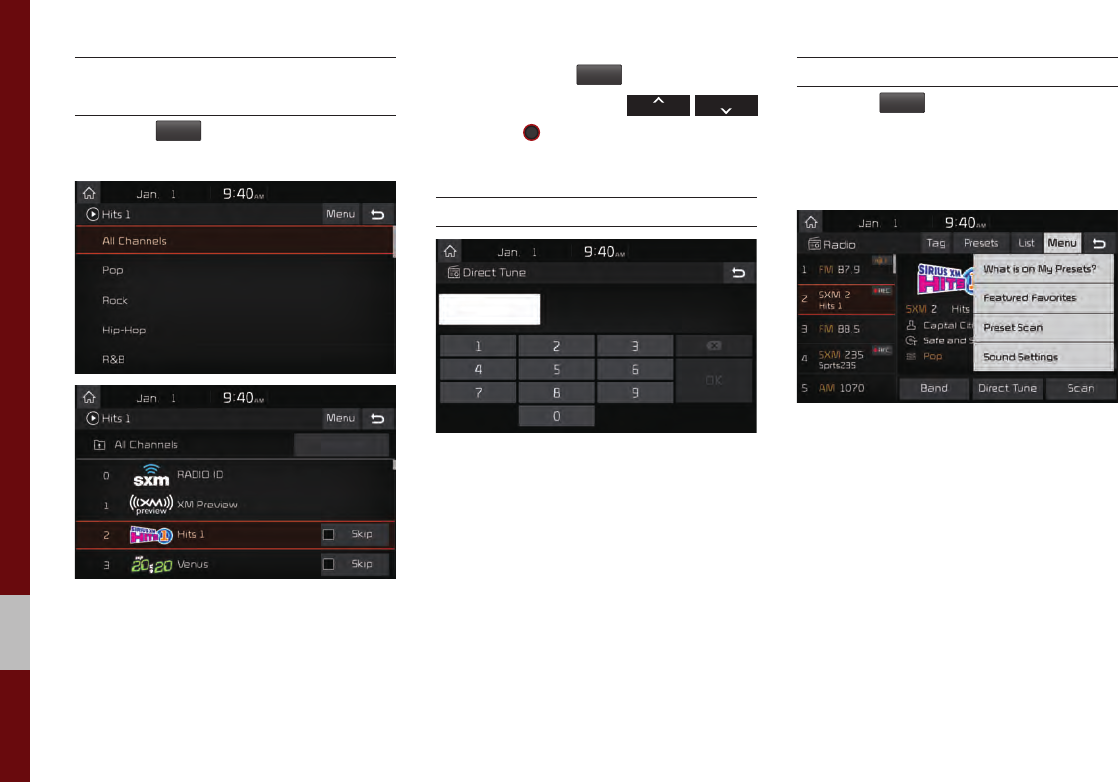
2-10 I Radio/Media
Selecting through
Channel/Category List
Select the
List
▶ Select the desired cat-
egory and channel.
Select the desired category and the chan-
nel. Once selected, the previous screen
will be restored and the selected channel
will begin playing.
If you select the
Skip
button, you can
scan channels using the
SEEK
TRACK
key or the
TUNE
knob by skipping the
channels that you chose to skip.
Direct Tune
Enter the number of the channel you want
to receive.
Viewing Menu
Using the
Menu
button on the right, you
can view the program schedule and infor-
mation about the Featured Favorites pro-
vided by SiriusXM™.
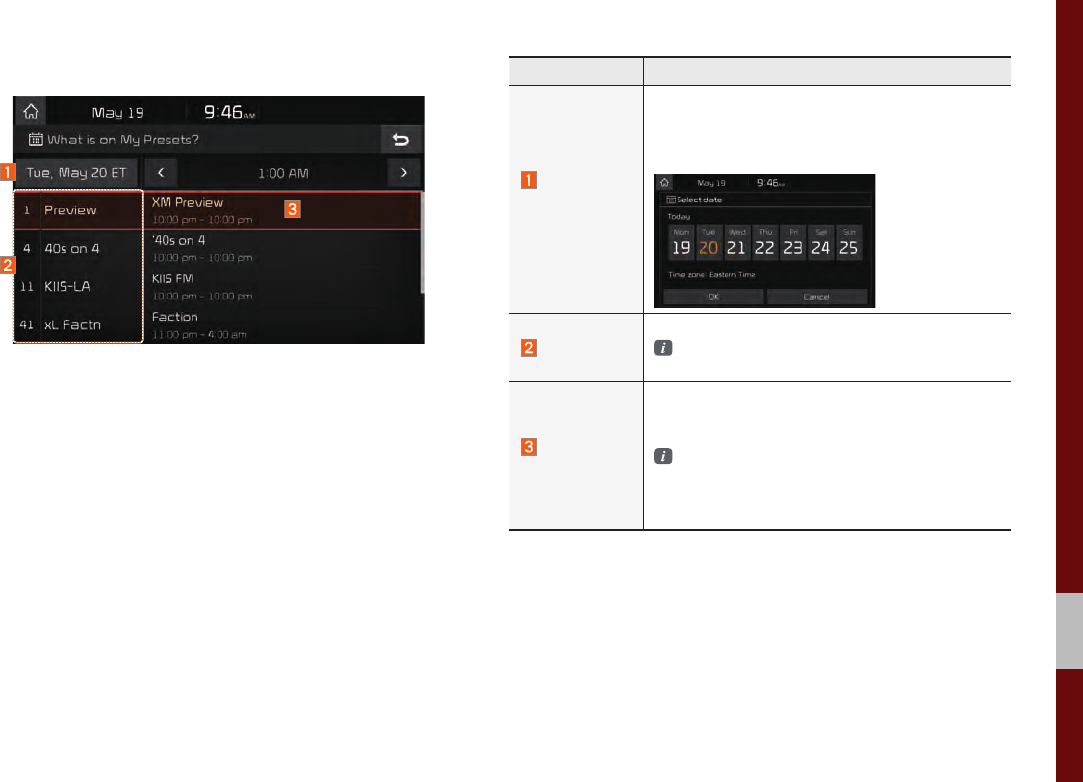
SiriusXM™ I 2-11
02
What is on My Presets? (Program Schedule)
You can select Menu to see program information and the sched-
ules of broadcast channels listed in the presets.
Name Description
Change
Broadcast
Date
By selecting this option, you can select a broad-
casting date.
Broadcast information will be provided for one
week from the current date.
Preset
Shows saved presets for user selection
A total of 40 frequencies for SiriusXM™ modes
can be displayed.
Program
Information
Shows you the program titles to be broadcasted
at the time that you have chosen.
Select a program to see more details.
If there is more information on the program you
selected, an arrow button will be displayed on
the right of the list. You can see more program
information by selecting the arrow button.
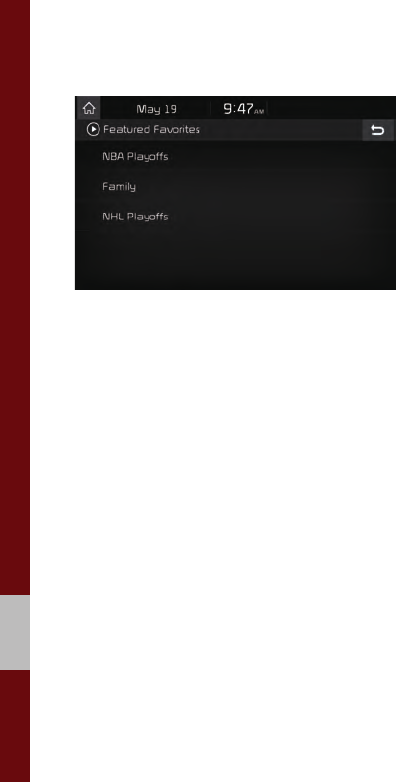
2-12 I Radio/Media
Featured Favorites
Featured Favorites feature allows
SiriusXM™ to broadcast additional presets.
• Example 1: “Martha’s Favorites” may
represent Martha Stuart’s favorites pre-
sets on her radio.
• Example 2: During holidays, “Holiday
Music” may represent all the SiriusXM™
channels that are playing the holiday
music for easy access by users.
Multiple sets Featured Favorites data
can be broadcast by SiriusXM™ and can
change from time to time.

USB I 2-13
02
USB
Before Playing a USB MP3
Connect the USB device after turning on the engine. The USB
device may become damaged if it is already connected when the
ignition is turned on.
• Files that are not standard format music/image files will not be
played.
• For MP3/WMA/OGG files, only music files with compression
rates between 8Kbps ~ 320Kbps can be played.
• Heed caution to static electricity when connecting/disconnecting
external USB devices.
• Encoded MP3 Players will not be recognized when connected
as an external device.
• When connecting an external USB device, the device may not
properly recognize the USB is in some states.
• Only products formatted with byte/sectors under 64Kbyte will be
recognized.
• USB devices, formatted to the FAT12, FAT16, or FAT32 file sys-
tem, are recommended. File systems other than FAT12, FAT16,
FAT32, exFAT, and NTFS are not supported.
• Some USB devices may not be supported due to compatibility
issues.
• Take caution so that the USB connector does not come in con-
tact with body parts or objects.
• Repeated connecting/disconnecting of USB devices within short
periods of time may result in product malfunction.
• Make sure to connect/disconnect external USB devices with the
audio power turned off.
• The amount of time required to recognize the external USB
device may differ depending on the type, size, or file formats
stored on the USB.
• The use of USB devices for purposes other than playing music
and image files is prohibited.
• Do not use the USB I/F to charge batteries or USB accessories
that generate heat. Such acts may lead to worsened perfor-
mance or damage to the device.
• The device may not recognize the USB device if separately
purchased USB hubs and extension cables are being used.
Connect the USB directly with the multimedia terminal of the
vehicle.
• When using mass storage USB devices with separate logical
drives, only files saved to the root drive can be played.
• When application programs are installed to specific USBs, files
may not properly play.
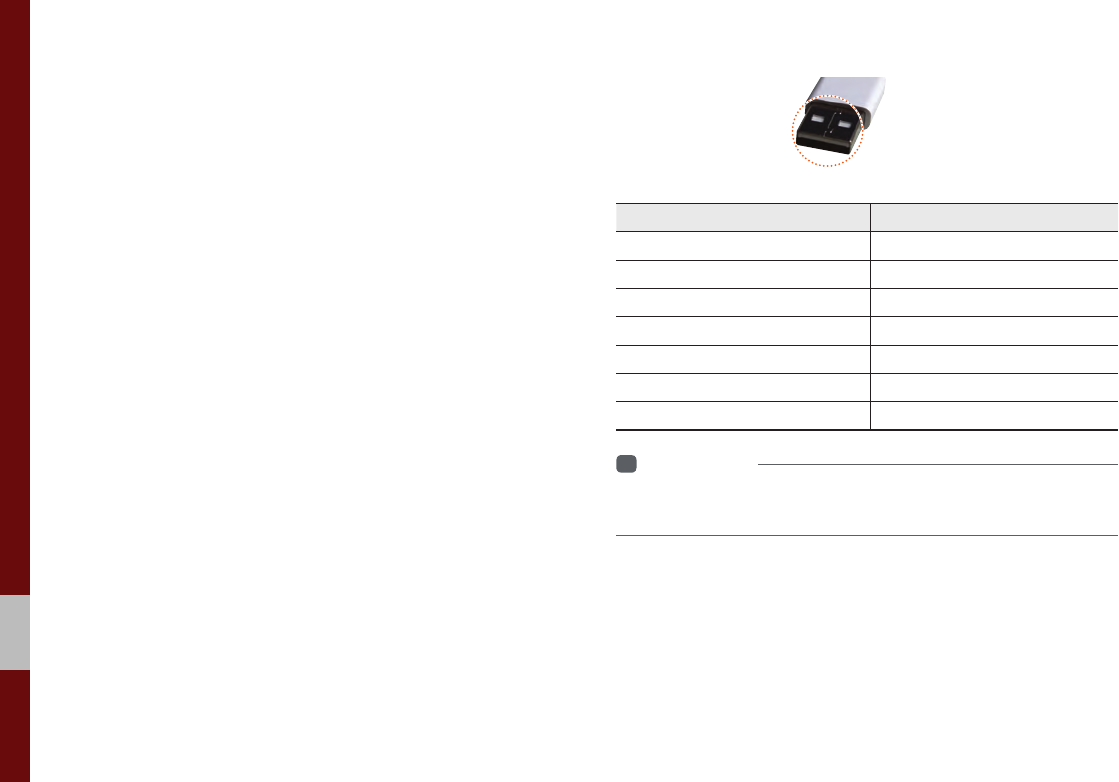
2-14 I Radio/Media
• The device may not operate normally if MP3 Players, cellu-
lar phones, digital cameras, or other electronic devices (USB
devices not recognized as portable disk drives) are connected
with the device.
• Charging through the USB may not work for some mobile
devices.
• The device may not support normal operation when using a
USB memory type besides Metal Cover Type USB Memory.
• The device may not support normal operation when using for-
mats such as HDD Type, CF, or SD Memory.
• When playing iPods, please use a dedicated iPod car cable.
• Normal operation cannot be guaranteed when other cables are
being used.
• The device will not support files locked by DRM (Digital Rights
Management).
• USB memory sticks used by connecting an Adaptor (SD Type or
CF Type) may not be properly recognized.
• Only use Plug type connector products, as shown in the figure
below.
• To play USB MP3, the USB device must be connected to the
USB port in the front multibox. The USB port in the center con-
sole storage (if equipped) is for charging only.
Product Name Manufacturer
XTICK LG
BMK BMK Technology
SKY-DRV Sky Digital
TRANSCEND JetFlash Transcend
Sandisk Cruzer SanDisk
Micro ZyRUS ZyRUS
NEXTIK Digiworks
i
Information
• Problems that occur through use of USB devices not listed within the
above table are not covered by the product warranty.
Plug Type Connector
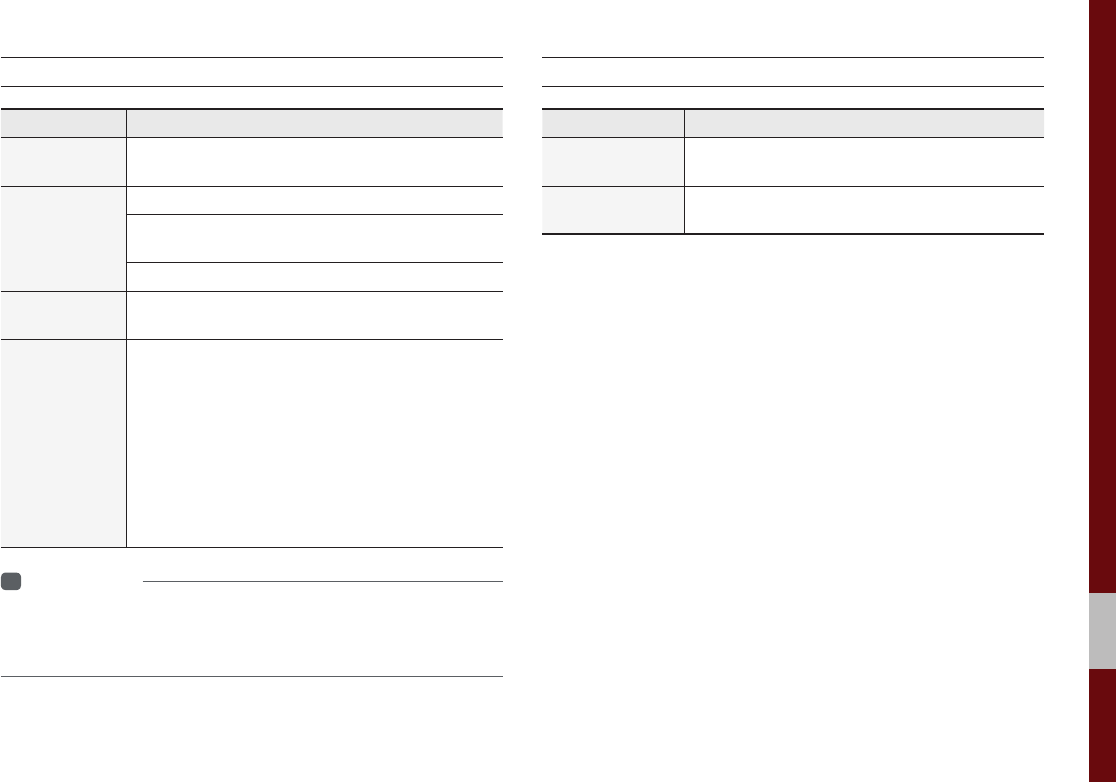
USB I 2-15
02
Supported USB MP3 music specifi cations
Name Description
MP3 File
Specification Specification: MPEG1 AUDIO LAYER 3
Recommended
Bit Rates and
Sampling
Frequency
Acceptable sampling frequency: 32, 44.1, 48 (kHz)
Acceptable bit rate: 32, 40, 48, 56, 64, 80, 96, 112,
128, 160, 192, 224, 256, 320 (Kbps)
96, 128, 192 Kbps fixed bit rate/44.1kHz
ID3 Tag Supports ID3v1.0 and ID3v1.1, ID3v2.2, ID3v2.3,
ID3v2.4 ID3 tags
Detailed
Specifications
Maximum directory layers: 20 layers
Maximum length of folder name/file name: 255Bytes
Supported characters for folder name/file name:
Alphanumeric characters, Korean standard charac-
ter set 2,350 characters, Simplified Chinese 4888
characters
Maximum number of folders which can be stored
onto one USB: 2000 folders (including ROOT)
Maximum number of files which can be stored onto
one USB: 8000
i
Information
• The sound quality of MP3 files that use bitrates exceeding
192 Kbps cannot be guaranteed. When using fi les without fi xed bit rates,
some features (FF/REW features) may not properly operate.
Supported Image Specifi cations
Name Description
Image format JPG, GIF, BMP, PNG (animated GIF, etc. are not
supported)
Supported image
file size
5M pixels for JPG, BMP, PNG (1M pixels maxi-
mum for GIF)
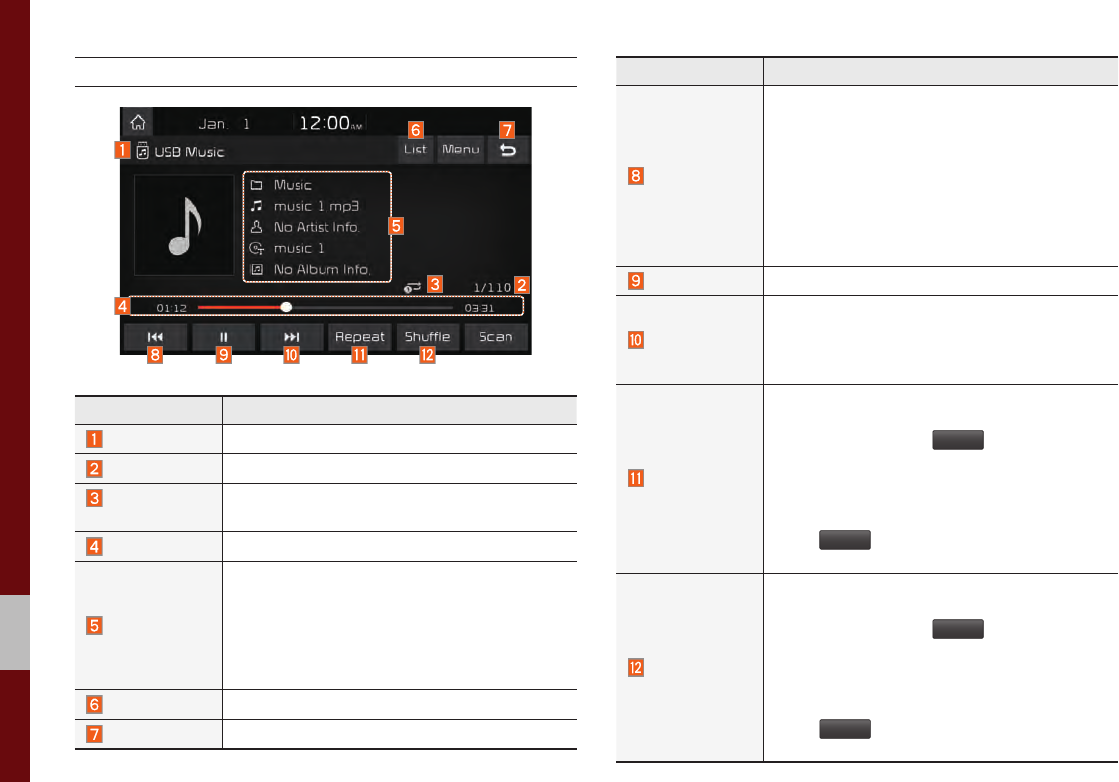
2-16 I Radio/Media
USB Music Mode Display Controls
Features Description
Mode Displays the current operating mode
File Index Shows the current file/total files within the USB
Repeat/
Shuffle/Scan
From Repeat/Shuffle/Scan, displays the current
operating function
Play Time Displays the current play time/total play time
Song Info
Displays the information of the current track
• When a track in the file tab on the list screen
is selected: Displays folder, file, title, artist,
album info
• When a track in the other tabs on the list screen
is selected: Displays artist, title, album info
List Moves to the list screen
Back Button Converts to basic mode screen
Features Description
Previous File
If button is pressed (less than 0.8 seconds):
Moves to the previous file or play the current file
from the beginning (Depends on the play time)
• If play time is less than 3 seconds, moves to
previous file
• If play time is more than 3 seconds, play the
current file from the beginning
If button is pressed (more than 0.8 seconds): It
rewinds the track
Play/Pause Plays/pauses the current file
Next File
• If button is pressed (less than 0.8 seconds):
Moves to the next file
• If button is pressed (more than 0.8 seconds):
It fast-forwards the track
Repeat
Repeats the current file
• If select the song in the file tab on the list
screen: Select the
Repeat
button to switch
between repeating one song, repeating
folder, and turning repeat off
• If select the song in the other tabs (Playlist,
Artist, Song, Album) on the list screen: Select
the
Repeat
button to switch between repeat-
ing one song and turning repeat off
Shuffle
Plays files in random order
• If select the song in the file tab on the list
screen: Select the
Shuffle
button to switch
between Shuffle Folder, Shuffle All, and turn-
ing shuffle off
• If select the song in the other tabs (Playlist,
Artist, Song, Album) on the list screen: Select
the
Shuffle
button to switch between Shuffle
Category and turning shuffle off
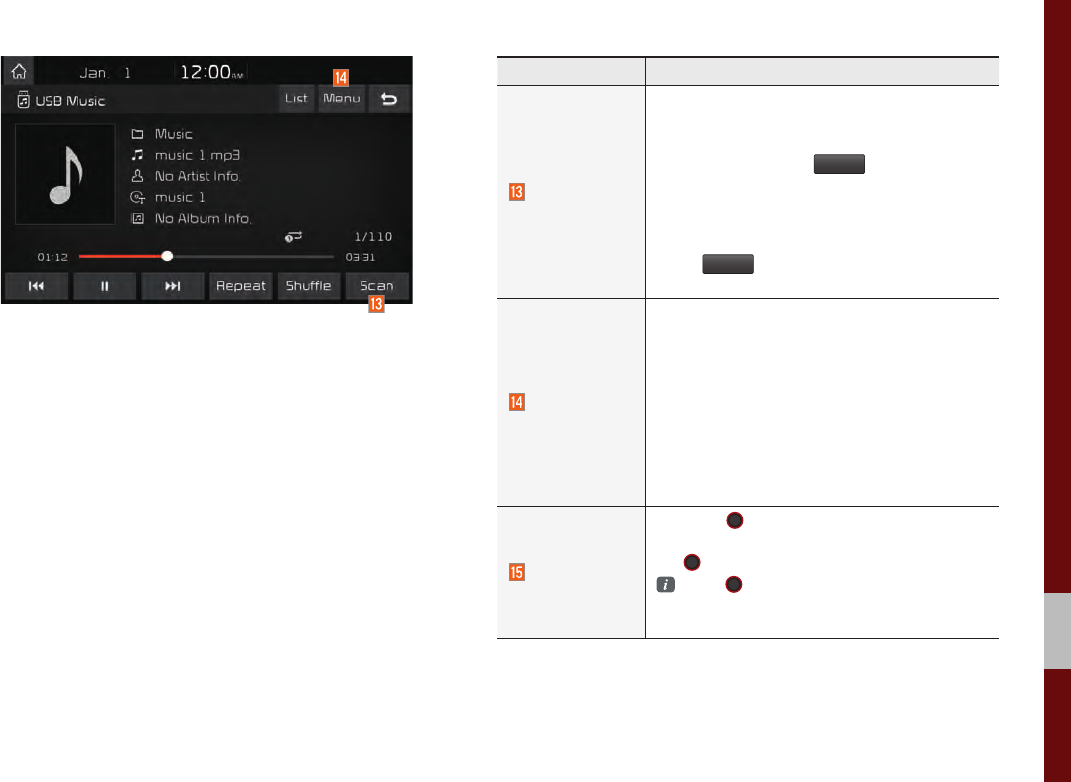
USB I 2-17
02
Features Description
Scan
Scans the beginning parts of USB files (approx.
10 seconds per file)
• If select the song in the file tab on the list
screen: Select the
Scan
button to switch
between Scan Folder, Scan All, and turning
scan off
• If select the song in the other tabs (Playlist,
Artist, Song, Album) on the list screen: Select
the
Scan
button to switch between Scan
category and turning scan off
Menu
• Add to Playlist: Add the current track to the
Playlist: Playlist is placed on the left tab in the
list
• Save to My Music: You can save the current
track to My Music. You can play saved track
from My Music without USB. Access to My
Music in the Media mode.
• Sound Settings: Moves to the Sound Settings
screen. You can change the settings of the
sound.
TUNE
Turn the
TUNE
knob to search a desired
track. If the desired track is displayed, select
the
TUNE
knob to play the track.
If the
TUNE
knob is not pressed within
5 seconds of searching tracks, the track
info for the current track is restored.
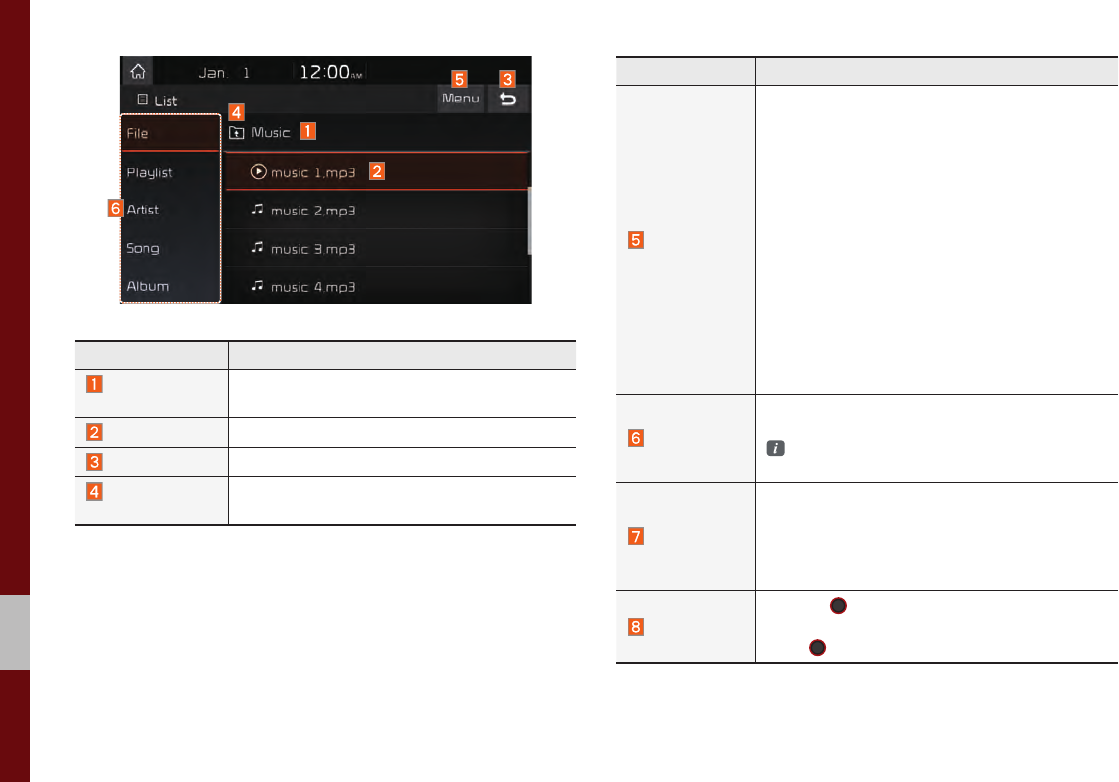
2-18 I Radio/Media
Features Description
Folder/
Category Name Displays folder/category name in the list
Current Song Displays the current playing file name
Back Button Converts to basic mode screen
Upper Folder/
Category Moves to Upper Folder
Features Description
Menu
• Add to Playlist: Adds the current track to the
Playlist: Playlist is placed on the left tab in the
list (Maximum 100 files) Select a desired track
and press “Add to Playlist” to add the track in
the playlist.
• Delete from Playlist: Select a track you want to
delete from the playlist and press “Delete from
Playlist” to delete the track in the playlist
• Now Playing: When moving to a different list
screen, moves to the list page where the cur-
rent file is located (Becomes disabled when
the current list includes the current file)
• Save to My Music: Stores the music. The
stored music can be played in My Music. (This
function is not provided in Playlist.)
Search Menu
Search tracks by the list type. Search songs
according to File, Playlist, Artist, Song and Album.
If access the search menu while playing a
track, it moves to the previous search mode.
SEEK/TRACK
• If button is pressed (less than 0.8 seconds):
Plays previous/next track.
• If button is pressed (more than 0.8 seconds):
Moves to play screen, and then it will rewind or
fast-forward the track.
TUNE
Turn the
TUNE
knob to move the focus to the
previous/next list. If the desired track is displayed,
press
TUNE
knob to play the track.
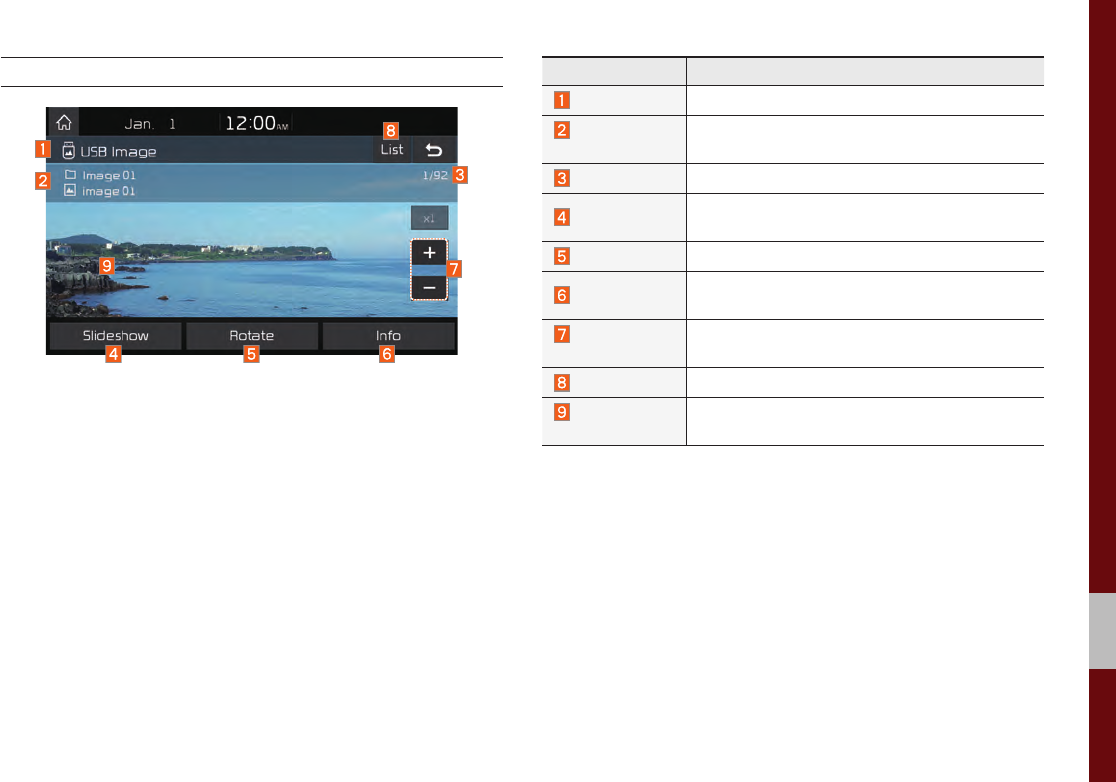
USB I 2-19
02
USB Image Mode Display Controls
Features Description
Mode Displays the current operating mode
Folder/
File Name Displays folder name where image is located
File Index Shows the current file/total files within the USB
Slideshow Images as slideshow in 5, 10, 20, 30 second
intervals
Rotate Rotate image in clockwise direction
Info Shows the file name, resolution and file type of
current image
Adjust Image
Size Enlarge/reduce (zoom-in/zoom-out) image size
List Moves to the list screen
Previous/
Next image
Swipe image left or right to see Previous/Next
image
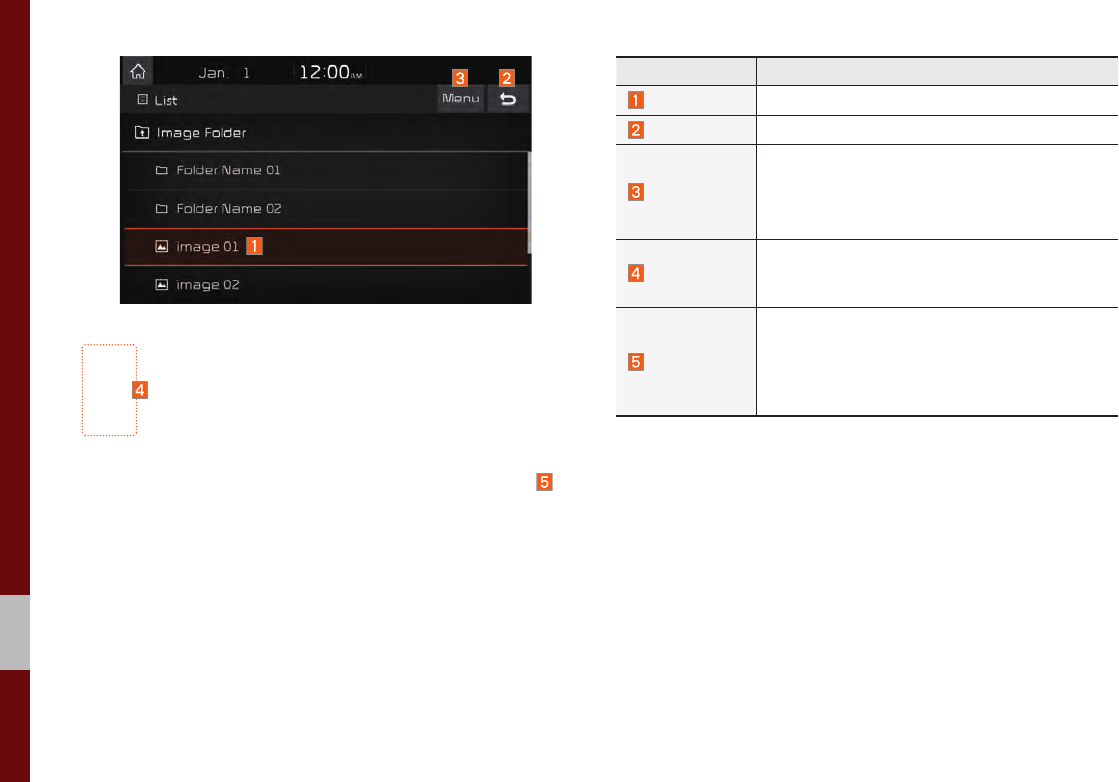
2-20 I Radio/Media
Features Description
Current File Displays the current playing file name
Back Button Converts to basic mode screen
Menu
Now Playing: When moving to a different list
screen, moves to the list page where the current
file is located (Becomes disabled when the cur-
rent list includes the current file)
SEEK/TRACK
Controls background mode
• Radio mode: Changes Frequency and Channel
• Media mode: Changes Track (excluding AUX)
TUNE
Controls background mode
• Radio mode: Changes Frequency and Channel
• Media mode: Changes track (excluding AUX).
If a desired track is displayed, press the knob
to move to the track.

iPod I 2-21
02
iPod
Using iPod Devices
• iPod is a registered trademark of Apple
Inc.
• iPod mode will not operate if the con-
nected iPod cannot be recognized due
to operation of unsupported versions
that do not support related protocols,
iPod abnormalities, or iPod device
defects. Some iPods with unsupported
communication protocols may not prop-
erly operate with the Multimedia system.
• For fifth generation iPod Nano devices,
the iPod may not be recognized when
the battery level is low. Please charge
the iPod for use.
• Search/play orders shown within the
iPod device may differ with the orders
shown within the Multimedia system.
• If the iPod malfunctions due to an iPod
device defect, reset the iPod and try
again. (To learn more, refer to your iPod
manual)
• If repeatedly connect and disconnect
iPod/iPhone to the Multimedia system
with USB cable in a short time, it may
cause abnormal operation.
• The time for recognition of iPod/iPhone
may vary depending on device type,
firmware version and iOS version.
• For some iPod Touch and iPhone
devices, connecting Bluetooth® while the
iPod is operating may result in discon-
tinued iPod sound. When such devices
with Bluetooth® support are connected,
this problem occurs as the sound source
is changed from the Dock Connector
(USB connector cable) to Bluetooth.
• To prevent this symptom, Bluetooth
Audio function in the Multimedia system
is limited if iPod/iPhone is connected
to the system through both cable and
Bluetooth. To listen to the iPod sound,
use either iPod menu with USB connec-
tion or Bluetooth Audio with Bluetooth
connection.
• To listen to the iPod sound, reconnect
the USB cable or change the audio out-
put settings in iPod/iPhone to Dock.
• In order to use the iPod while operating
the keys, you must use a dedicated iPod
cable. (the cable that is supplied when
purchasing iPod/ iPhone products)
※ During ACC ON state, connecting the
iPod through the iPod cable (The cable
that is supplied when purchasing iPod/
iPhone product.) will charge the iPod
through the head unit.
※ ※ The use of genuine iPod cables sup-The use of genuine iPod cables sup-
plied by Apple is recommended. (The plied by Apple is recommended. (The
use of other products may result in use of other products may result in
noise or abnormal operation.)noise or abnormal operation.)
※ To play iPod music through cable con-
nection, the iPod/USB cable must be
connected to the USB port in the front
multibox. The USB port in the center
console storage (if equipped) is for
charging only.

2-22 I Radio/Media
• When connecting with the iPod cable,
make sure to fully insert the jack to pre-
vent communication interference. If the
iPod is connected to the vehicle while it
is playing, a high pitch tone may sound
for about 1~2 seconds immediately
after connection. If possible, connect
the iPod to the vehicle with the iPod
stopped/paused.
• Within iPhones, streaming audio and
iPod control may occasionally conflict.
If problems persist, remove the iPhone
and connect again.
• When connecting to iPod Nano/Classic,
the Kia Motor logo appears on the Apple
device. For the iPod Nano 6 genera-
tion, however, the logo image does not
appear since it is not supported. Also, all
iPhone and iPod Touch products do not
support this function.
• In Apple’s iOS 6.0 version or later,
Podcast and Audiobook media files
are designed to be played with the
Podcasts and iBooks applications spe-
cifically designed for Apple products. If
the Apple device does not provide the
Podcast and Audiobook lists, the playlist
may not be displayed and played in the
iPod mode.
• If the Apple Podcasts and iBooks apps
are not installed on the Apple device, but
the Apple device provides the Podcast
and Audiobook lists, you can play files in
other categories in iPod mode.
• The screen of multimedia system can
be different when you run other music
players (e.g. iHeartRadio) on your con-
nected device.
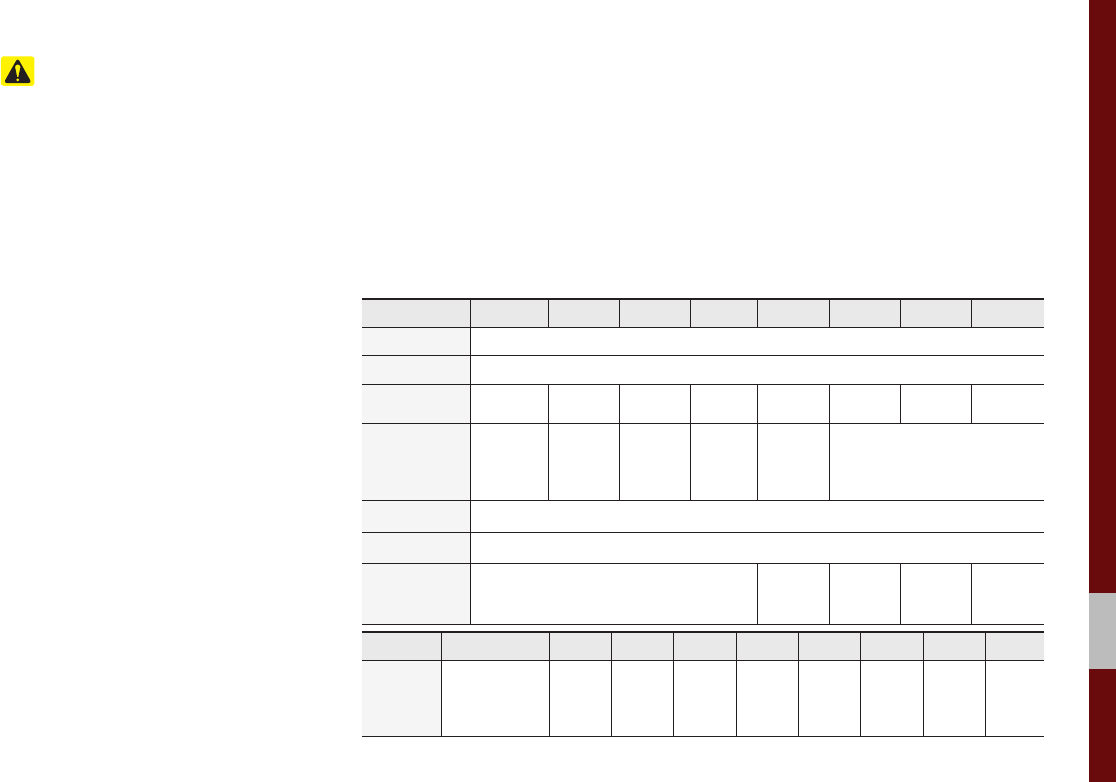
iPod I 2-23
02
Caution
• While using a connected iPhone/iPod
Touch device, it may not operate nor-
mally if the user changed some func-
tions in the device.
• When calling with an iPhone connec-
tion, song may stop playing due to an
Apple device feature. If sound does
not resume after the call is terminated,
check the device status.
• If lots of songs have the same informa-
tion, skipping may occur when previous/
next song is executed due to an Apple
device feature. Also problems may
occur depending on device type or iOS
version.
• If lots of songs have the same informa-
tion, the song that plays may be differ-
ent between the system and the Apple
device. Reset the device or delete the
same songs in the Apple device using
iTunes.
• If you control pause, repeat, shuffle, or
seek songs when the play time is less
than 3s before the song is finished play-
ing, it may occur difference of playing
song between the Multimedia system
and Apple device. Access to iPod music
from another mode or pause a song and
then play a song again in Apple device.
• We recommend that your Apple device
uses the latest firmware since some
problems may occur due to an outdated
firmware or other software related
issues.
Type 1G 2G 3G 4G 5G 6G 6.5G 7G
iPod Mini Not Supported
iPod Shuffle Not Supported
iPod Nano ○ ○ ○○○ ○Not
released ○
iPod Touch
○
(iOS 1.1
not sup-
ported)
○ ○○○ Not released
iPad ○ (Unable to charge, Not verified, Normal working not guaranteed)
iPad Mini ○ (Unable to charge, Not verified, Normal working not guaranteed)
iPod Classic Not Supported ○
(iPod with
Video)
○
(iPod
Classic)
○
(iPod
Classic)
Not
released
Type 3G 3GS 4 4S 5 5C 5S 6 6+
iPhone
Not verified,
Normal
working not
guaranteed
○○○○○○○○

2-24 I Radio/Media
Caution
• If the iPhone/iPod Touch supports
Bluetooth, the Apple device will not be
able to use the Bluetooth function if the
device is connected through both the
USB port and via Bluetooth. Disconnect
the USB connection then use Bluetooth
Audio.
• If iPod/iPhone connected to the
Multimedia system through both USB
and AUX. iPod/iPhone keeps output
sound via AUX, thus it may occur sound
will not output in iPod mode.
• If AUX cable connected to iPod/iPhone
but not connect to the Multimedia sys-
tem, it may occur sound will not output
in iPod mode due to iPod/iPhone’s fea-
ture. Especially, if you use AUX cable
like pictures, this problem may occur.
• Disconnect AUX cable from iPod/iPhone
first, then connect to the Multimedia
system via USB. Or change settings to
“Dock” in iPod/iPhone.
• If connect to the Multimedia system
while podcast or iTunes music down-
loading to iPod/iPhone, it may occur
some problems when you select song
in the list. Reconnect iPod/iPhone to the
Multimedia system when downloading
is finished or the file deleted.
• If connect to the Multimedia system
while sync, it may occur some problems.
Try to use iPod/iPhone connection after
sync complete. (To learn more, refer to
your iPod manual)
• iPhone and iPod Touch devices are
guaranteed to work normally on iOS
9.3.2 or below. However, they may not
work normally on future iOS versions
as their operations have not yet been
tested.
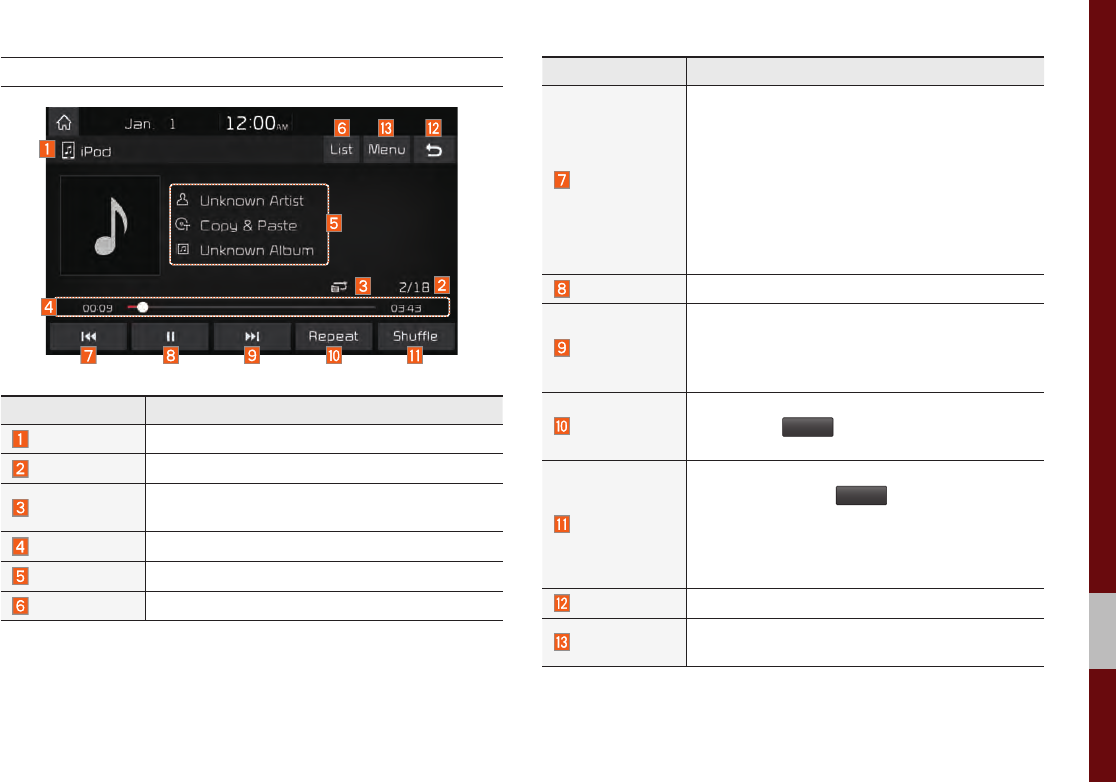
iPod I 2-25
02
iPod Mode Display Controls
Features Description
Mode Displays the current operating mode
Song Index Shows the current song/total songs
Repeat/Shuffle From Repeat/Shuffle, displays the current oper-
ating function
Play Time Displays the current play time/total play time
Song Info Displays the artist/song title/album info
List Moves to the list screen
Features Description
Previous File
If button is pressed (less than 0.8 seconds):
Moves to the previous file or play the current file
from the beginning (Depends on the play time)
• If play time is less than 3 seconds, moves to
previous file
• If play time is more than 3 seconds, play the
current file from the beginning
If button is pressed (more than 0.8 seconds): It
rewinds the track
Play/Pause Plays/pauses the current file
Next File
• If button is pressed (less than 0.8 seconds):
Moves to the next file
• If button is pressed (more than 0.8 seconds):
It fast-forwards the track
Repeat
Repeats the current file
Select the
Repeat
button to switch between
repeating 1 track, and turning repeat off
Shuffle
Plays files in random order
When selecting the
Shuffle
button, it changes to
shuffle category → deactivate shuffle then
repeat
• Shuffle Category: Shuffle song in the current
category
Back Button Move to home/previous mode screen
Menu Sound Settings: Moves to the Sound Settings
screen. You can change the settings of the sound.
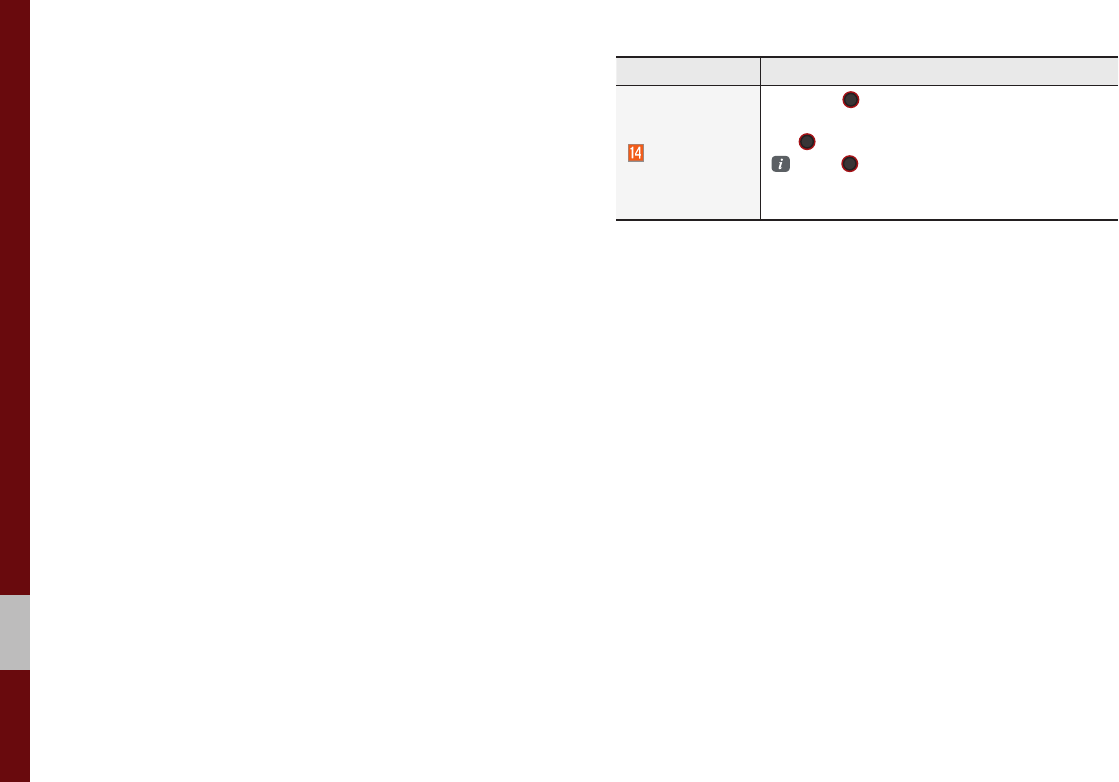
2-26 I Radio/Media
Features Description
TUNE
Turn the
TUNE
knob to search a desired
track. If the desired track is displayed, press
the
TUNE
knob to play the track.
If the
TUNE
knob is not pressed within
5 seconds of searching tracks, the track info
for the current track is restored.
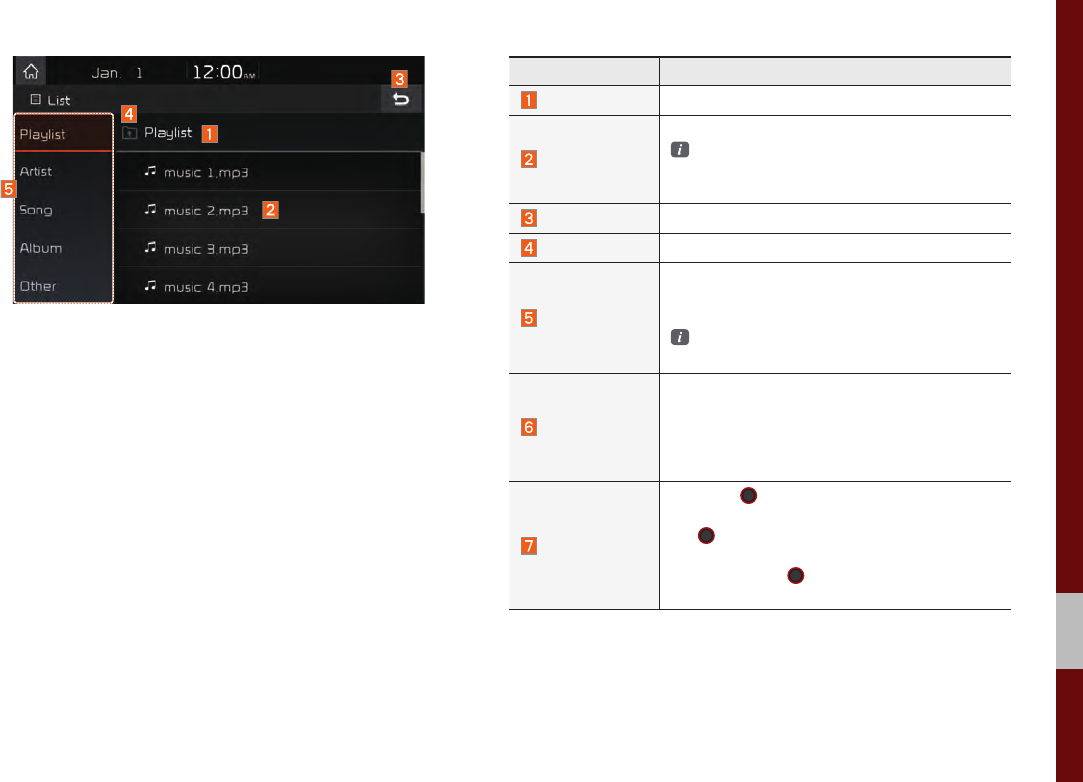
iPod I 2-27
02
Features Description
Category Name Displays the category name
Category List
Displays the contents of selected category
If there are many items in the list, items are
added in order and the scroll bar on the right
is adjusted accordingly.
Back Button Converts to basic mode screen
Upper Category Moves to Upper Category
Search Menu
Search tracks by the list type. Search songs
according to Playlist, Artist, Song, Album,
Genre, Composer, Podcast and Audiobook.
If access the search menu while playing a
track, it moves to the previous search mode.
SEEK/TRACK
• If button is pressed (less than 0.8 seconds):
Plays previous/next track.
• If button is pressed (more than 0.8 seconds):
Moves to play screen, and then it will rewind
or fast-forward the track.
TUNE
Turn the
TUNE
knob to search a desired
track. If the desired track is displayed, press
the
TUNE
knob to play the track.
If you do not anything with the knob for
5 seconds, the
TUNE
knob search will be
terminated.
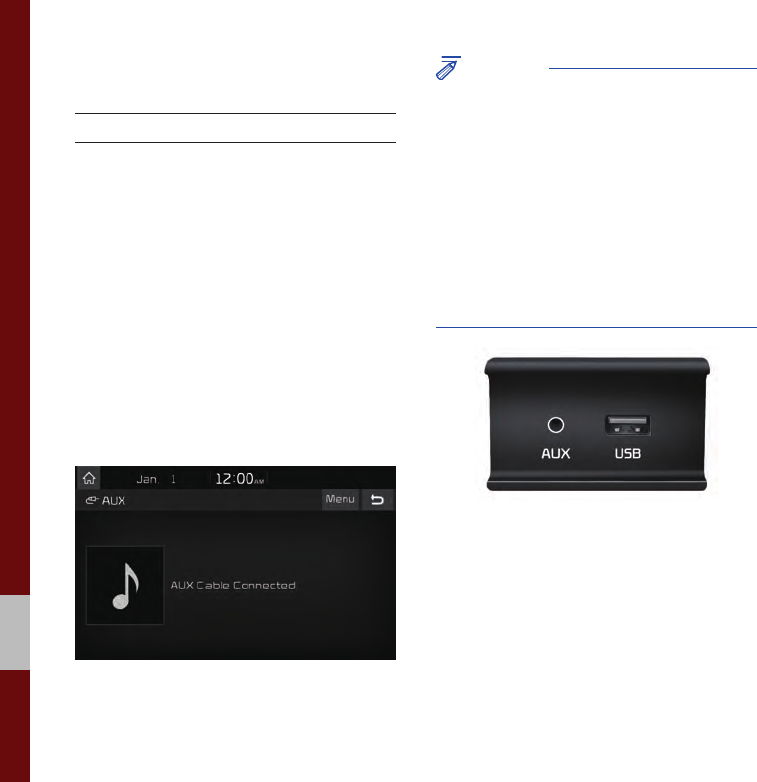
2-28 I Radio/Media
AUX
Connecting an External Device
If an external device connector is con-
nected with the AUX terminal, then AUX
mode will automatically operate. Once the
connector is disconnected, the previous
mode will be restored.
• AUX mode can be used only when an
external audio player has been con-
nected.
• The AUX volume can also be controlled
separately through the connected
device.
NOTICE
• If only a cable is connected to the AUX
without an external device, the mode will
be changed to AUX, but noise may occur.
When an external device is not being
used, remove the connector jack.
• When the external device power is
connected to the power jack, playing the
external device may output noise. In such
cases, disconnect the power connection
before use.
※ The actual feature in the vehicle may
differ from the illustration.
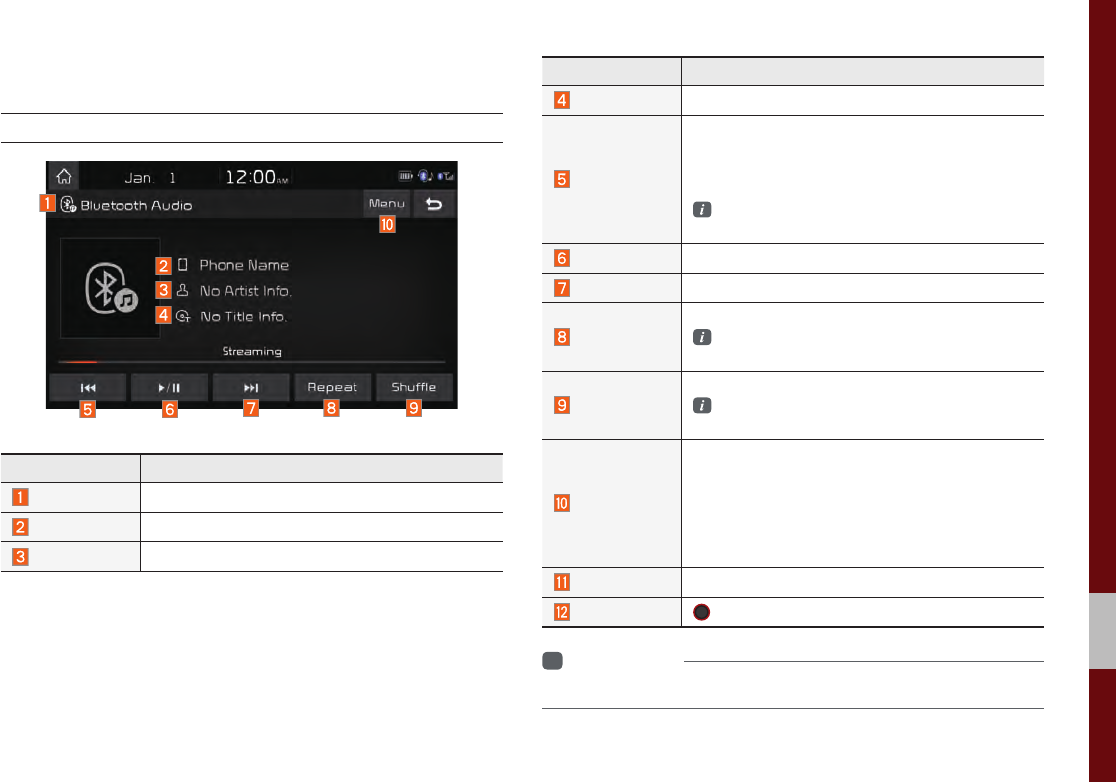
02
Bluetooth® Audio I 2-29
Bluetooth
®
Audio
Bluetooth Audio Mode Display Controls
Features Description
Mode Displays the current operating mode
Phone Name Displays name of connected phone
Artist Info Name of current artist
Features Description
Title Name of current song
Previous File
• If play time is less than 3 seconds, moves to
the previous file
• If play time is more than 3 seconds, plays the
current file from the beginning
This function may differ depending on the
model of mobile phone.
Play/Pause Plays/Pauses Bluetooth Audio
Next File Moves to the next file
Repeat
Repeats the current file.
This function may differ depending on the
model of mobile phone.
Shuffle
Plays files in random order.
This function may differ depending on the
model of mobile phone.
Menu
• Connections: Moves to the Bluetooth Settings
screen. You can pair a new device or change/
delete paired device(s).
• Sound Settings: Moves to the Sound Settings
screen. You can change the settings of the
sound.
SEEK/TRACK Plays the previous/next file
TUNE
TUNE
is not supported
i
Information
• Artist info and Title may not be supported by mobile phone
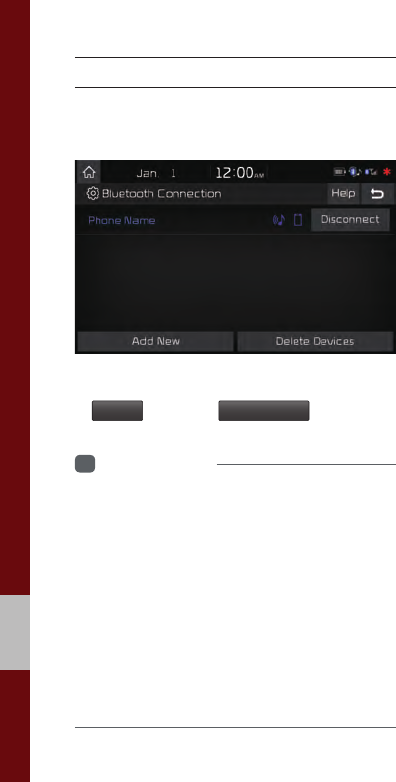
2-30 I Radio/Media
Bluetooth Connection Settings
Settings for pairing, connection and dis-
connection of a Bluetooth device.
• In Bluetooth Audio play screen, select
Menu
and then
Connections
.
i
Information
• If the music in the mobile phone is not
played after changing to audio streaming
mode, press the play button. Thus check if
the music is playing in the Bluetooth device
after changing to audio streaming mode.
Audio streaming may not be supported for
some mobile phones.
• Please check the Bluetooth compatibility
in below website: KIA Motors Corporation
http://www.kia.com
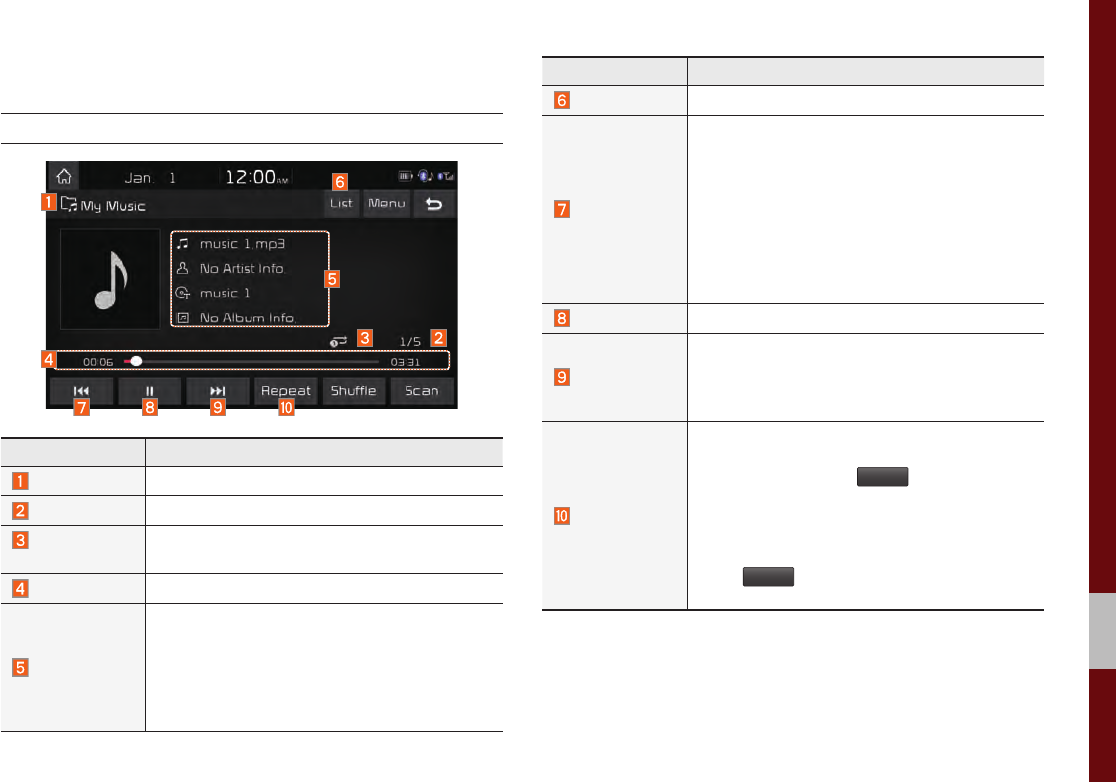
My Music I 2-31
02
My Music
My Music Mode Display Controls
Features Description
Mode Displays the current operating mode
File Index Shows the current file/total files
Repeat/
Shuffle/Scan
From Repeat/Shuffle/Scan, displays the cur-
rent operating function
Play Time Displays the current play time/total play time
Song Info
Displays the information about the current track
• When a track in the file tab on the list screen is
selected: Displays file, artist, title, album info
• When a track in the other tab on the list
screen is selected: Displays artist, title,
album info
Features Description
List Moves to the list screen
Previous File
If button is pressed (less than 0.8 seconds):
Moves to the previous file or play the current file
from the beginning (Depends on the play time)
• If play time is less than 3 seconds, moves to
previous file
• If play time is more than 3 seconds, play the
current file from the beginning
If button is pressed (more than 0.8 seconds): It
rewinds the track
Play/Pause Plays/pauses the current file
Next File
• If button is pressed (less than 0.8 seconds):
Moves to the next file
• If button is pressed (more than 0.8 seconds):
It fast-forwards the track
Repeat
Repeats the current file
• If select the song in the file tab on the list
screen: Select the
Repeat
button to switch
between repeating one song and turning
repeat off.
• If select the song in the other tabs (Playlist,
Artist, Song, Album) on the list screen: Select
the
Repeat
button to switch between repeat-
ing one song and turning repeat off
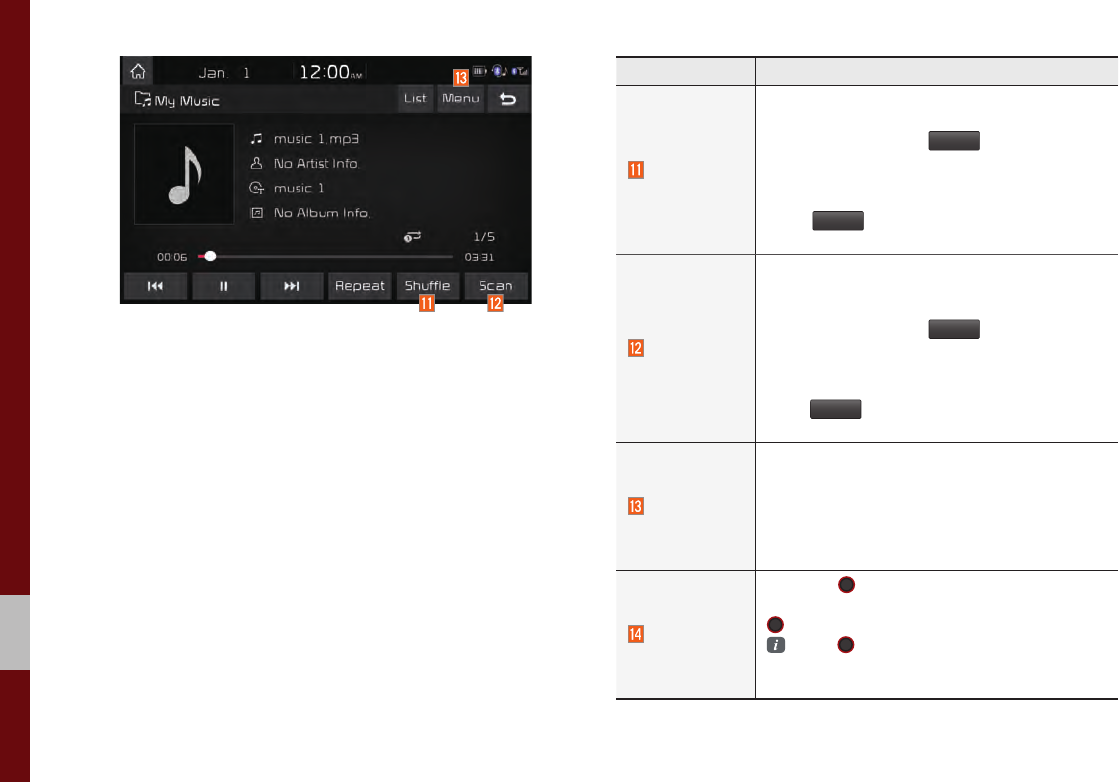
2-32 I Radio/Media
Features Description
Shuffle
Plays files in random order
• If select the song in the file tab on the list
screen: Select the
Shuffle
button to switch
between shuffle and turning shuffle off
• If select the song in the other tabs (Playlist,
Artist, Song, Album) on the list screen: Select
the
Shuffle
button to switch between shuffle
and turning shuffle off
Scan
Scans the beginning parts of files (approx. 10
seconds per file)
• If select the song in the file tab on the list
screen: Select the
Scan
button to switch
between scan and turning scan off
• If select the song in the other tabs (Playlist,
Artist, Song, Album) on the list screen: Select
the
Scan
button to switch between scan and
turning scan off
Menu
• Add to Playlist: Adds the current song to the
Playlist: Playlist is placed on the left tab in the list
• Delete Current File: Deletes the current track
from My Music.
• Sound Settings: Moves to the Sound Settings
screen. You can change the settings of the sound.
TUNE
Turn the
TUNE
knob to search a desired
track. If the desired track is displayed, press the
TUNE
knob to play the track.
If the
TUNE
knob is not pressed within
5 seconds of searching tracks, the track info
for the current track is restored.
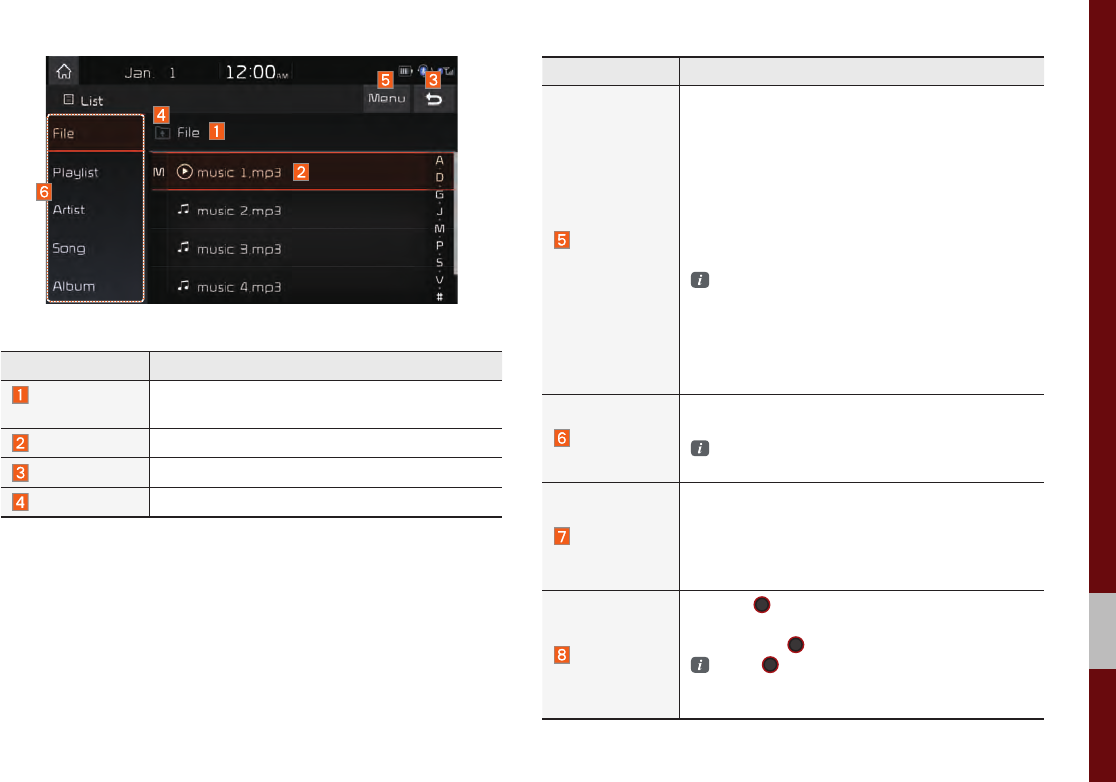
My Music I 2-33
02
Features Description
Folder/
Category Name Displays folder/category name in the list
Current Song Displays the current playing file name
Back Button Converts to basic mode screen
Upper Folder Moves to Root Folder
Features Description
Menu
• Add to Playlist: Adds the current track to the
Playlist: Playlist is placed on the left tab in the
list (Maximum 100 files) Select a track and
press “Add to Playlist” to add the track in the
playlist
• Delete from Playlist: Select a track from the
playlist and press “Delete from Playlist” to
delete the track in the playlist
•Delete Files: Deletes files from My Music
If delete file from My Music, the information
related to song also deleted in the list.
• Now Playing: When moving to a different list
screen, moves to the list page where the cur-
rent file is located (Becomes disabled when
the current list includes the current file
Search Menu
Search tracks by the list type. Search songs
according to File, Playlist, Artist, Song and Album.
If access the search menu while playing a
track, it moves to the previous search mode.
SEEK/TRACK
• If button is pressed (less than 0.8 seconds):
Plays previous/next track.
• If button is pressed (more than 0.8 seconds):
Moves to play screen, and then it will rewind or
fast-forward the track.
TUNE
Turn the
TUNE
knob to move the focus to pre-
vious/next file. If the file you want to play is dis-
played, press
TUNE
knob to play the track.
If the
TUNE
knob is not pressed within
5 seconds of searching tracks, Tune search
will be terminated.

MEMO

Before Using the Bluetooth® Handsfree
Bluetooth Connection
Bluetooth Phone
part.3 Bluetooth

3-2 I Bluetooth
Before Using the
Bluetooth
®
Handsfree
What is
Bluetooth
®
Wireless Technology?
• Bluetooth® Wireless Technology refers
to a short-distance wireless network-
ing technology which uses a 2.45GHz
frequency to connect various devices
within a certain distance.
• Supported within PCs, external devices,
Bluetooth® phones, PDAs, various elec-
tronic devices, and automotive environ-
ments,
Bluetooth
®
Wireless Technology
to be transmitted at high speeds without
having to use a connector cable.
• Bluetooth® Handsfree refers to a device
which allows the user to conveniently
make phone calls with Bluetooth®
mobile phones through the Multimedia
system.
• The Bluetooth® Handsfree feature may
not be supported in some mobile phones.
For more information on mobile phone
compatibility, visit the KIA Motor website
- KIA Motors Corporation: http://www.kia.com
WARNING
- Distracted Driving
• Focus on the road while driving. The driver's
primary responsibility is in the safe and legal
operation of the vehicle. Drivers should not
use any hand held devices or other equipment
or vehicle systems that distract the driver
during vehicle operation.
• Do not stare at the multimedia screen for long
periods of time while driving. Staring at the
screen for prolonged periods of time can lead
to traffi c accidents and can result in personal
injuries.
Precautions for Safe Driving
• Bluetooth® is a feature that enables driv-
ers to make handsfree calls. Connecting
the head unit with a Bluetooth® phone
allows the user to conveniently make
calls, receive calls, and manage the
phonebook. Before using
Bluetooth
®
Wireless Technology, carefully read the
contents of this user’s manual.
• Excessive use or operations while driv-
ing may lead to negligent driving prac-
tices and be the cause of accidents. Do
not operate the device excessively while
driving.
••Viewing the screen for prolonged peri-Viewing the screen for prolonged peri-
ods of time is dangerous and may leadods of time is dangerous and may lead
to accidents. When driving, view theto accidents. When driving, view the
screen only for short periods of time.screen only for short periods of time.
Bluetooth

03
Before Using the Bluetooth® Handsfree I 3-3
CAUTIONS upon Connecting
Bluetooth® Phone
• Before connecting the head unit with the
mobile phone, check to see that the mobile
phone supports Bluetooth® features.
• Even if the phone supports
Bluetooth
®
Wireless Technology, the phone will
not be found during device searches if
the phone has been set to hidden state
or the Bluetooth® power is turned off.
Disable the hidden state or turn on the
Bluetooth® power prior to searching/
connecting with the head unit.
• If Auto Connection is used, the
Bluetooth® phone is automatically con-
nected when the ignition is turned on,
making it unnecessary to have to con-
nect the phone with the head unit every
time.
• If you do not want automatic connection
with your Bluetooth® device, turn the
Bluetooth® feature off of the Bluetooth®
device.
• Park the vehicle when connecting the
head unit with the mobile phone.
• Bluetooth® connection may become
intermittently disconnected in some
mobile phones. Follow these steps to try
again.
1. Turn the Bluetooth® function within the
mobile phone OFF/ON and try again.
2. Turn the mobile phone power OFF/
ON and try again.
3. Completely remove the mobile phone
battery, reboot, and then again.
4. Reboot the Multimedia System and
try again.
5. Delete all paired devices from both of
Phone and Head Unit sides and then
try again.
• The Handsfree call volume and quality
may differ depending on the mobile
phone.
• Pairing Bluetooth® devices and use of
other Bluetooth® features are not sup-
ported when the vehicle is in motion. For
safety, please first park your vehicle.
• If you continue having issue download-
ing your contacts to your vehicle, con-
tact your mobile phone provider.
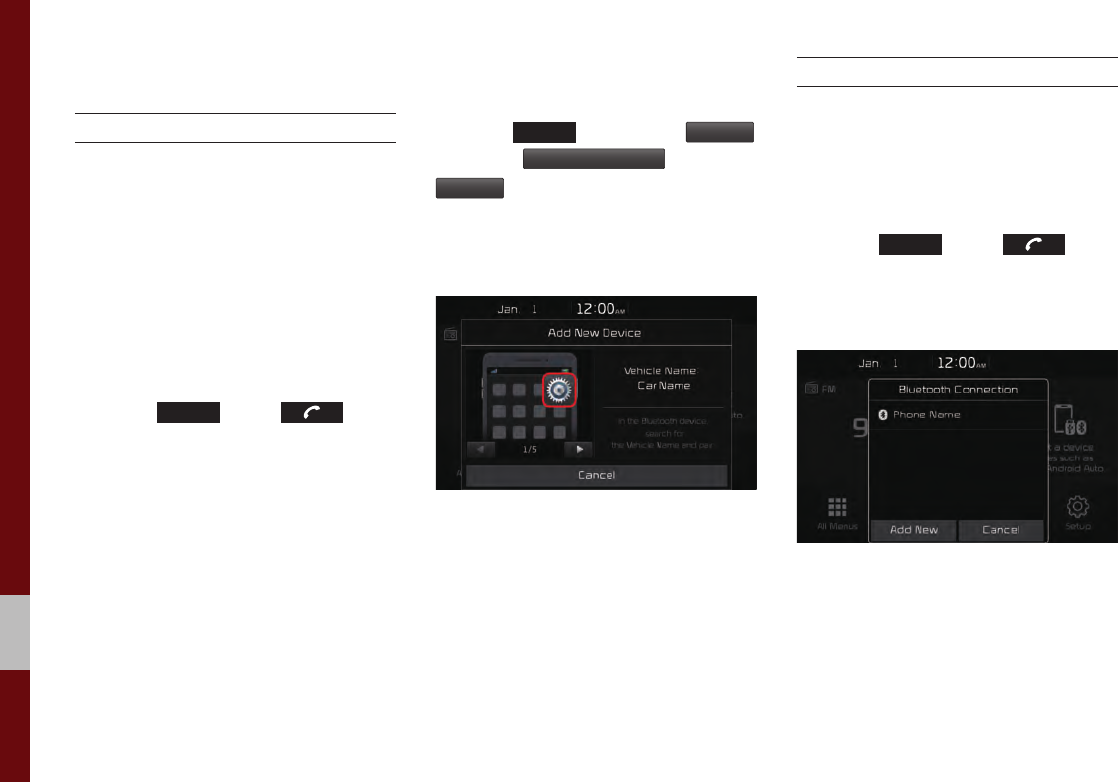
3-4 I Bluetooth
Bluetooth Connection
Pairing a New Device
Before you can use the Bluetooth feature,
you must first pair/connect your mobile
phone to your car.
Up to 5 Bluetooth devices can be paired.
Only one Bluetooth device can be con-
nected at a time.
Pairing a New Device by Selecting
Phone/Call
Press the
PHONE
key or key in
the steering wheel control. ▶ Pair your car
after your mobile phone detects the
Bluetooth device. ▶ Enter the passkey or
accept the authorization popup. ▶
Connect Bluetooth.
Pairing a New Device Through the
Phone Settings
Press the
SETUP
key. ▶ Select
Bluetooth
.
▶ Select
Bluetooth Connection
. ▶ Select
Add New
. ▶ Pair your car after your mobile
phone detects the Bluetooth device. ▶
Enter the passkey or accept the authoriza-
tion popup. ▶ Connect Bluetooth.
The default passkey is 0000.
The vehicle name above is an example.
Check the actual information on the product.
Connecting Bluetooth Devices
Connects the Bluetooth devices that you
add.
Connecting Devices by Selecting
Phone/Call
Press the
PHONE
key or key in
the steering wheel control. ▶ Select the
name of the device to connect. ▶ Connect
Bluetooth.
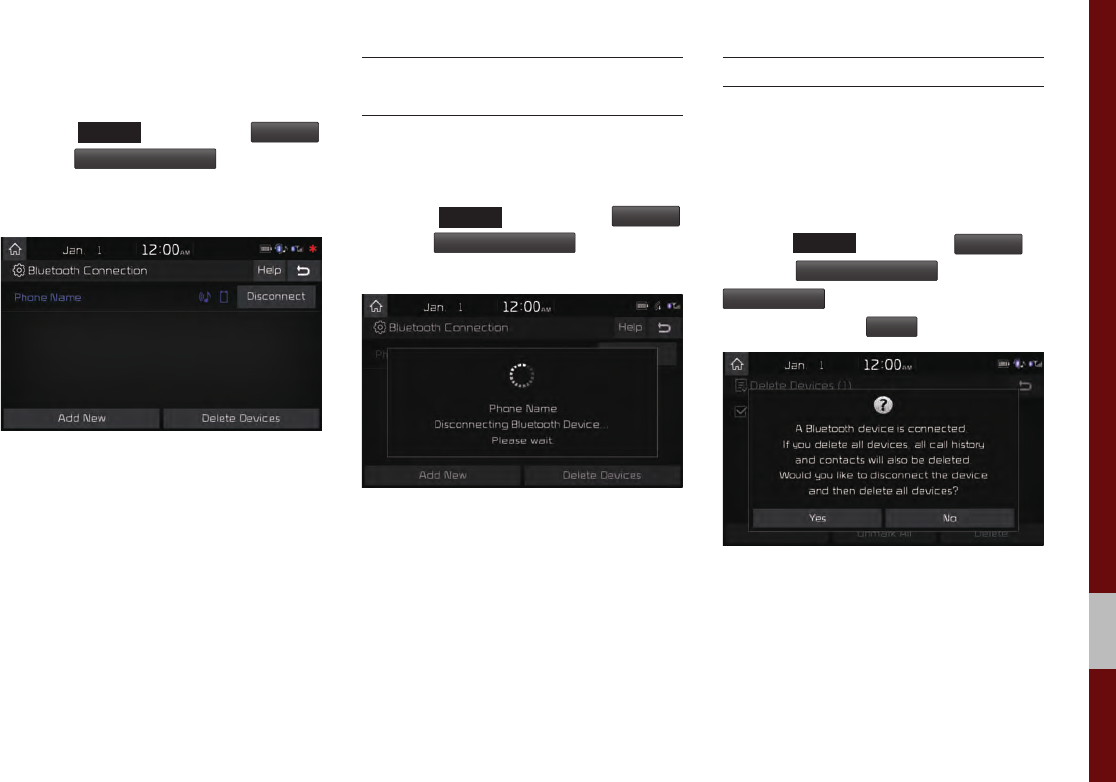
Bluetooth Connection I 3-5
03
Connecting Devices Through the
Phone Settings
Press the
SETUP
key. ▶ Select
Bluetooth
.
▶ Select
Bluetooth Connection
. ▶ Select the
name of the device to connect. ▶ Connect
Bluetooth.
Disconnecting
Bluetooth Devices
Disconnects Bluetooth devices that are
connected.
Press the
SETUP
key. ▶ Select
Bluetooth
.
▶ Select
Bluetooth Connection
. ▶ Select the
name of the device to disconnect.
Deleting Bluetooth Devices
Deletes the Bluetooth devices that you
added. Note that deleting a Bluetooth
device will delete all Call History and
Contact Info downloaded along with it.
Press the
SETUP
key. ▶ Select
Bluetooth
. ▶
Select
Bluetooth Connection
. ▶ Select
Delete Devices
. ▶ Select the device name
to delete. ▶ Select
Delete
.
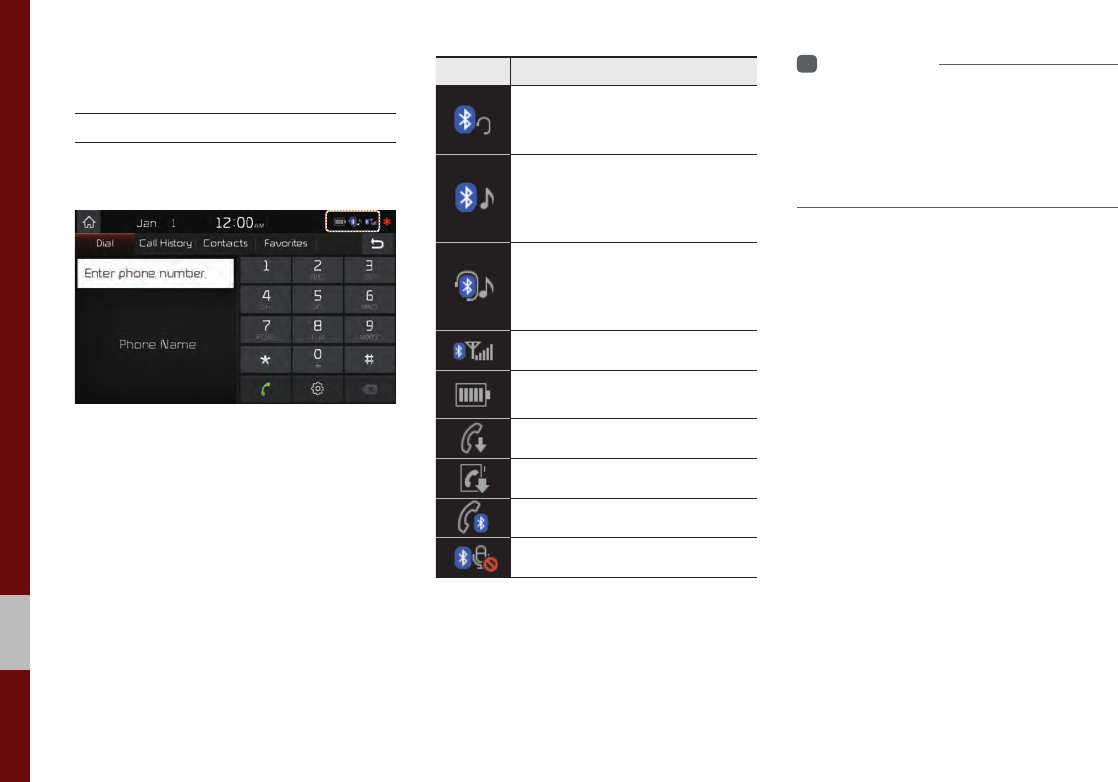
3-6 I Bluetooth
Bluetooth Phone
Phone Status Icons
Shows the current phone status in the
right top of the display.
Icons Description
You can use Bluetooth phones
when a Bluetooth Hands-free
connection is established.
You can use Bluetooth audio
features when a Bluetooth
audio connection is estab-
lished.
You can use Bluetooth phones
and audio features when both
Bluetooth Hands-free and audio
connections are established.
Call signal strength indicator
Battery level of the Bluetooth
devices connected
Downloading Call History list
Downloading Contacts
In a Bluetooth phone call
Microphone muted
i
Information
• The battery level icon and the call signal
strength indicator may not be supported in
some Bluetooth devices.
• The battery level may differ from the actual
level remaining.
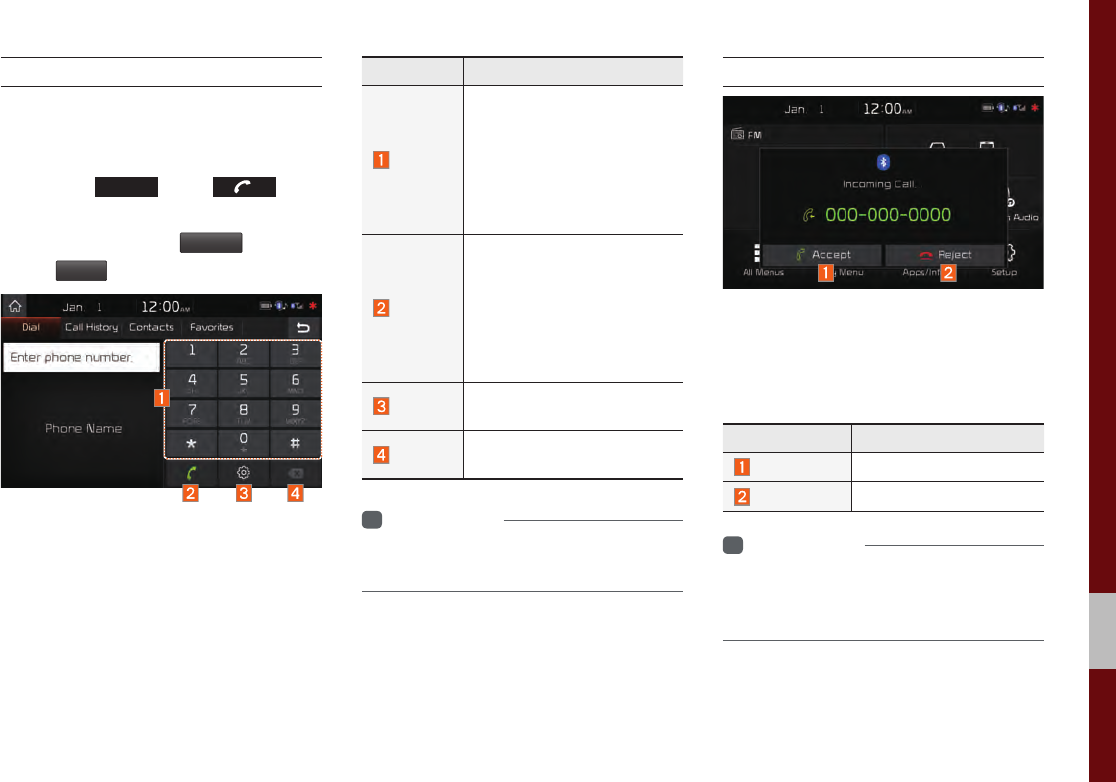
Bluetooth Phone I 3-7
03
Dial
Dials a call after the Bluetooth devices are
connected.
• Press the
PHONE
key or key in
the steering wheel control.
• You can also select
All Menus
icon, and
then
Phone
icon.
Name Description
Keypad
Use the keypad to enter
the phone number that you
want to call. Press and hold
the last number of a speed
dial to dial a number that
you added to the Speed
Dial list in the phone
Call
Makes a call after you dial
a number and select CALL.
If the number is listed in
Dialed Calls, you can select
the number and press
CALL to automatically dial
that number again.
Settings Moves to a screen of
Phone Settings.
Delete Deletes the numbers that
you entered.
i
Information
• Some types of mobile phones may not
support the Speed Dial function.
Accept/Reject Call
If there is an incoming call after you made
a Bluetooth connection, a popup message
will appear.
Name Description
Accept Answers the call.
Reject Ignores the call.
i
Information
• In some mobile phones, the caller's number
may not be displayed, and the Reject feature
may not be supported.
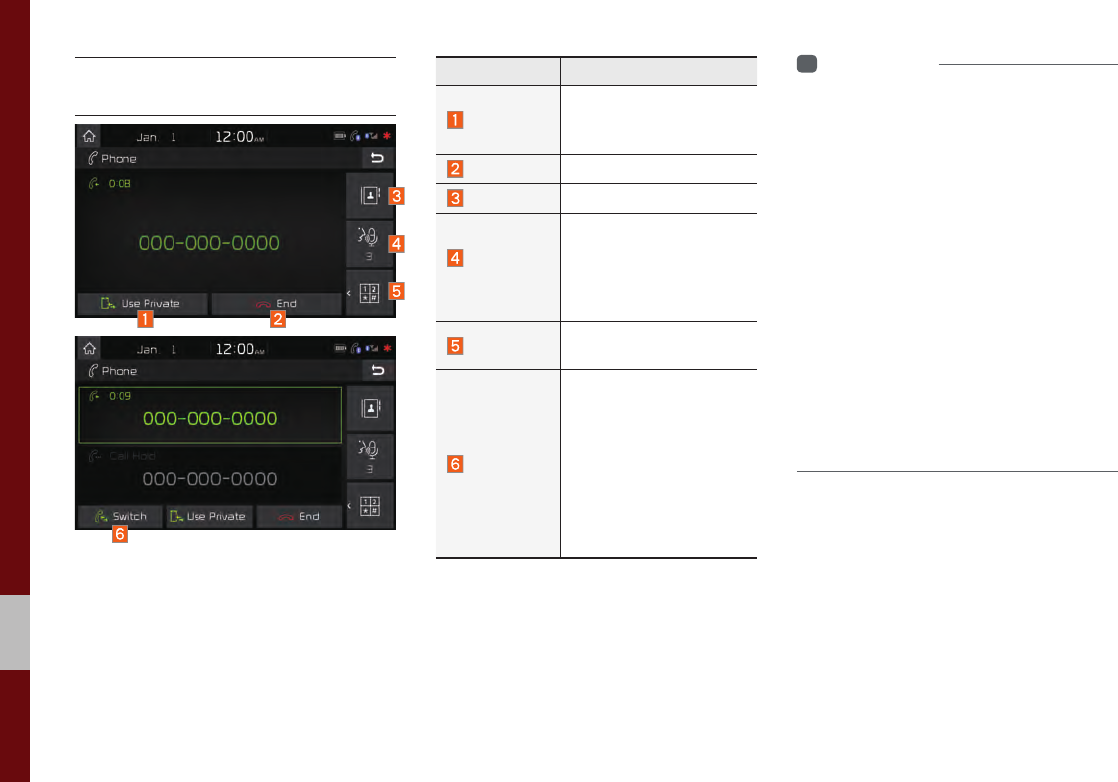
3-8 I Bluetooth
Using the Menu During
a Phone Call
When making a call, you can use the fol-
lowing menu items.
Name Description
Use Private
Switches a voice call
from the car Hands-free
to the mobile phone.
End Ends a call.
Contacts Displays the Contacts list.
Outgoing
Volume
Displays the Mic Volume
settings. You can adjust
the in-call volume that
the other party hears
(level 1 - 5).
Keypad Moves to a screen for
entering ARS numbers.
Switch
Switches to a call on
hold, if any. You can also
switch calls by select-
ing the number in the
Information Display. The
Switch function switches
the current call to a wait-
ing call in order to answer
a new incoming call.
i
Information
• If the caller's number is listed in Contacts, the
caller's name will be displayed. Otherwise,
only the number will be displayed. In some
mobile phones, the phone number may not
be displayed.
• In some Bluetooth devices, the Use Private
feature may not be supported.
• In some Bluetooth devices, the Switch feature
may not be supported.
• During a phone call on a Bluetooth Hands-
free, you cannot access other modes, such as
Radio and Settings.
• Depending on handset types, the in-call
volume the other party hears may differ. If the
other party hears your voice too low or too
loud, adjust the mic volume.
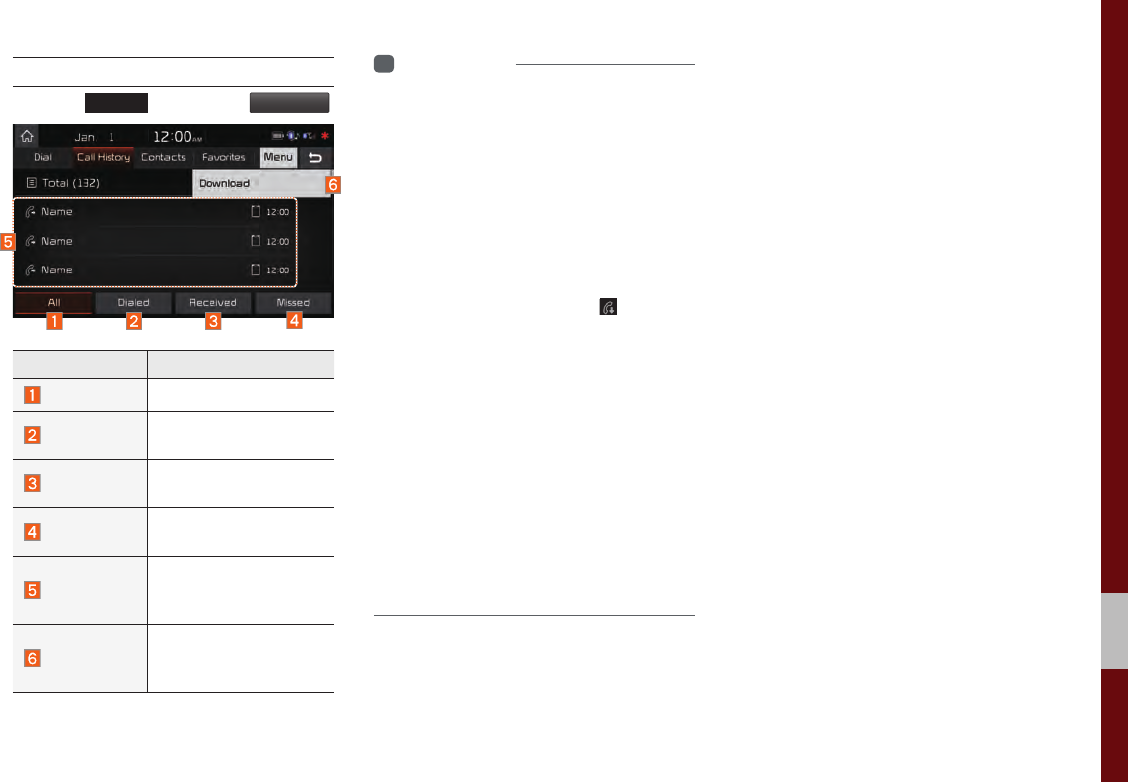
Bluetooth Phone I 3-9
03
Call History
Press the
PHONE
key, and then
Call History
.
Name Description
All Lists the all call history.
Dialed Lists the calls that you
made.
Received Lists the calls that you
have received.
Missed Lists the calls you
missed.
Call History
Displays all of your call
history. Select from the
list to dial the number.
Download
Downloads the call
history information from
your mobile phone.
i
Information
• In some mobile phones, call records may not
be added to your Call History.
• Calls from restricted ID's are not added to
your Call History Information.
• Up to 50 calls can be added in each Dialed
Calls/Received Calls/Missed Calls list.
• The durations of each dialed/received call are
not displayed in your car's Call History list.
• While the call history download is in progress,
the status bar displays an icon ( ).
• If the call history download is turned off on the
Bluetooth device, the call history download
will fail.
• Some devices require a device authentication
for downloading your call history. If download
fails, check if the Bluetooth settings or display
status are normal.
• Some devices do not support call history
download. Check if your Bluetooth device
supports download feature. For details regarding
Bluetooth-supported devices and their functional
compatibility, visit http://www. kia.com
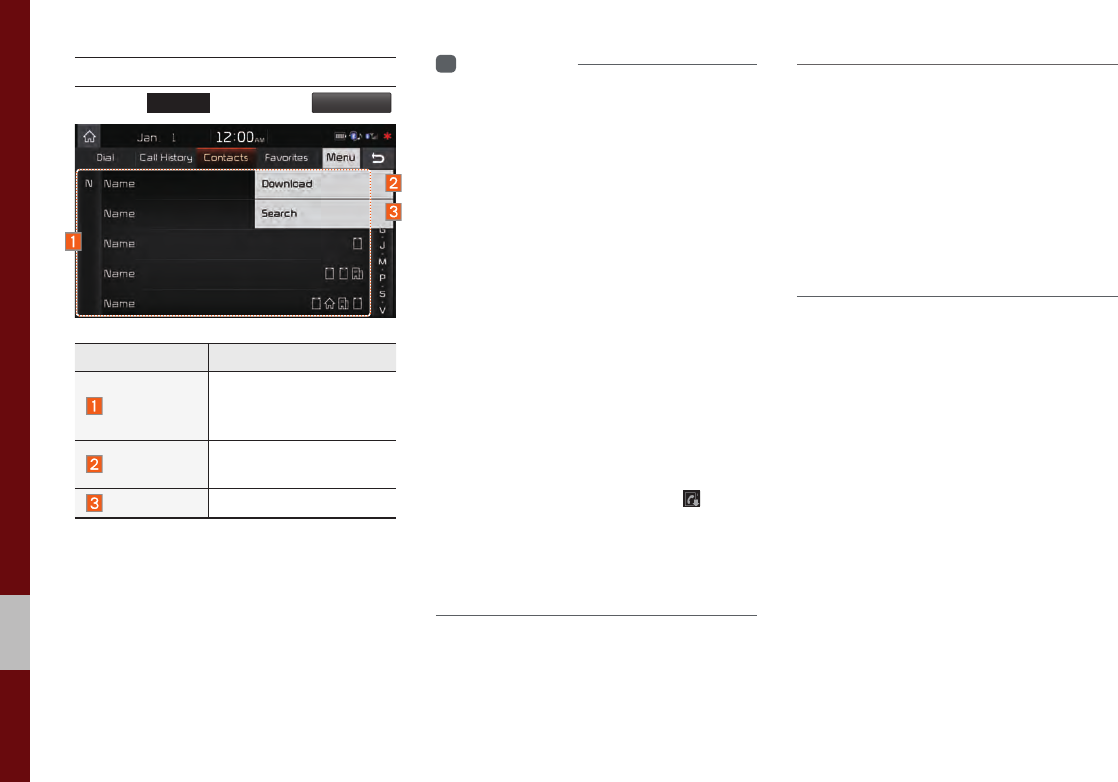
3-10 I Bluetooth
Contacts
Press the
PHONE
key, and then
Contacts
.
Name Description
Contacts List
The list of Contacts.
Select from the list to
dial the number.
Download Downloads contacts
from your mobile phone.
Search Searches Contacts.
i
Information
• Up to 5000 phone numbers can be
downloaded from a single, paired Bluetooth
device.
• You cannot edit or delete downloaded phone
numbers from your car.
• Contacts can be viewed only when the
Bluetooth device is connected.
• Even if the Bluetooth device is disconnected,
the downloaded data will remain. (Note that
deleting a paired phone will also delete all
downloaded Contacts and Call History data)
• Downloaded phone numbers may be lost
depending on the condition of the head unit.
Keep your important data in a safe place.
• Contacts from both the SIM card and your
mobile phone are downloaded at the same
time by default.
• The status bar displays a ( ) while
downloading contacts.
• The download will not be available if the
contacts download function is turned off on
your Bluetooth device.
• Some devices require a device authentication
for downloading your contacts. If download
fails, check your phone screen and confirm
the download if necessary.
• Some devices do not support contacts
download feature. Check if your Bluetooth
device supports contacts download. For
Bluetooth supporting devices details and
compatibility, visit http://www.kia.com
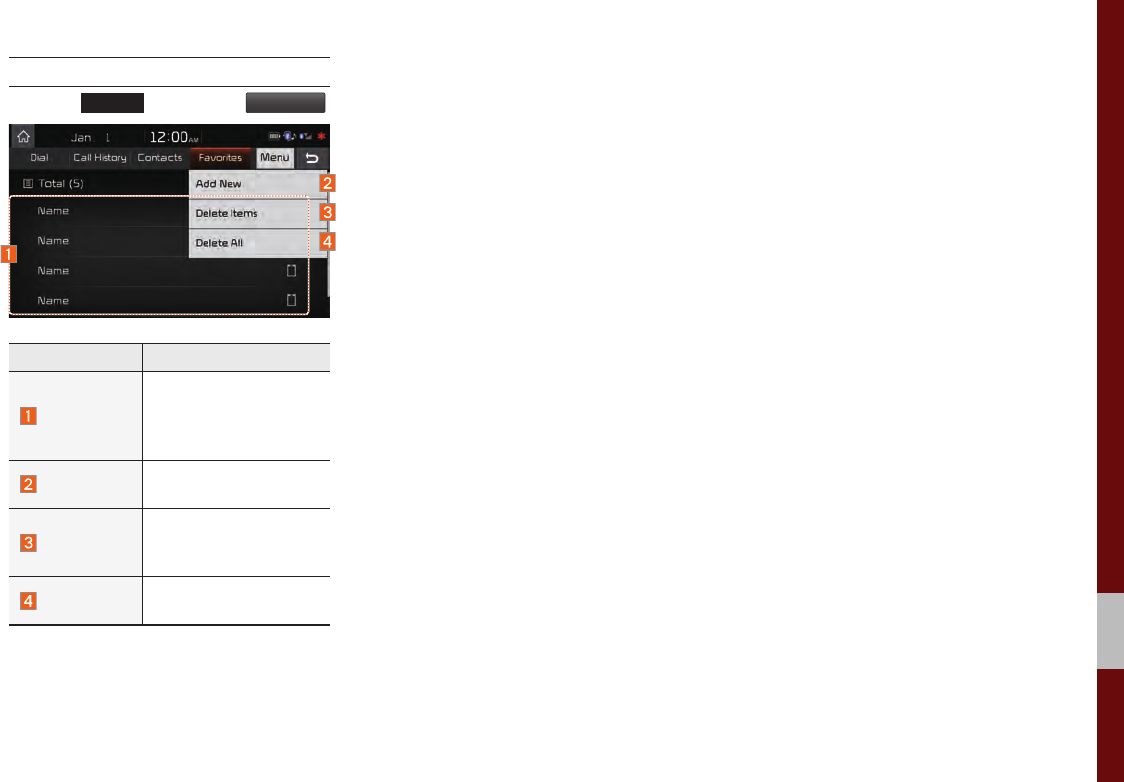
Bluetooth Phone I 3-11
03
Favorites
Press the
PHONE
key, and then
Favorites
.
Name Description
Favorites
Lists the phone num-
bers saved as Favorites.
Select from the list to
dial the number.
Add New Adds a new number to
Favorites.
Delete Items
Deletes numbers
that you select from
Favorites.
Delete All Deletes all of the num-
bers from Favorites.

MEMO

The 911 Connect feature may not operate in the following situations
About UVO eServices
Before using UVO eServices
Connecting Bluetooth
Pair a device from Bluetooth-enabled phone
Connecting to smartphone via USB
911 Connect
Roadside Assist
Vehicle Diagnostics
My Car Zone
Parking Minder
eServices Guide
part.4 UVO eServices

4-2 I UVO eServices
UVO eServices
The 911 Connect feature may not
operate in the following situations
When the vehicle ignition is not turned on.
When the phone Bluetooth® feature is set to off.
When the phone Bluetooth® cannot be connected or becomes
disconnected.
When there are no phones paired with the vehicle.
When cellular service is unavailable.
When the power turns off due to phone power (battery) issues.
When a Bluetooth® device without phone feature support has
been connected, such as an MP3 device.
When the system is booting.
When the system power supply is unstable.
When the attempted call is blocked due to user operations.
When the 9-1-1 call is unstable due to phone or other commu-
nication network issues.
When the call feature is not operating due to phone settings set
by the user.
When the phone cannot be controlled via Bluetooth® due to
phone specifications or characteristics.
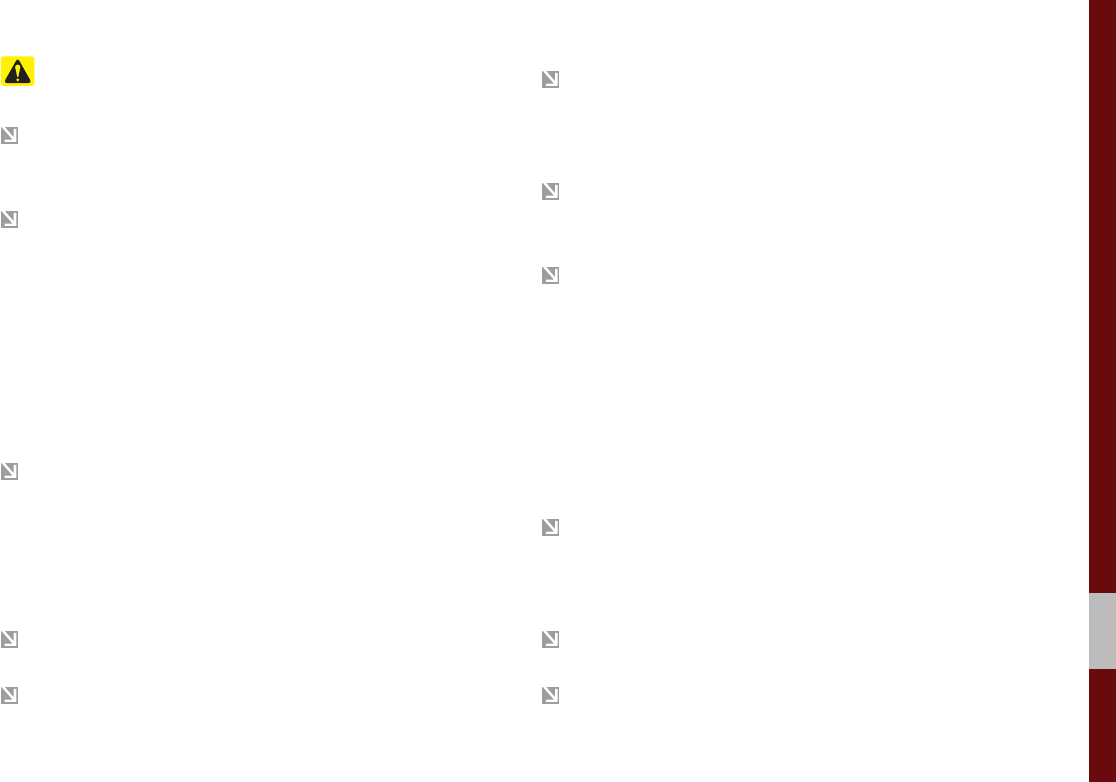
Using UVO eServices and Precautions I 4-3
04
Using UVO eServices and Precautions
Download the UVO eServices App and install it on your smartphone.
The app can be downloaded from your smartphone’s app store.
For using UVO eServices call features such as 911 Connect,
Roadside Assist and eServices Guide, a smartphone must be
connected with the vehicle via Bluetooth. Pair and connect your
smartphone with the vehicle. For information on connecting
your Bluetooth device, refer to the smartphone user’s manual
and instructions on the Phone Help screen on your radio. Up to
five Bluetooth devices can be paired to the vehicle and only
one device can be connected at a time.
For using data communication of Vehicle Diagnostics, Parking
Minder, and My Car Zone, smartphone must be connected with
the vehicle via USB cable.
※
The use of genuine cable is recommended. (The use of
other products may result in abnormal or non-proper operation.)
Login and activate the UVO eServices App on your smartphone.
Some UVO eServices features will only be available when your
smartphone is connected with the vehicle via USB and the
UVO eServices App is running.
UVO eServices may not operate properly with incompatible
smartphones. To view the list of compatible smartphones,
please visit MyUVO.com
Communication between the vehicle and smartphone app may
temporarily disconnect depending on the phone state.
If the feature is not operating properly, you may need to reset
the UVO eServices App or the smartphone and try again
according to the following steps.
1. Try feature again in the Head Unit
2. Restart smartphone app
3. Re-connect Bluetooth and USB cable
4. Reset smartphone
5. Delete Device and pair again
Some services use the customer’s mobile phone data plan for
data communication. Therefore, the features will function in
accordance with the cellular plan.
Use of the most up-to-date app version is recommended.
For smartphone related inquiries, please visit MyUVO.com.
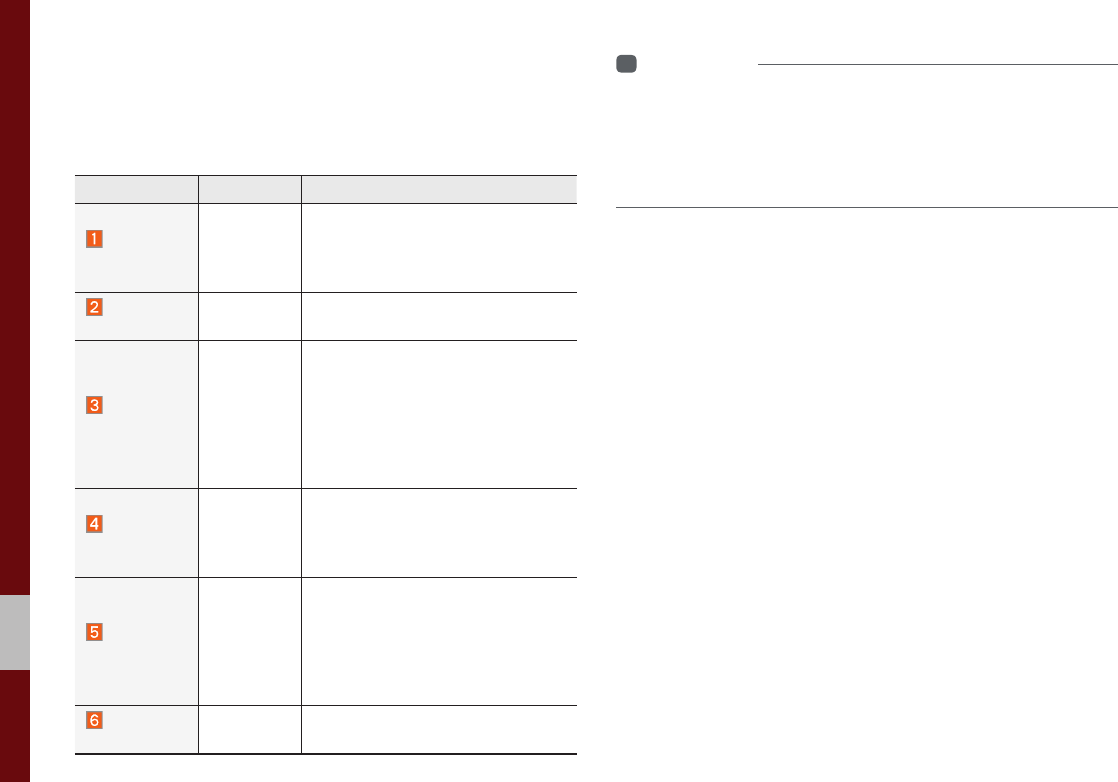
4-4 I UVO eServices
About UVO eServices
UVO eServices provides the following features through Bluetooth
and/or USB connection to your smartphone.
Name Connection Description
911
Connect BT
If an airbag deploys, your vehicle
automatically initiates a call to 9-1-1
and sends your vehicle’s location
information to the 9-1-1 operator.
Roadside
Assist BT & USB If a diagnostic issue exists, you can
connect with a Roadside Assist.
Vehicle
Diagnostics USB
Informs you if there is a diagnostic
issue found in your vehicle. If an
issue is found, you can contact a
call center through Roadside Assist
or reserve an appointment with
your preferred Kia dealer through
Schedule Service.
My Car
Zone USB
Keeps track of predefined triggered
alerts such as Speed Alert and
Curfew Limit Alert from the My Car
Zone feature.
Parking
Minder USB
Saves the location of your parked
vehicle on your UVO eServices
smartphone app.
You can check where your vehicle is
parked through the UVO eServices
App on your smartphone.
eServices
Guide BT Receive guidance on how to use
UVO eServices.
i
Information
• 24-hour Roadside Assistance is a
service plan provided by Kia Motors
America, Inc. Certain limitations apply. Coverage details are available
in the Kia Warranty and Consumer Information Manual. For access
to Enhanced Roadside Assistance, a conn
ected mobile phone via
Bluetooth within the cellular service coverage area is required.
To use UVO eServices, the following conditions must be met.
1. The UVO eServices smartphone app must be installed and
you must log in using your MyUVO account credentials.
2. The smartphone must be connected via Bluetooth and USB
cable to the vehicle.
3. Once this is complete, eServices must be activated.
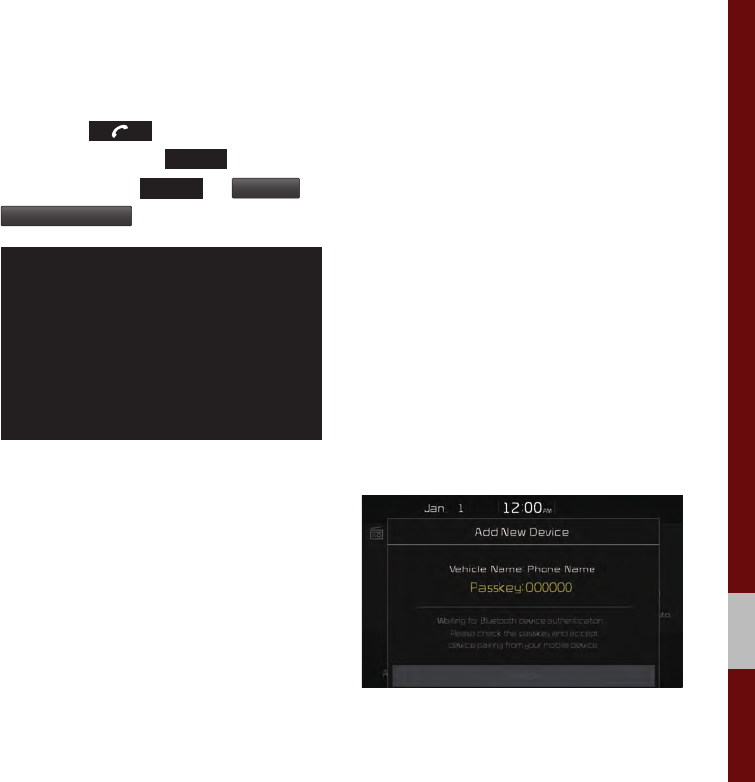
Pair a device from Bluetooth-enabled phone I 4-5
04
Before using UVO
eServices
Installing the UVO eServices App on your
smartphone
1. Download and install the UVO eSer-
vices App on your smartphone.
The app can be downloaded from the
Apple App Store or Google Play.
2. Register your vehicle and account at
MyUVO.com
Note: MyUVO.com is accessible from
your phone’s browser.
3. Start the UVO eServices App on your
smartphone and log in.
Connecting Bluetooth
Press the key on the steering
wheel or press the
PHONE
key on the
head unit. Press
SETUP
▶
Bluetooth
▶
Bluetooth Connection
.
Pair a device from
Bluetooth-enabled phone
1. Turn on the Bluetooth feature on your
smartphone’s Bluetooth settings screen.
2. Search Bluetooth devices on your
smartphone.
3. Select the Vehicle Name on the phone
that matches the name shown on the
screen.
4. Verify the passkey shown on the touch-
screen.
If the phone supports SSP, check the
passkey on your Bluetooth® device and
confirm the authentication.
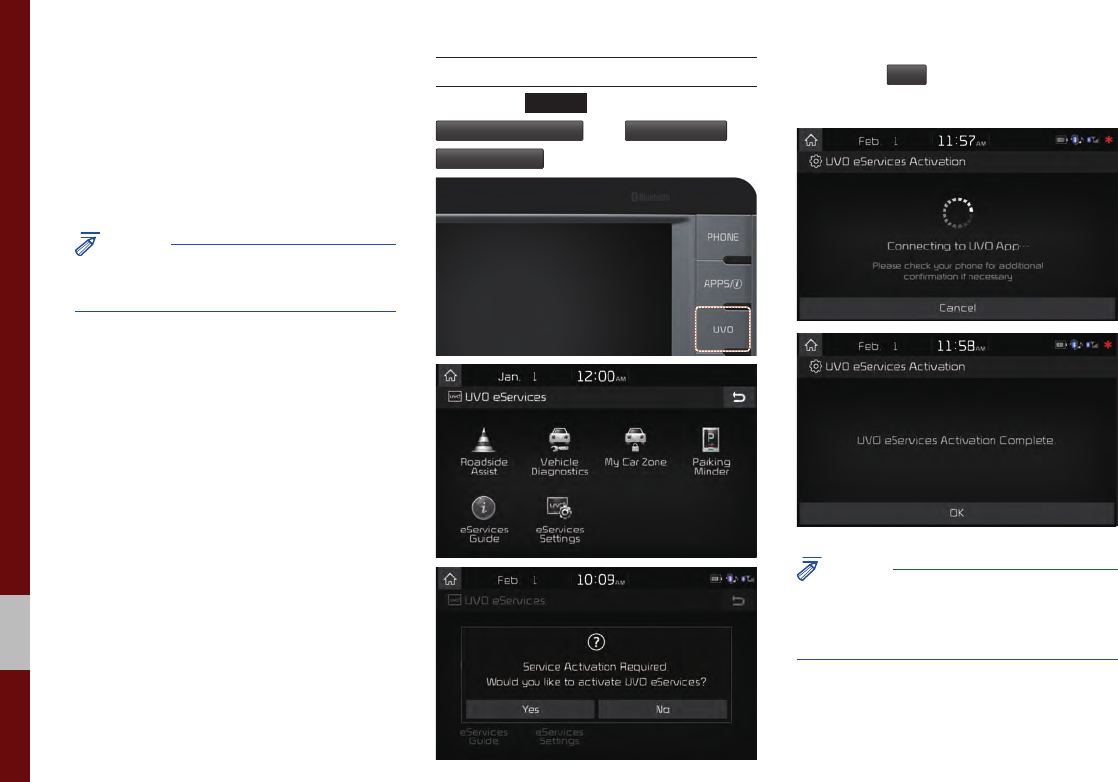
4-6 I UVO eServices
Connecting to
smartphone via USB
1. Connect your smartphone with the vehi-
cle via USB cable.
NOTICE
• For smartphone related inquiries, please visit
MyUVO.com.
Activating UVO eServices
Press the
UVO
key, then press the
Vehicle Diagnostics
or
My Car Zone
or
Parking Minder
button.
Press the
Yes
button, then the UVO
eServices activation process will begin.
NOTICE
• Before activating UVO eServices, ensure
your phone is connected to the vehicle via
USB cable.
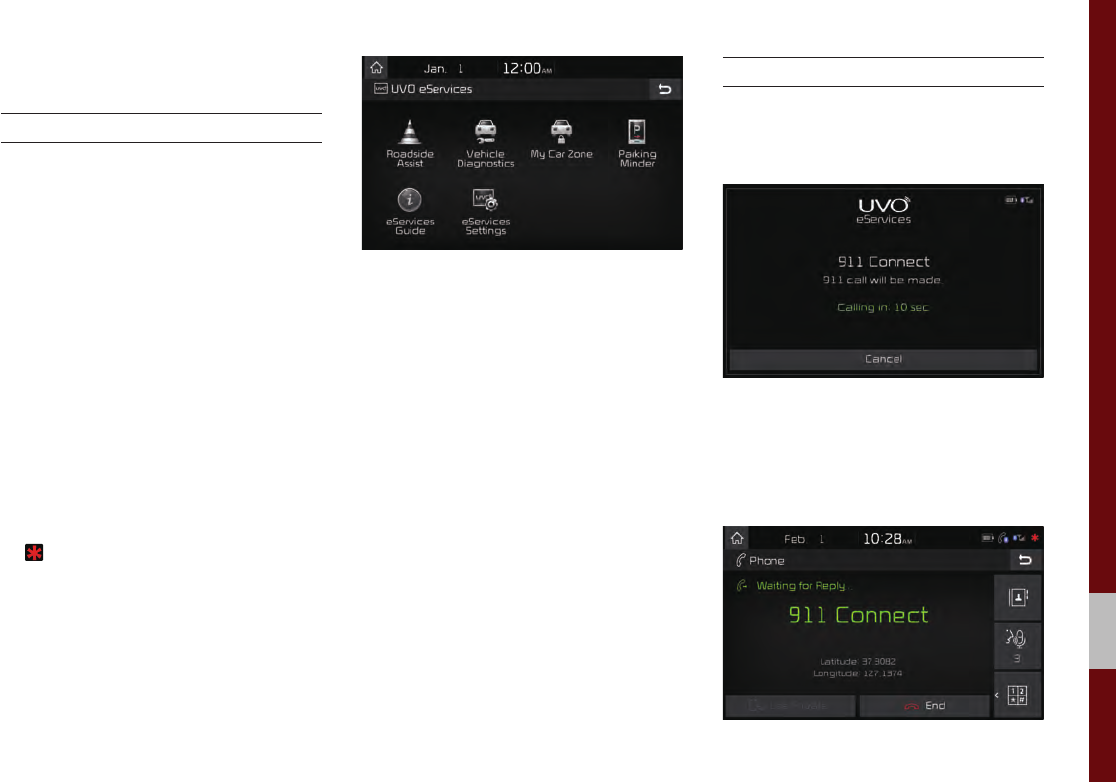
911 Connect I 4-7
04
911 Connect
911 Connect
If an airbag deploys, your vehicle automat-
ically initiates a call to 9-1-1 and sends
your vehicle’s location information to the
9-1-1 operator.
The 911 Connect feature is available only
when the mobile phone is connected via
Bluetooth.
By default, this feature is turned off. To turn
it on, you must turn it on in the eServices
Settings menu. By enabling this feature,
you are agreeing to the 911 Connect
terms of use.
A ( ) icon is displayed at the top of the
touch screen as shown below when phone
is connected to UVO eServices system via
Bluetooth and the 911 connect feature is
turned on.
Initiating a 911 Call
If an airbag deploys, the following screen
is displayed and a call is automatically
placed to 9-1-1 after 10 seconds.
Once a call is connected with a 9-1-1
operator, it is possible to request emer-
gency services to be dispatched to your
location.
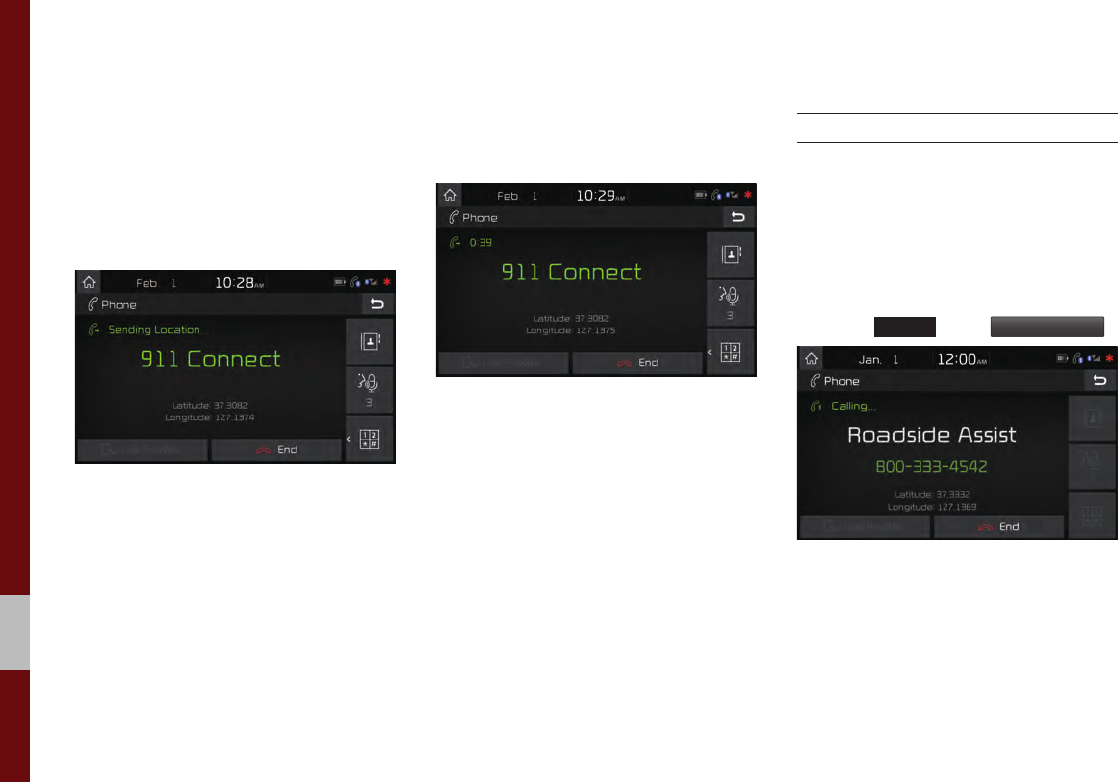
4-8 I UVO eServices
The 9-1-1 operator may request informa-
tion on the current location of your vehicle.
When the 9-1-1 operator requests your
vehicle location, “Sending Location” is
displayed on the screen and the vehicle
location is automatically sent to the 9-1-1
operator.
When the 9-1-1 operator attempts to talk
to the driver again, the call time is dis-
played and allows the driver to speak with
the 9-1-1 operator.
Roadside Assist
Roadside Assist
If there is any issues in the vehicle, you
can connect with a Roadside Assist agent.
The Roadside Assist feature can be used
only when your phone is connected via
Bluetooth.
Press the
UVO
key ▶
Roadside Assist
.
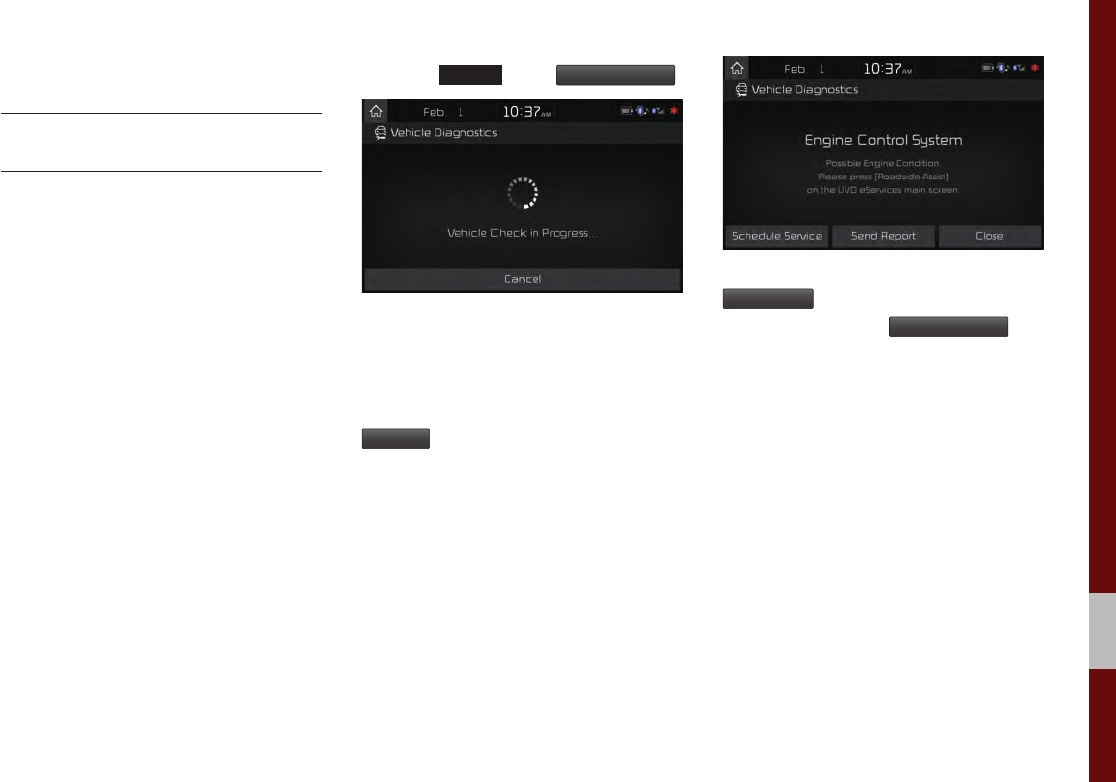
Vehicle Diagnostics I 4-9
04
Vehicle Diagnostics
Conducting Vehicle
Diagnostics
Vehicle Diagnostics is available only when
the ignition is turned on and the vehicle is
parked.
It also requires that UVO eServices is
activated, and the Phone is connected
via USB cable before starting Vehicle
Diagnostics.
Press the
UVO
key ▶
Vehicle Diagnostics
.
The Vehicle Diagnostics process will begin.
When a diagnostics check is in progress,
keep the vehicle in park with the ignition
on. To cancel diagnostics, press the
Cancel
button on the touch screen or
any hardkey.
If diagnostic issues are found, press the
Send Report
button to send to your MyUVO
account or press the
Schedule Service
but-
ton to schedule an appointment with your
preferred or nearby Kia dealer.
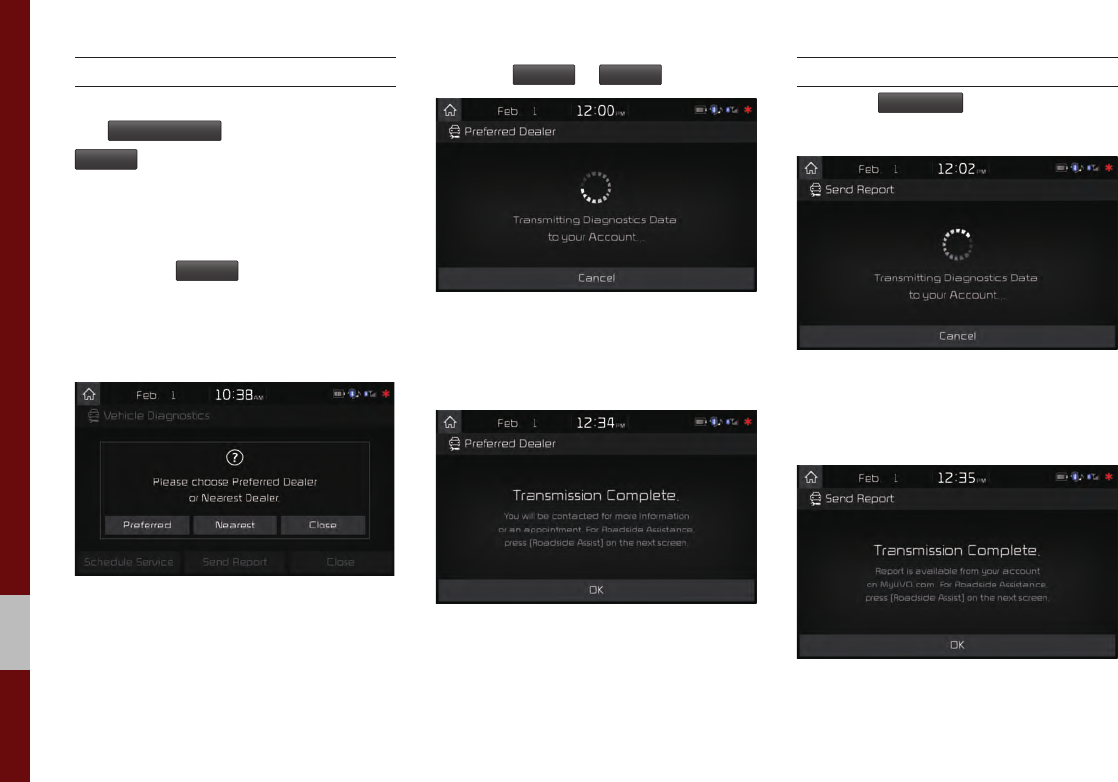
4-10 I UVO eServices
Schedule Service
When scheduling an appointment using
the
Schedule Service
button, pressing the
Preferred
button will allow you to request an
appointment with your preferred Kia dealer
and send your vehicle’s diagnostics infor-
mation.
Pressing the
Nearest
button will allow you
to request an appointment with the near-
est Kia dealer and send your vehicle’s
diagnostics information.
Press the
Preferred
or
Nearest
button.
Request an appointment with Preferred or
Nearest Kia Dealer and send your vehi-
cle’s diagnostics data.
Send Report
Press the
Send Report
in the vehicle diag-
nostics result screen.
Vehicle Diagnostics Data is transmitted to
your account and you can see the report
on MyUVO.com
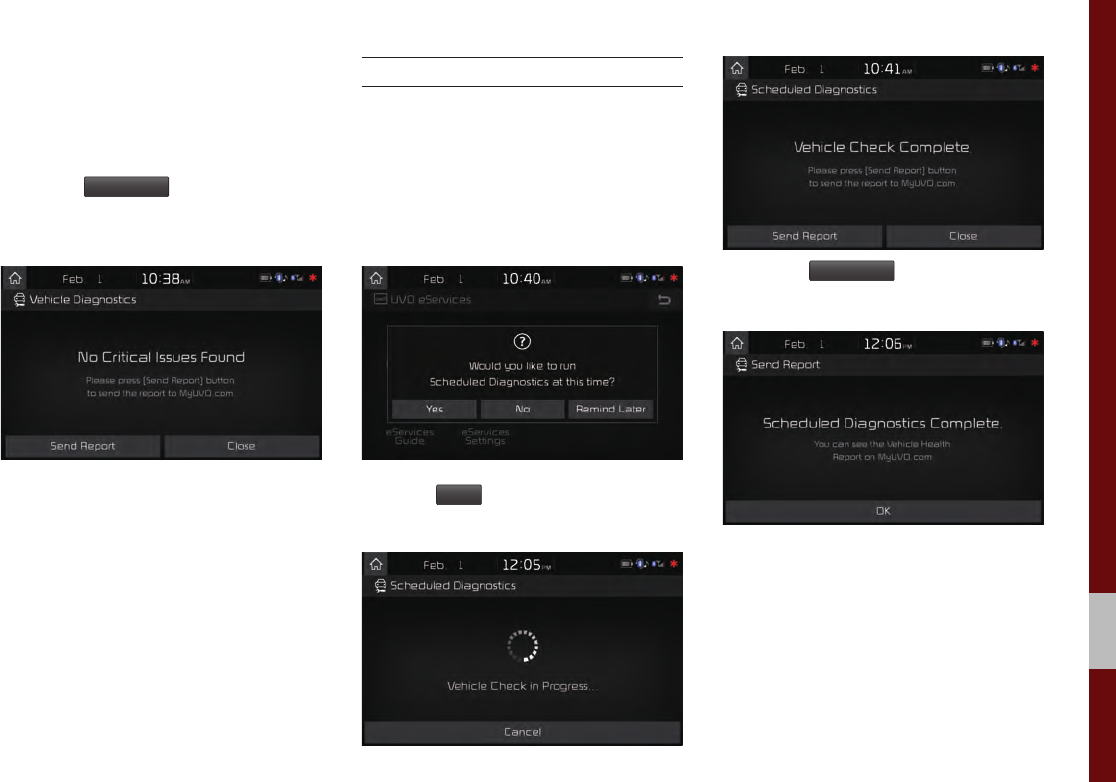
Vehicle Diagnostics I 4-11
04
Even if diagnostic issues are not found
after Vehicle Diagnostics, it is recom-
mended that you send the diagnostic
results to your MyUVO account.
Press the
Send Report
button to send the
diagnostics results to your MyUVO
account.
Scheduled Diagnostics
If you have set up Scheduled Diagnostics
on your UVO eServices App, a vehicle
diagnostics check will automatically start
on the day you selected.
On the date of the Scheduled Diagnostics,
the following window will be displayed.
Press the
Yes
button on the touch screen
to proceed with diagnostics.
Press the
Send Report
button to see the
Vehicle Health Report on MyUVO.com.
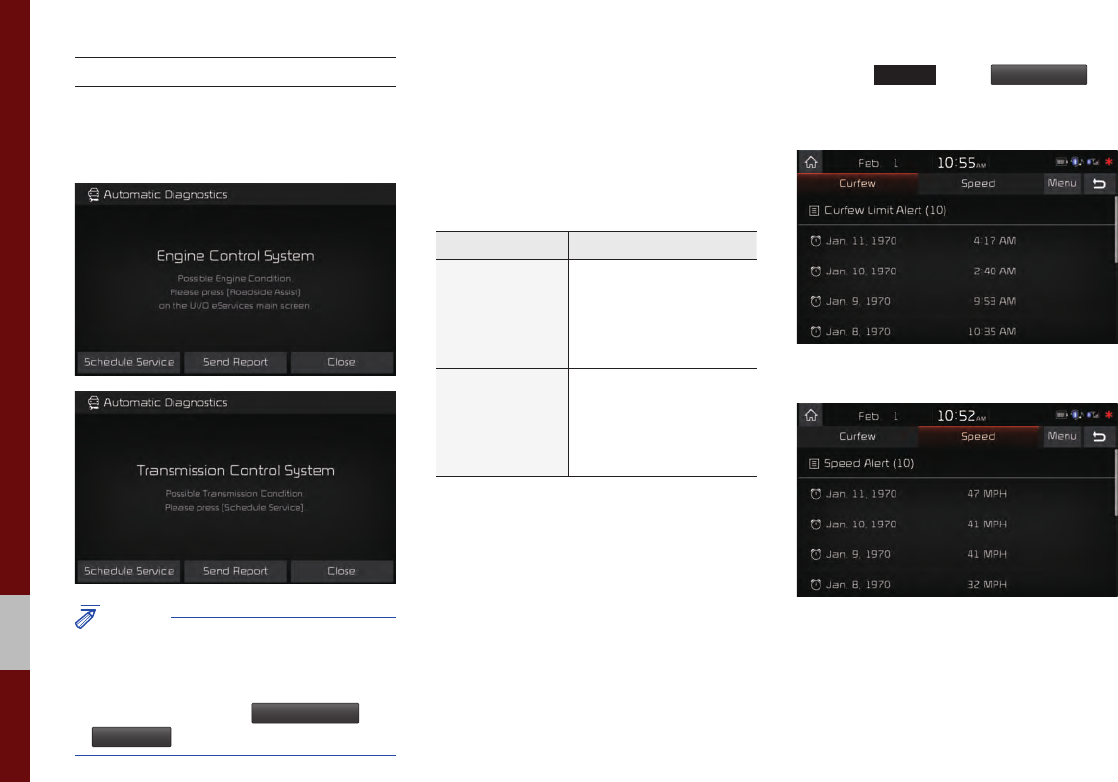
4-12 I UVO eServices
Automatic Diagnostics
If a critical diagnostics issue with your
vehicle’s powertrain is detected, Automatic
Diagnostics will be notified.
NOTICE
• The screen messages differ based on the
vehicle diagnostics severity. Ensure your
phone is connected to the system via USB
cable before using
Schedule Service
and
Send Report
.
My Car Zone
My Car Zone is a feature that provides
alerts and driving history for Curfew Limit
Alerts and Speed Alerts set by the user.
Name Description
Curfew Limit
Alert
Curfew Limit Alerts are
alerts that are triggered
when a driver is driving
within a predefined time
range.
Speed Alert
Speed Alerts are alerts
that are triggered when
a driver exceeds the
predefined maximum
speed.
My Car Zone features are supported only
when UVO eServices has been activated.
Press the
UVO
key ▶
My Car Zone
Curfew Limit Alerts History
Speed Alerts History
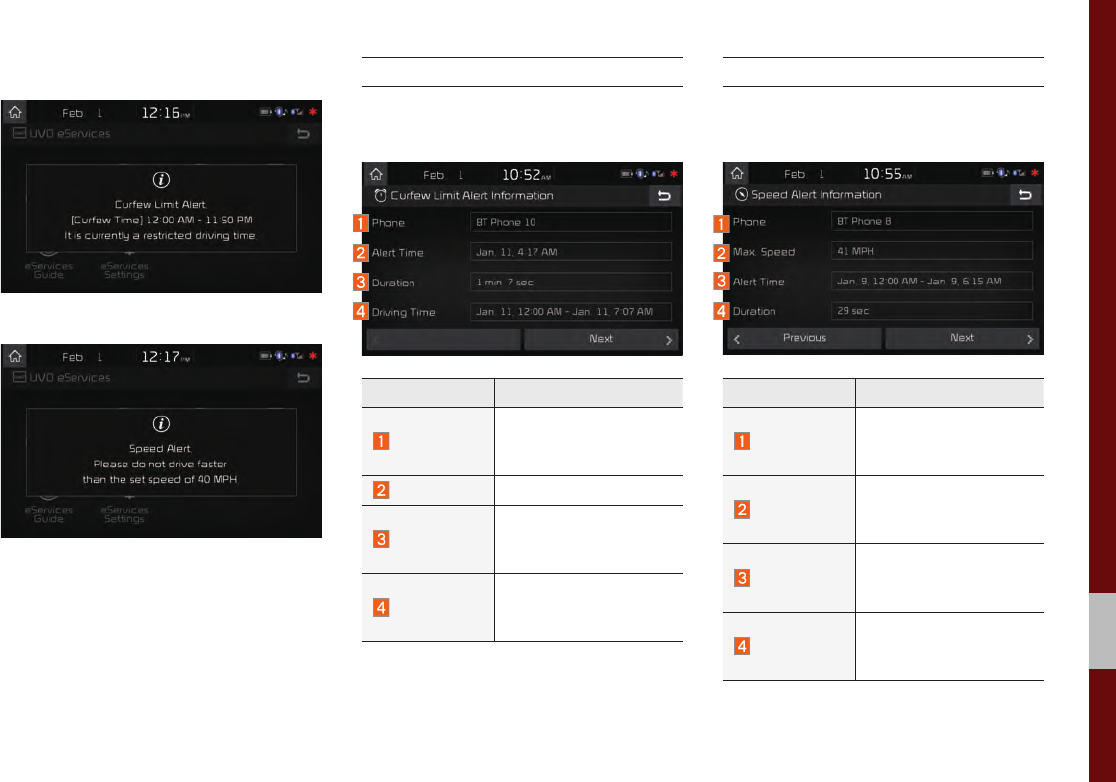
My Car Zone I 4-13
04
Curfew Limit Alert
Speed Alert
Curfew Limit Alert
You can check the Curfew Limit Alert his-
tory for a list of past triggered curfew alerts.
Name Description
Phone
Name of phone con-
nected upon triggered
curfew limit
Alert Time Initial alert time
Duration
Total duration of driving
while curfew limit was
triggered
Driving Time
Total driving time from
turning ignition on until
turning ignition off
Speed Alert
You can check the Speed Alert history for
triggered speed limit alerts of the vehicle.
Name Description
Phone
Name of phone con-
nected upon triggered
speed limit alert
Max. Speed
Maximum vehicle speed
upon triggered speed
limit alert
Alert Time
Time from first triggered
alert until last triggered
alert
Duration
Total triggered alert time
from turning ignition on
to turning ignition off
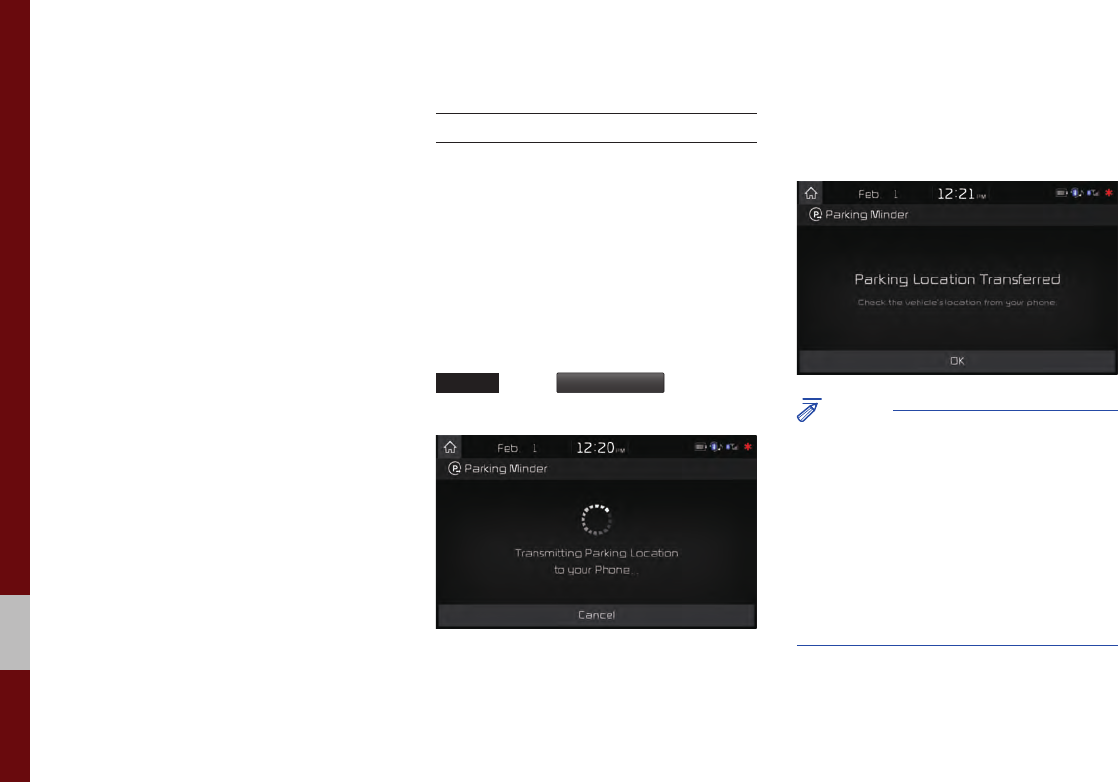
4-14 I UVO eServices
To check My Car Zone alert history from
your smartphone, you must first send the
alert history to your MyUVO account.
Parking Minder
Sending Parking Location
The location where your vehicle is currently
parked can be sent to your smartphone.
Ensure that your smartphone is connected
via USB and the UVO eServices App is
running before using this feature.
After parking the vehicle, press the
UVO
key ▶
Parking Minder
to send the
vehicle’s location to your smartphone.
Once the parking location has been sent,
you can view your vehicle’s location from
the UVO eServices App on your smart-
phone.
NOTICE
• When the parking location is being sent, do
not drive the vehicle. Ensure that you have
logged into the UVO eServices App, and your
phone is connected to the multimedia system
via USB cable.
• When ignition is turned off while the phone is
connected via USB, Parking Minder can be
transferred automatically if the option is set up
in UVO eService Settings
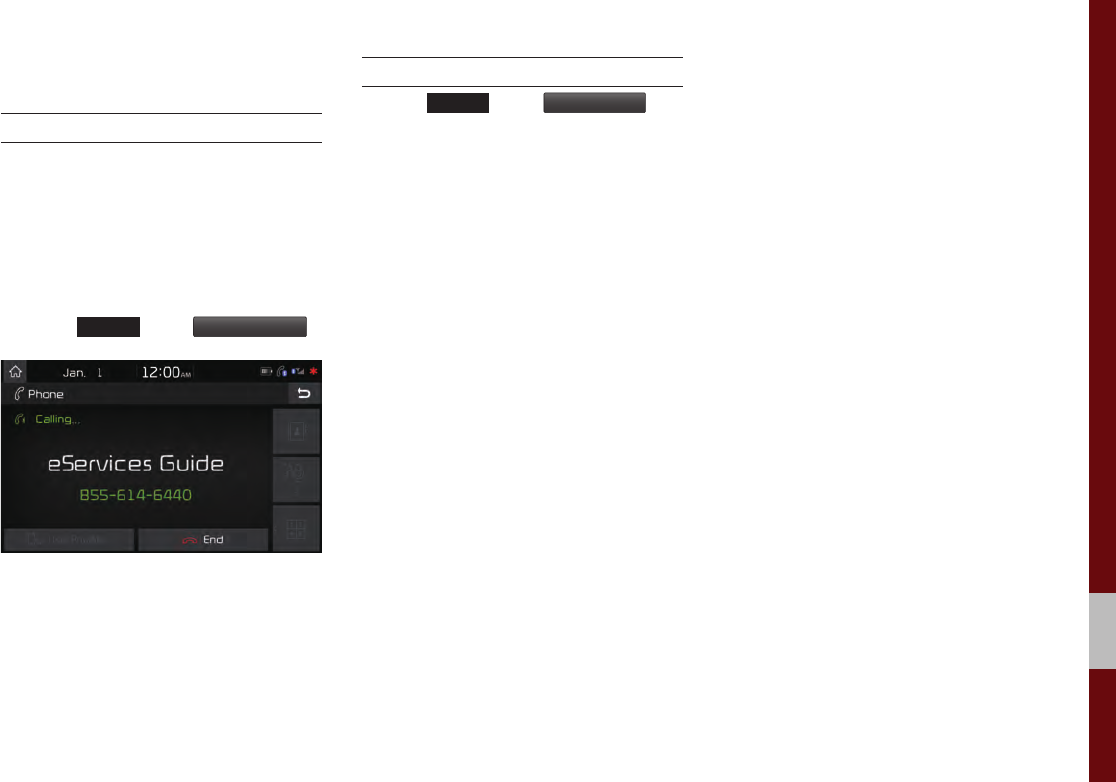
eServices Guide I 4-15
04
eServices Guide
eServices Guide
eServices Guide provides guidance on
how to use UVO eServices.
This feature is only available when the
mobile phone is connected via Bluetooth.
Press the
UVO
key ▶
eServices Guide
UVO eServices Settings
Refer to
SETUP
key ▶
UVO eServices
.

MEMO

What is Voice Recognition?
Precautions Required for Successful Voice Recognition
Starting/Ending and Setting Voice Recognition
Voice Recognition Screen Overview
Voice Commands
Siri Eyes Free
part.5 Voice Recognition

5-2 I Voice Recognition
What is Voice Recognition?
The voice recognition feature operates the
multimedia system by recognizing voice
commands and enables hands-free oper-
ation of the system while you are driving
your car.
Not all possible voice commands are rec-
ognized by the system due to technological
limitations. To make up for these limitations,
the system displays the voice commands
that are available for you to use.
There are errors in communication between
people. Likewise, voice recognition some-
times misunderstands your voice command
in some circumstances. If this happens,
either check the screen for the available
options and say the command again, or
manually select and press the button for the
corresponding command on the screen.
Precautions Required
for Successful Voice
Recognition
1. Voice recognition supports only the
commands that are displayed on the
screen and written in the User's Guide.
2. To ensure the correct recognition and
execution of your command, say your
command when you hear the beep after
a voice prompt.
3. Voice recognition automatically ends if:
1) A call is incoming or outgoing
2) A media device (USB or iPod, etc.) is
connected or disconnected
3) The rear view camera is operated
4) The car engine starts or stops
5) A system key, such as
RADIO
key
or
MEDIA
key is selected
4. The microphone used for the voice
recognition system is located in the
headliner directly above the driver's
head. To make your commands better
understood, keep your body straight
in the driver's seat when speaking the
command.
5. Speaking naturally and clearly will
ensure better recognition of your voice
commands.
6. In the following cases voice recognition
will be affected by ambient noise.
1) The sound of the wind if any window
or the sun roof is open.
2) High speed blower from the air vents.
Set climate control to blow lower than
level 3.
3) Vibrations from passing through a
tunnel.
4) Vibrations from driving on an uneven
road.
5) Storms and heavy rain.
Voice Recognition
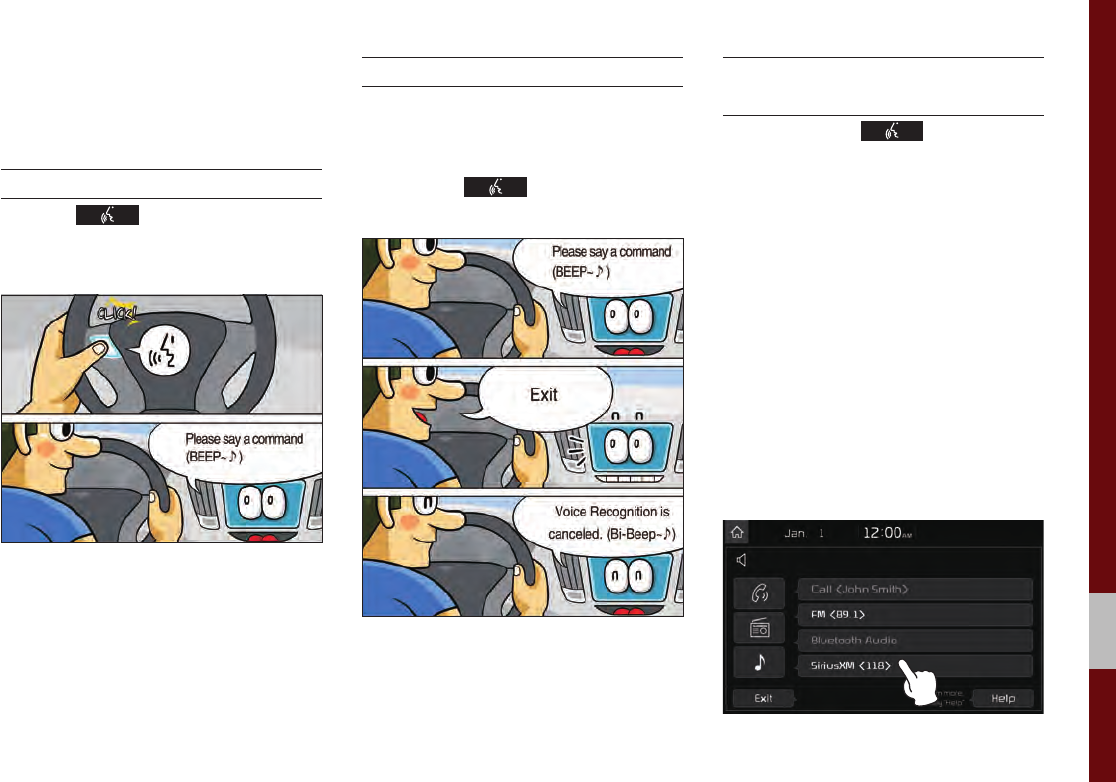
Starting/Ending and Setting Voice Recognition I 5-3
05
Starting/Ending
and Setting Voice
Recognition
Starting Voice Recognition
Press the key briefly (less than 0.8
seconds) on the steering wheel control to
activate voice recognition.
Ending Voice Recognition
1. Select “Exit” to the left of the bottom to
end voice recognition.
2. Press and hold (more than 0.8 sec-
onds) the key on the steering
wheel control to end voice recognition.
Combining Voice Recognition
with On-Screen Commands
After pressing the key, say a com-
mand after the beep. The voice recognition
system will execute the desired operation
after understanding the command.
Alternatively, you may touch any of the
corresponding Commands on the screen
while the Voice Recognition system is in
operation.
Combining voice recognition with available
on-screen commands is useful when the
system is taking longer than expected or
the voice command did not execute as
desired.
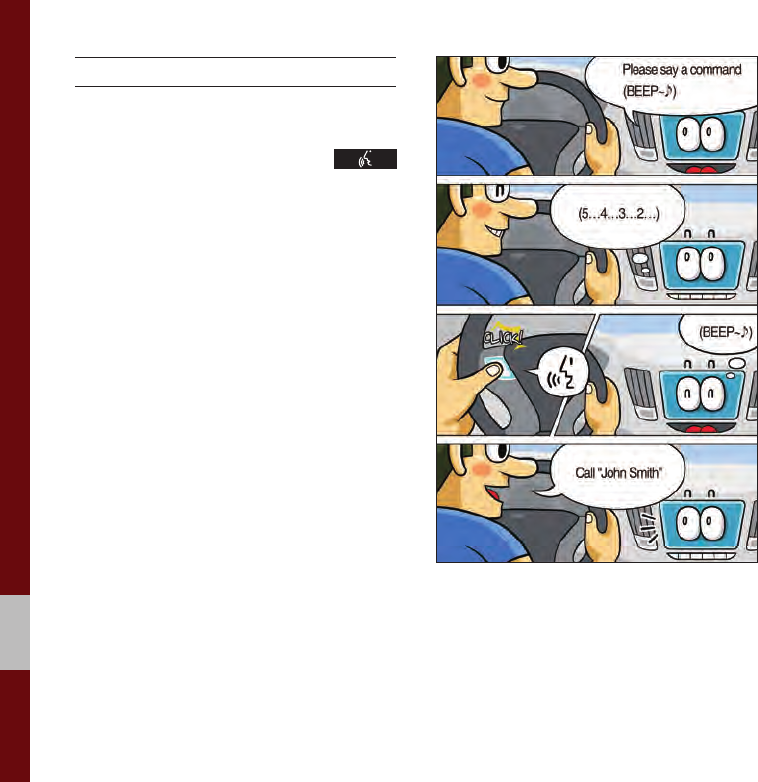
5-4 I Voice Recognition
Extending the Listening Time
When the system is waiting for your com-
mand, after the voice prompt and beep
have been heard, if you press the
key (less than 0.8 seconds), then the beep
will sound again and standby mode will
restart.
When activated, voice recognition waits for
your command for 5 seconds. If you say
nothing for 5 seconds, a voice prompt will
ask for your command again.
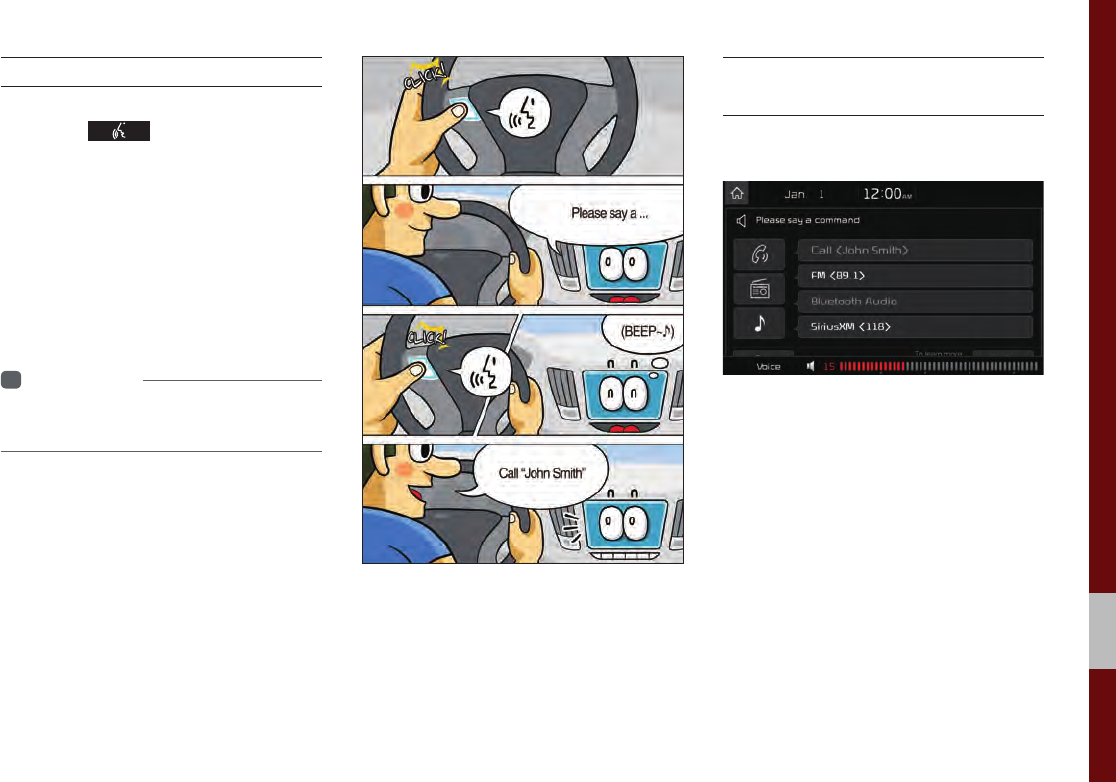
Starting/Ending and Setting Voice Recognition I 5-5
05
Skipping Prompt Messages
When you hear the prompt message,
press the key on the steering
wheel control to skip the message and go
directly to listening mode to say your com-
mand.
This results in faster operation when
you feel the message is too long or you
already know the command to use.
i
Information
• Refer to Part 8 for instructions on how to
change the Voice Recognition Settings.
Adjusting Voice
Recognition Volume
During voice recognition, rotate the vol-
ume knob to adjust the message volume.
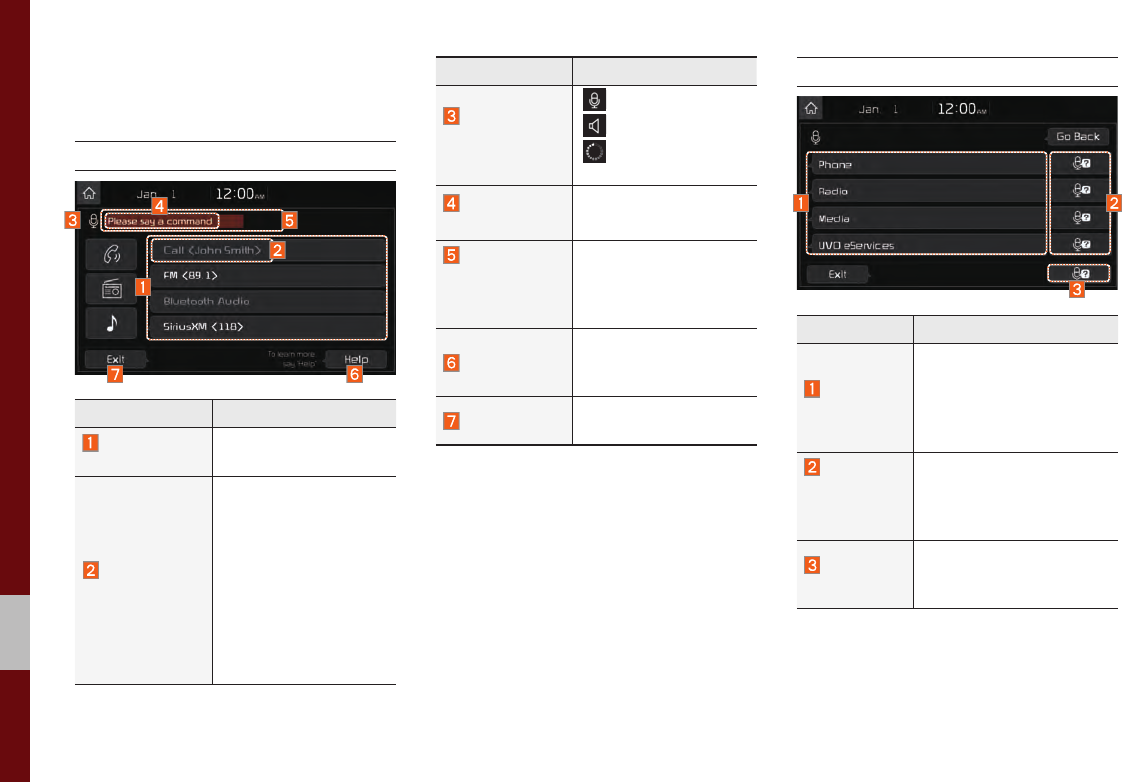
5-6 I Voice Recognition
Voice Recognition
Screen Overview
Start Screen
Name Description
Representative
Commands
Displays the represen-
tative commands.
Not available
command
Displays commands
that are not available
due to a failure in
meeting the conditions
for using them and
thus need additional
settings. The conditions
required for using them
will be described briefly
under each command.
Name Description
Voice
recognition
status icons
Standby
Voice guidance
Voice command
process
Recognized
results
Displays the voice rec-
ognition result.
User's
speaking
volume being
recognized
Displays the voice
command volume in
real time.
Help
Displays all available
help commands in a
tree format.
Exit Ends the voice recog-
nition.
Help Display
Name Description
Command
list
• Shows the available
commands.
• Select or say a command
to display additional com-
mands in detail.
How to
use for
selected
item
This section shows how to
use voice recognition for
the selected item.
How to use
in general
This section displays how
to use voice recognition in
general.
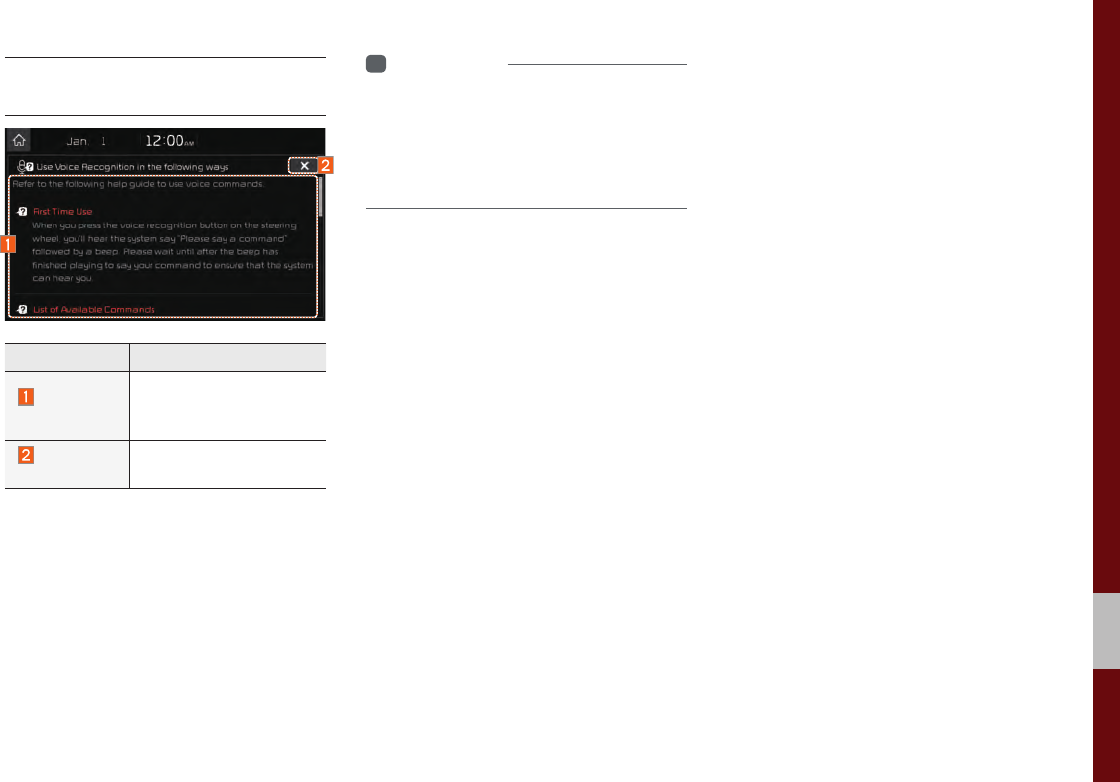
Voice Recognition Screen Overview I 5-7
05
Instructions for Using
Voice Recognition
Name Description
Detail
instruction
This section describes
how to use voice recog-
nition in detail.
Close
button
Closes the screen and
restarts voice recognition.
i
Information
• In the instructions screen, no voice is
recognized, so you must manually issue
commands. Because the instructions screen
displays a lot of content, you cannot view it
while driving for safety precautions.
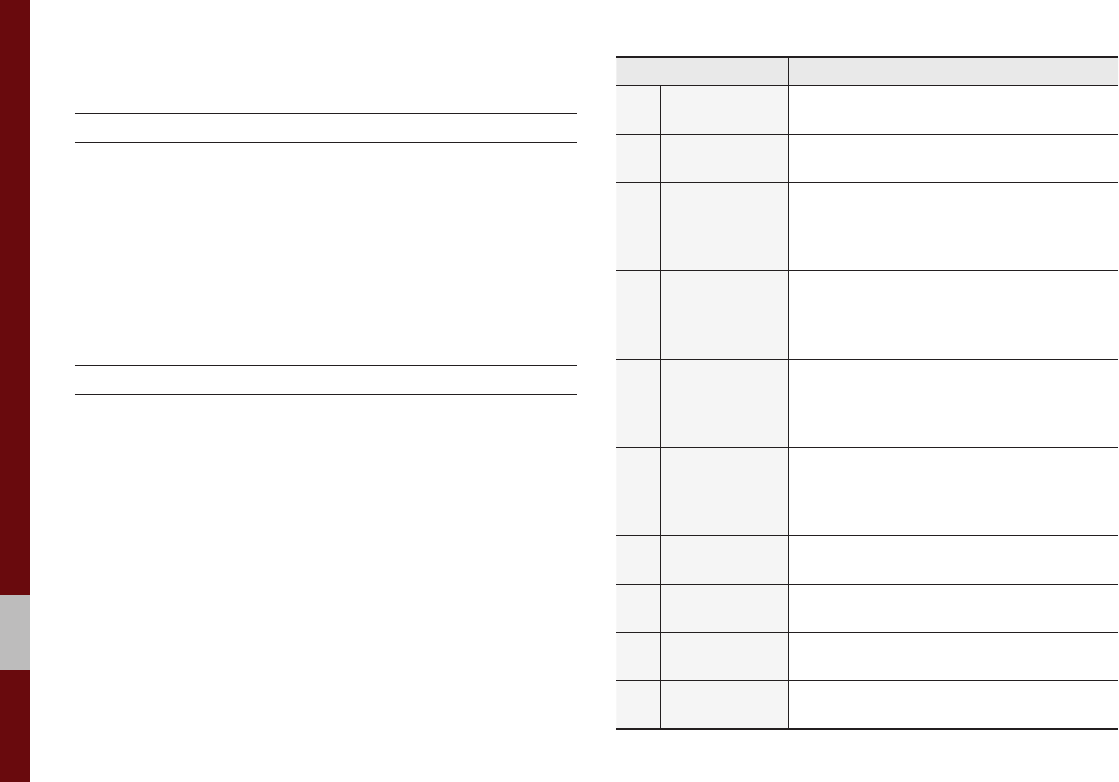
5-8 I Voice Recognition
Voice Commands
Types of Commands
Voice recognition commands are classified as “Global Commands”
and “Local Commands”.
1. Global Commands (●): Commands that can be used immedi-
ately after activating voice recognition.
2. Local Commands (○): Commands that can be used when a
multimedia or Bluetooth function is running, or displayed on the
screen, after activating voice recognition.
Call Commands
* Check the following before using call commands:
1. Voice commands related to phone calls can be used after con-
necting a Bluetooth device.
2. To call a person, for example “Call <John Smith>” whose name
is listed in Contacts, you must first download the Contacts list.
For details on downloading contacts, see “Part 3. Bluetooth >
Chapter 3. Bluetooth Phone > 3.10 Contacts”.
3. After downloading the Bluetooth contacts, it will take some time
to convert the Contacts into voice data during which time you
cannot make a call by name yet. The time it takes to convert
voice data may vary depending on the number of Contacts
downloaded on the phone.
Command Operation
●Call Displays downloaded Contacts, after this
you can make a call by saying the name.
●Call <Name> You can directly call a person by <Name> in
the downloaded Contacts.
●Call <Name>
on Mobile
You can call a person <name> directly to
the number that is saved as “Mobile” in the
downloaded Contacts.
e.g.) Call “John Smith” on Mobile
●Call <Name>
at Work
You can call a person <name> directly to the
number that is saved as “Work” in the down-
loaded Contacts.
e.g.) Call “John Smith” at Work
●Call <Name>
at Home
You can call a person <name> directly to
the number that is saved as “Home” in the
downloaded Contacts.
e.g.) Call “John Smith” at Home
●Call <Name>
on Other
You can call a person <name> directly to the
number that is saved as “Other” than “Mobile,
Home, or Work” in the downloaded Contacts.
e.g.) Call “John Smith” on Other
●Dial Number Displays a screen where you can say a
phone number to dial.
●Dial <Phone #> You can directly say the number to call.
e.g.) Dial 111 555 1234
●Redial Directly calls at the number that you last
dialed.
●Call History Displays your Call History, where you can
say the list number to make a call.
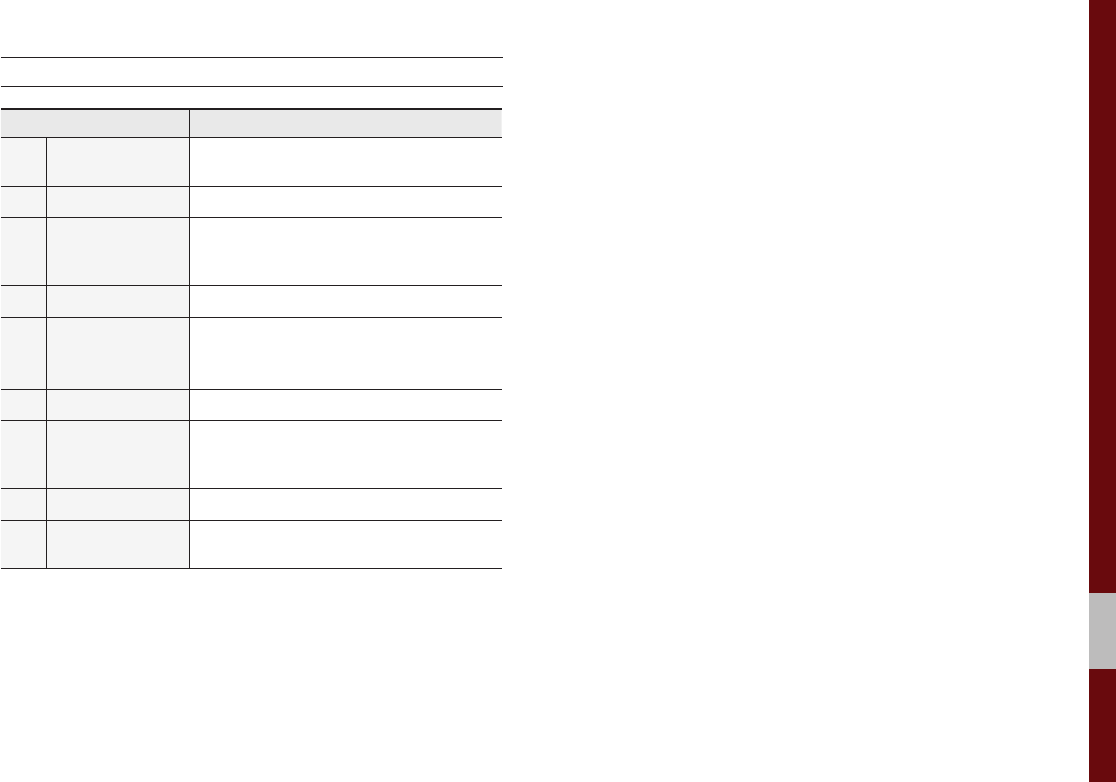
Voice Commands I 5-9
05
Radio Commands
Command Operation
●Radio Plays the most recent radio channels
from FM, AM, and SiriusXM™.
●FM Plays FM radio.
●FM
<87.5~107.9>
Tunes to FM <Frequency> according to
what you say.
e.g.) FM 87.5: FM eighty seven point five
●SiriusXM Plays SiriusXM™ radio.
●SiriusXM
<0~999>
Tunes to SiriusXM™ Channel <Channel
Number> according to what you say.
e.g.) SiriusXM 23: SiriusXM Twenty three
●AM Plays AM radio.
●AM <530~1710>
Tunes to AM <Frequency> according to
what you say.
e.g.) AM 530: AM Five thirty
○Preset <1~40> Tunes to your preset stations (1 to 40).
○Channel
<0~999>
In SiriusXM™ Radio mode, turns on the
<Channel Number> that you say.
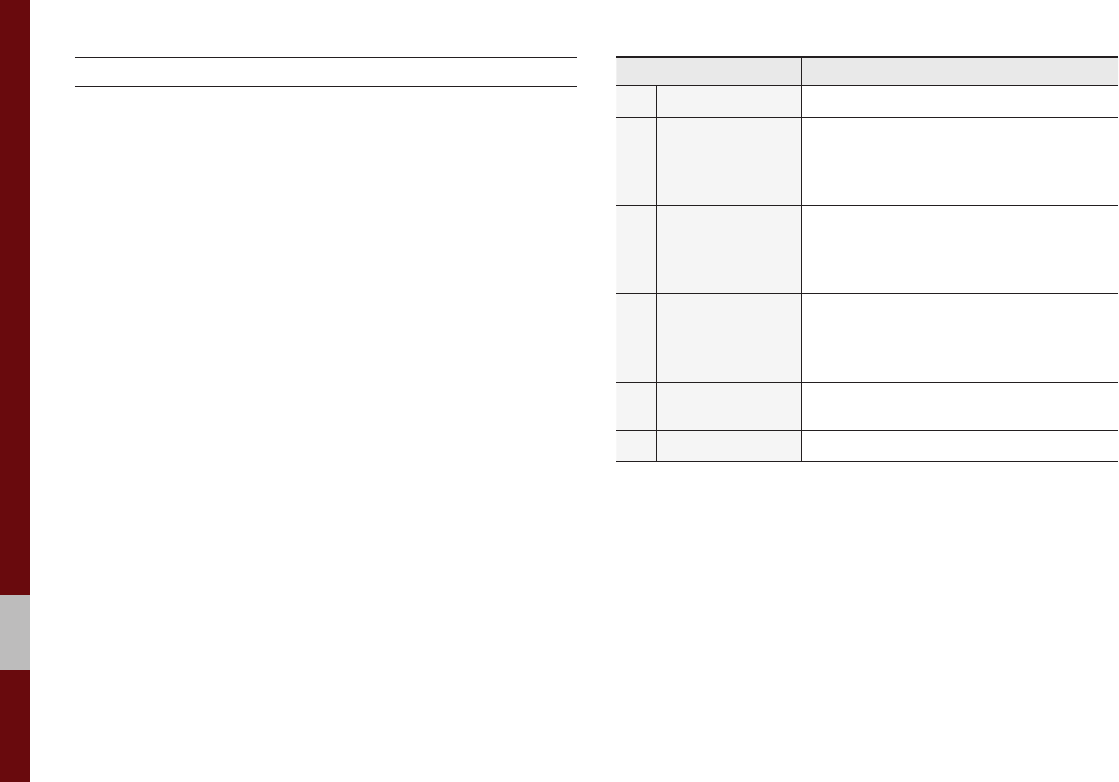
5-10 I Voice Recognition
Media Commands
* Check the following before you use media commands.
1. If no media is connected or if no playable files exist at the time
when you use these commands, a voice message will tell you
that this is not available.
2. If you say the name of the media that is currently playing again,
then that media will continue playing.
e.g.) Saying “USB” while USB content is playing.
Command Operation
●Music Continues the last media you played.
●iPod
Plays the iPod currently connected. This
will work the same when an iPhone is con-
nected. If a USB is connected, then it will
be played instead of the iPod.
●USB
Plays the music on the USB currently con-
nected.
If an iPod is connected, then the iPod will
be played instead of the USB.
●Bluetooth Audio
Plays the music on the Bluetooth phone
currently connected.
This may not be supported depending on
the Bluetooth connection status.
●AUX Plays external devices that are currently
connected.
●My Music Plays My Music files stored in the system.
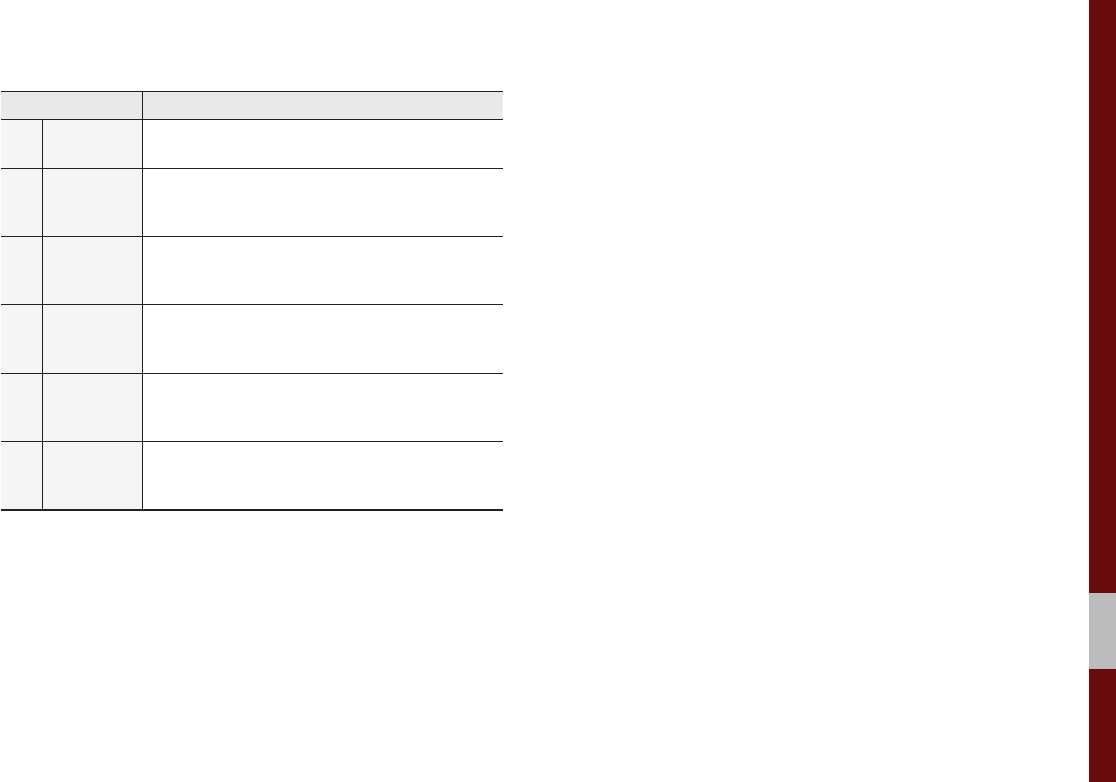
Voice Commands I 5-11
05
1. USB Music/iPod/My Music Command
Command Operation
○Play Plays a selected file.
Maintains the current settings during playback.
○Pause
Pauses a file that is playing.
Maintains current settings while paused during
playback.
○Shuffle
Plays tracks or files randomly.
Maintains current settings during shuffled
playback.
○Shuffle Off
Cancels Shuffle and plays tracks sequentially.
Maintains current settings during sequential
playback.
○Repeat
Plays the current track or file repeatedly.
Maintains the current settings during repeat play-
back.
○Repeat Off
Cancels Repeat and plays multiple tracks or files.
Maintains current settings during multiple track
playback.
2. Bluetooth audio/AUX Command
For Bluetooth audio and external devices (AUX), local commands
are unavailable, including Play, Pause, Repeat and Shuffle.
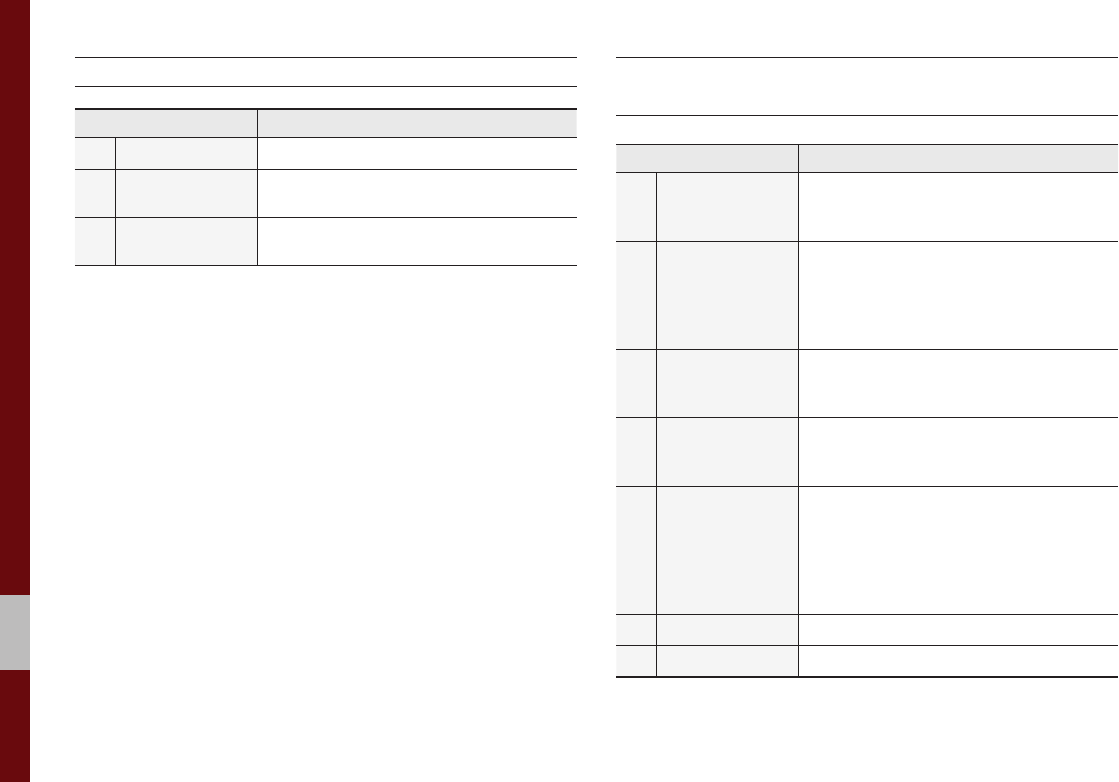
5-12 I Voice Recognition
UVO eServices Commands List
Command Operation
●Roadside Assist Connect with a Roadside Assist agent.
●Vehicle
Diagnostics
Informs you if diagnostic issues are found
in your vehicle
●eService Guide Provides guidance on how to use UVO
eServices
Other Commands List
(Commands used in List/Help)
Command Operation
●Help
Moves to the voice recognition help screen.
All available commands can then be identi-
fied and used.
○Line 1~4
(One~Four)
When you cannot select a certain name,
such as in Call History, you can select it
using numbers.
Simple numbers can be recognized, such
as “One” or “Two”.
○Yes/No
When voice recognition is activated, this
command is used when an answer is
requested for a confirmation question.
○Previous/Next
When four or more searched items are
listed, you can move to the previous or
next page using a voice command.
○Manual Input
When Dial entry results are displayed,
this command is used to search manually,
rather than to search with a voice com-
mand.
Voice recognition stops after this command
is used.
○Go Back Moves to the previous screen.
●Exit Ends the voice recognition.
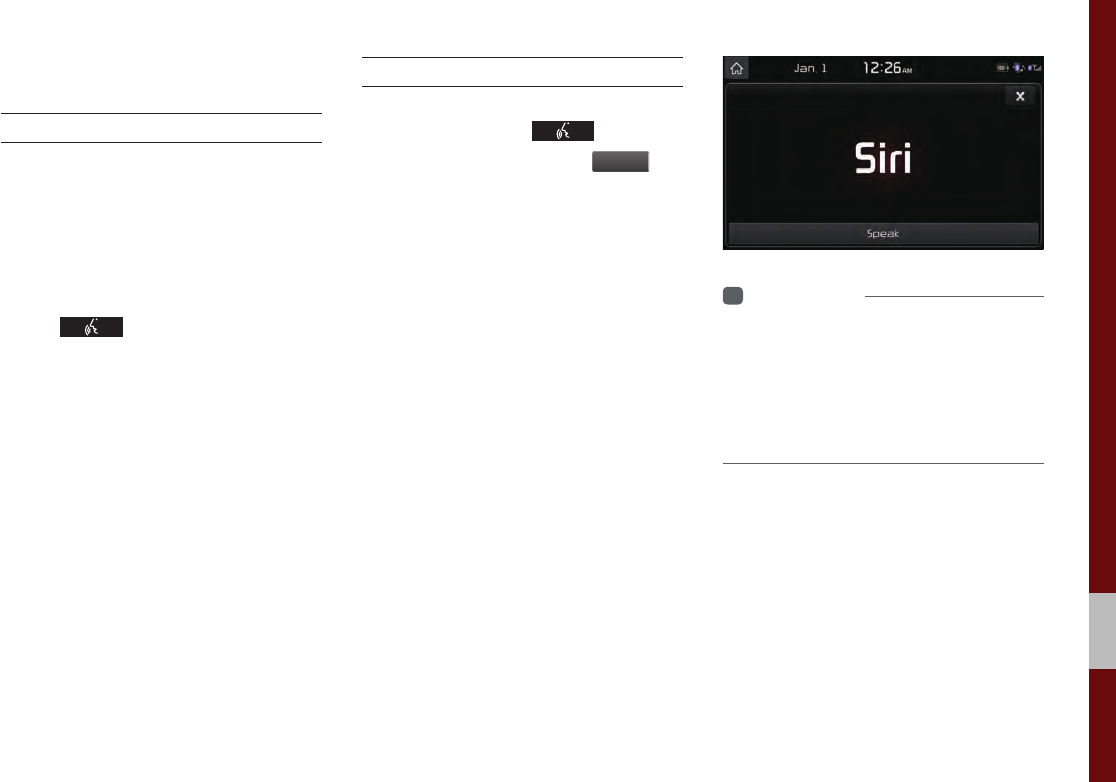
Siri Eyes Free I 5-13
05
Siri Eyes Free
How to start Siri
If you want to use Siri, you have to con-
nect your iOS device to the Multimedia
system through Bluetooth.
(Please check whether your iOS device
supports Siri and turning Siri On)
Then you can use Siri while pressing and
holding key on the steering wheel.
How to use Siri
When you access the Siri screen while
pressing and holding key on the
steering wheel, you select the
Speak
but-
ton and then you can speak what you
want. Note that the Multimedia system
only supports “Phone” related functions.
Other functions will be performed in your
iOS device. If you press voice key quickly,
Siri would re-start. If you hold down voice
key, Siri would be terminated and the
screen would go back to the previous
screen. Eyes-Free mode would be acti-
vated automatically while you are driving.
When shifting gears into P or putting the
Parking brake on, Eyes-Free mode would
be deactivated automatically.
i
Information
• Functions and feedbacks from voice
commands via Siri are executed in the iOS
device. If the iOS version is changed, the
functions and response may be different
according to the iOS device and the latest
version.

MEMO

SiriusXM™ Data
part.6 Apps/Info
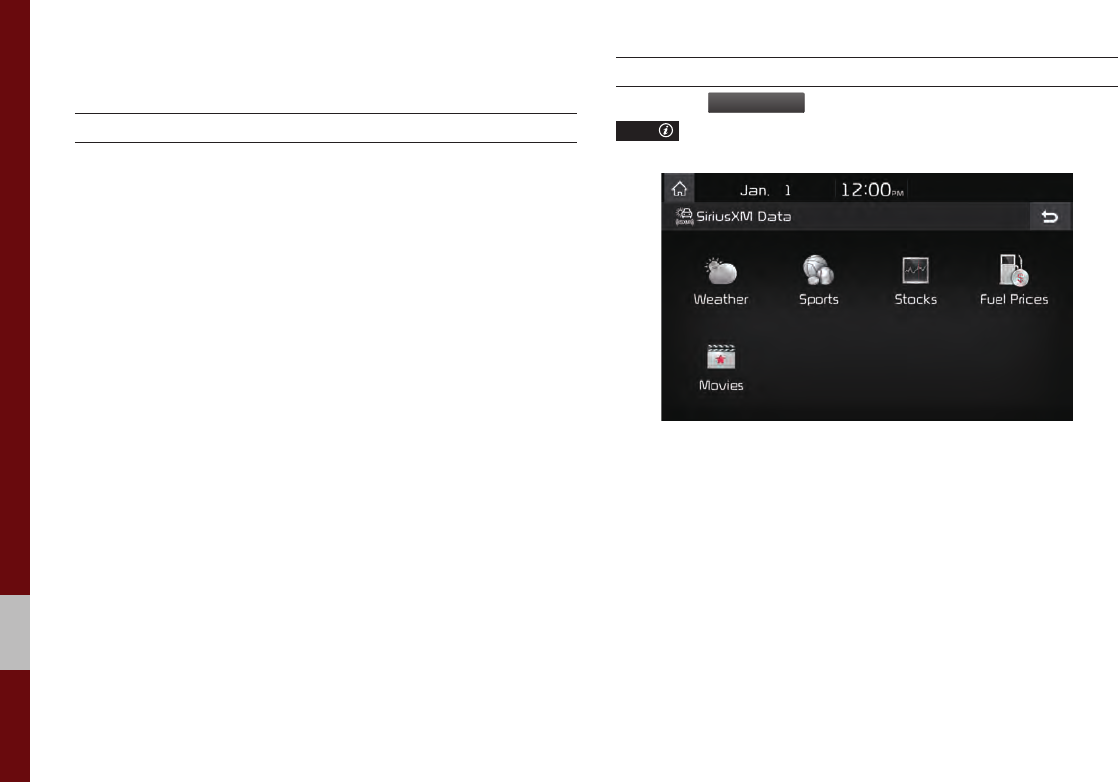
6-2 I Apps/Info
SiriusXM™ Data
About SiriusXM™ Data Service
The SiriusXM™ Data Service is a paid membership satellite radio
service that provides users with information such as Weather,
Sports, Stocks, Fuel Prices and Movies.
However, weather information is not supported for vehicles pur-
chased in Canada.
Accessing SiriusXM™ Data
Select the
SiriusXM Data
icon after selecting All Menus or the
APPS/
key to enter the SiriusXM™ Data mode.
Apps/Info
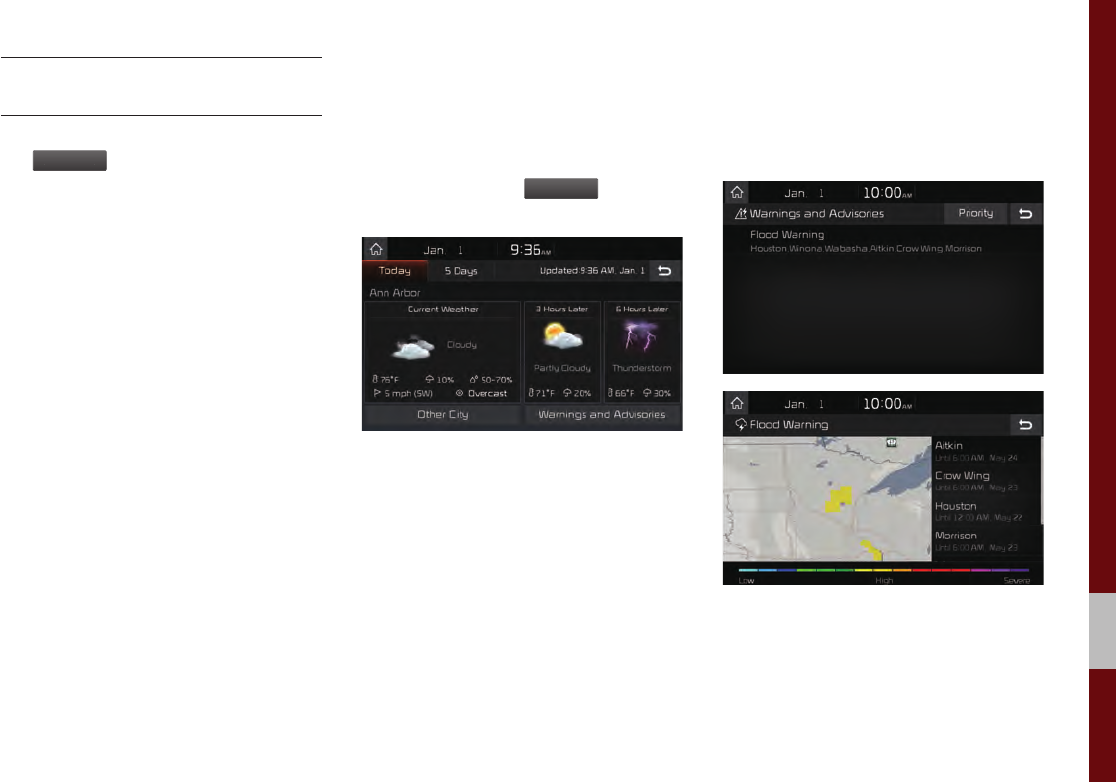
SiriusXM™ Data I 6-3
06
SiriusXM™ Weather
Announcement
At the “SiriusXM Data” screen, select
the
Weathe
r
icon to enter the Weather
Announcement mode.
Weather Forecast
This service provides current weather
information and weather forecasts for the
next five days in your region. To change
the region, select the
O
ther City
button and
select the desired region.
Warnings and Advisories
This service provides weather warnings
and advisories, such as tornado, storm,
flood, etc.
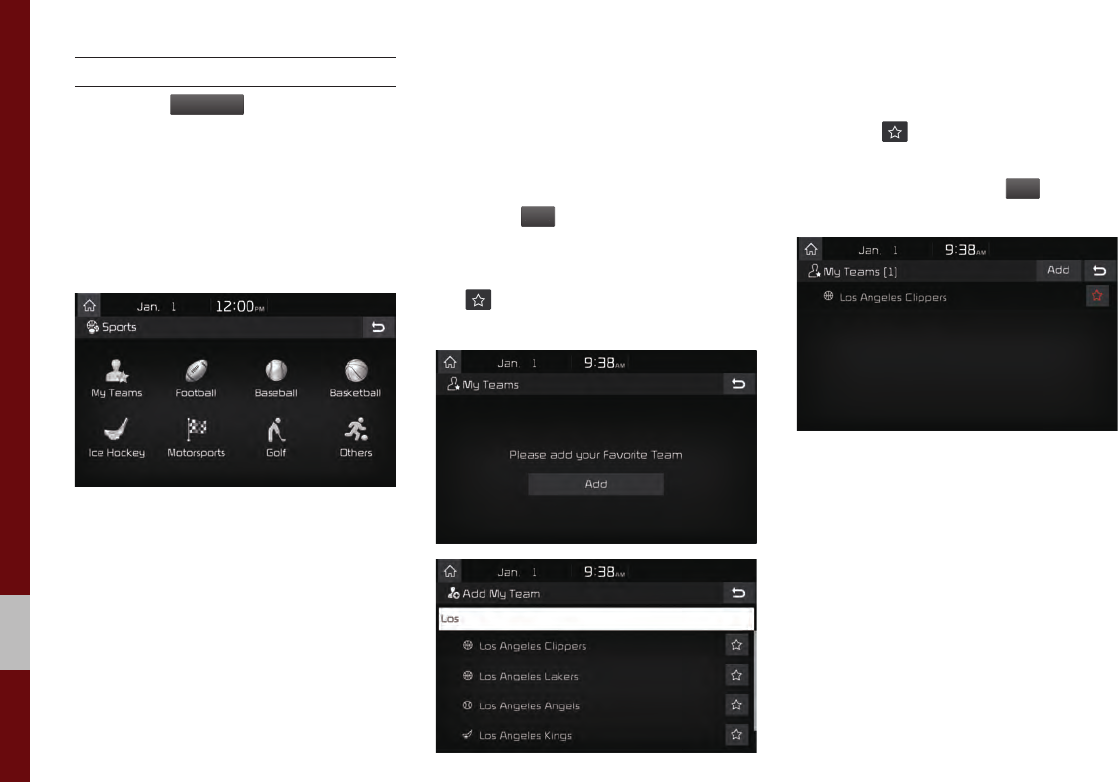
6-4 I Apps/Info
SiriusXM™ Sports Information
Select the
S
por
t
s
icon to enter the
Sports mode.
This service provides real-time updated
information on scores and schedules for
major sports, such as NFL, NBA, NCAA
football, NCAA basketball, NHL, MLB,
NASCAR and more.
My Teams
You can save teams which you are inter-
ested in as part of My teams to easily view
related scores and schedules.
Select the My Teams menu and then
select the
Add
button to search for and
register your favorite teams.
Search for your favorite teams and select
the button on the right to add it to the
“My Teams” list.
You can always check the list of teams
that you added in the “My Teams” menu.
Select the button on the right side of
the team name to delete the team from
“My Teams” or select the
A
d
d
button to
add other teams.
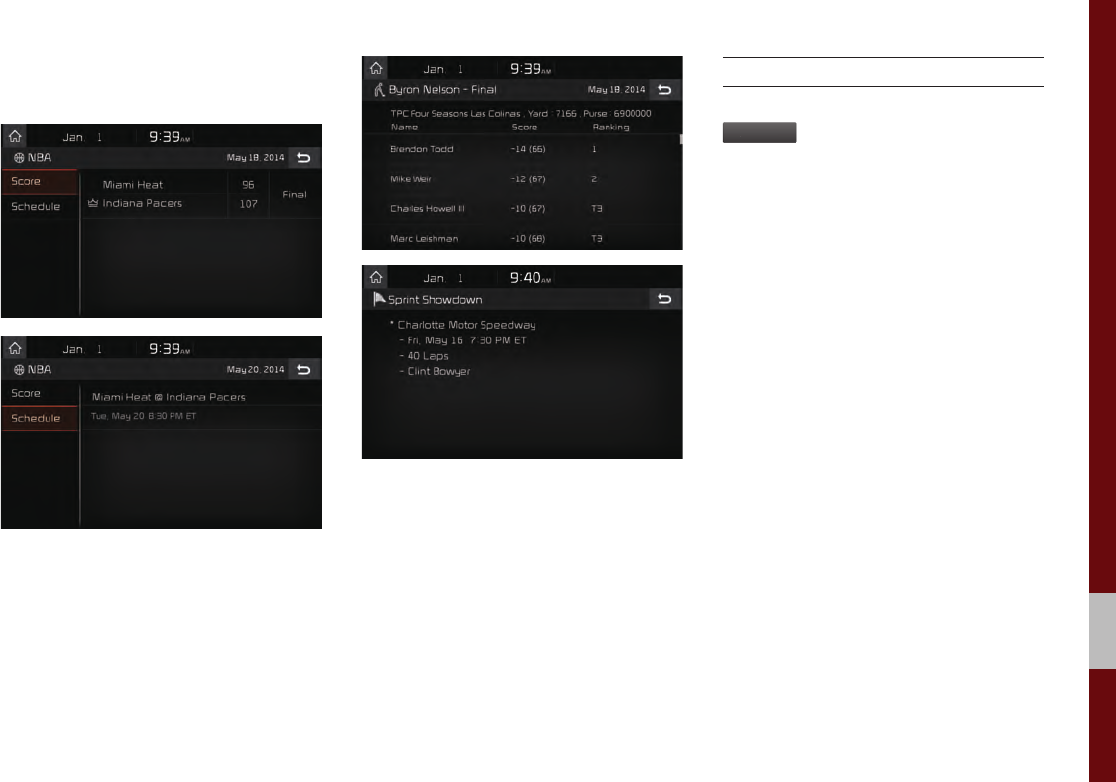
SiriusXM™ Data I 6-5
06
Select the team name to check daily
results and recent schedules for that team.
SiriusXM™ Stock Information
In the “SiriusXM Data” screen, select the
S
tock
s
icon to enter the Stocks mode.
Stocks is a feature that shows the current
value and change of stocks.
For symbols which you are interested in,
select the icon to save the symbol as a
part of the “Saved” symbols which can be
viewed from the “My Favorites” button on
the Stocks Main screen.
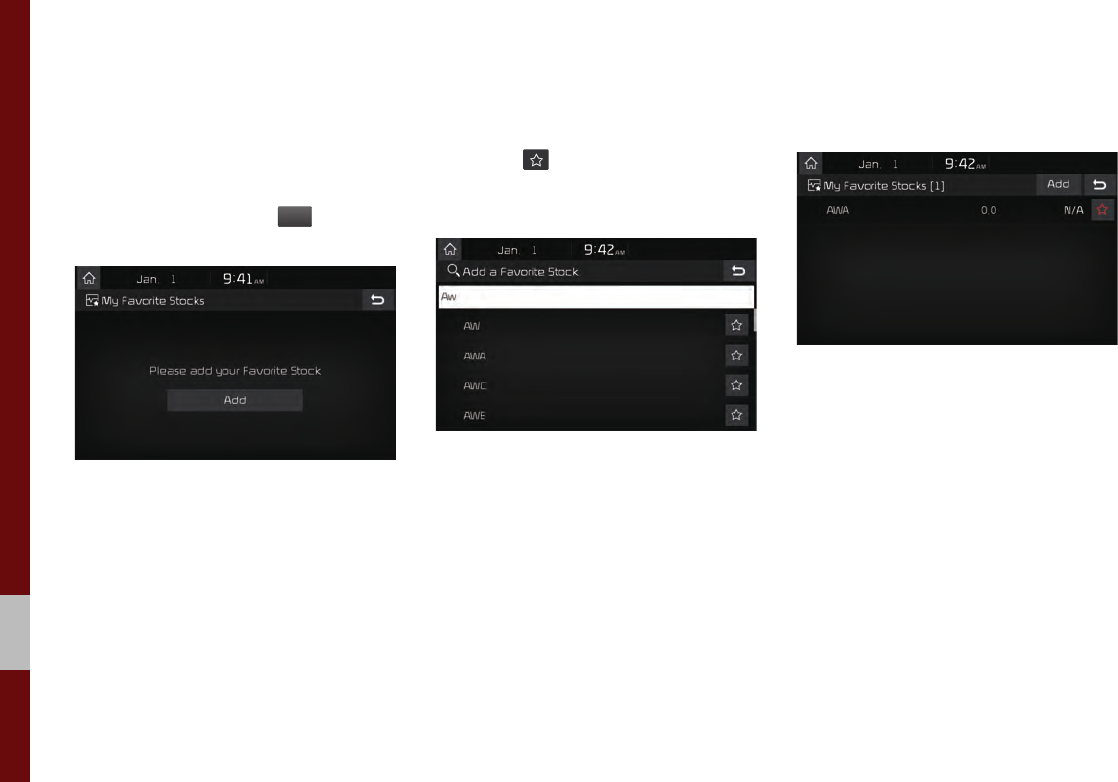
6-6 I Apps/Info
My Favorites
My Favorites shows a list of stocks added
by the user. When entering the Stocks
menu for the first time, a screen is dis-
played for you to add your favorite stock
information. Select the
A
dd
button to
move to the stock search screen.
Stock Search
Use the Stock Search menu to search for
specific stocks.
Select the button after searching for
your favorite stocks to save them in “My
Favorites”.
In the My Favorites screen, you can find
the selected stock information that you
registered.
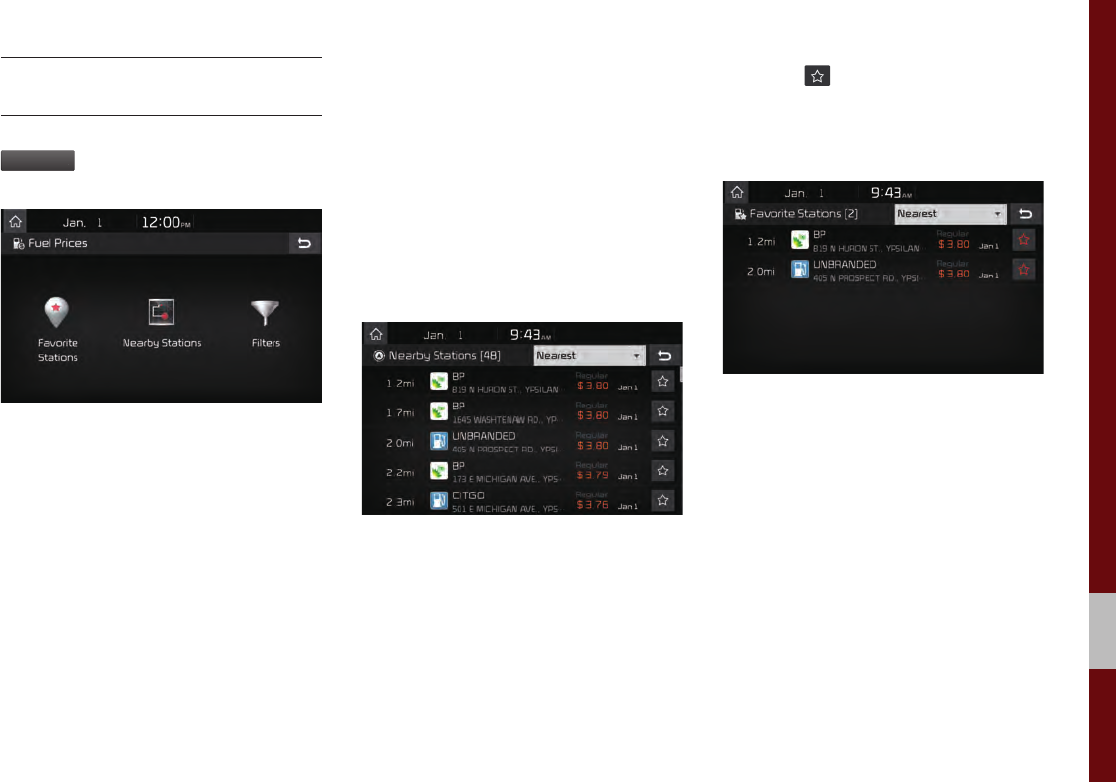
SiriusXM™ Data I 6-7
06
SiriusXM™ Fuel Price
Information
At the “SiriusXM Data” screen, select the
Fuel Price
s
icon to enter the Fuel Prices
Information mode.
Search for Nearby Stations, and
Register Key Locations as Favorite
Stations.
Search for nearby stations with the “Nearby
Stations” menu.
It shows station locations, starting from the
nearest one, and select “Nearest” menu
on the top right side to further sort them
by price or brand name.
Select the button to the right of the list
to register key locations as a Favorite
Station so that you can go there again with
the “Favorite Stations” menu.
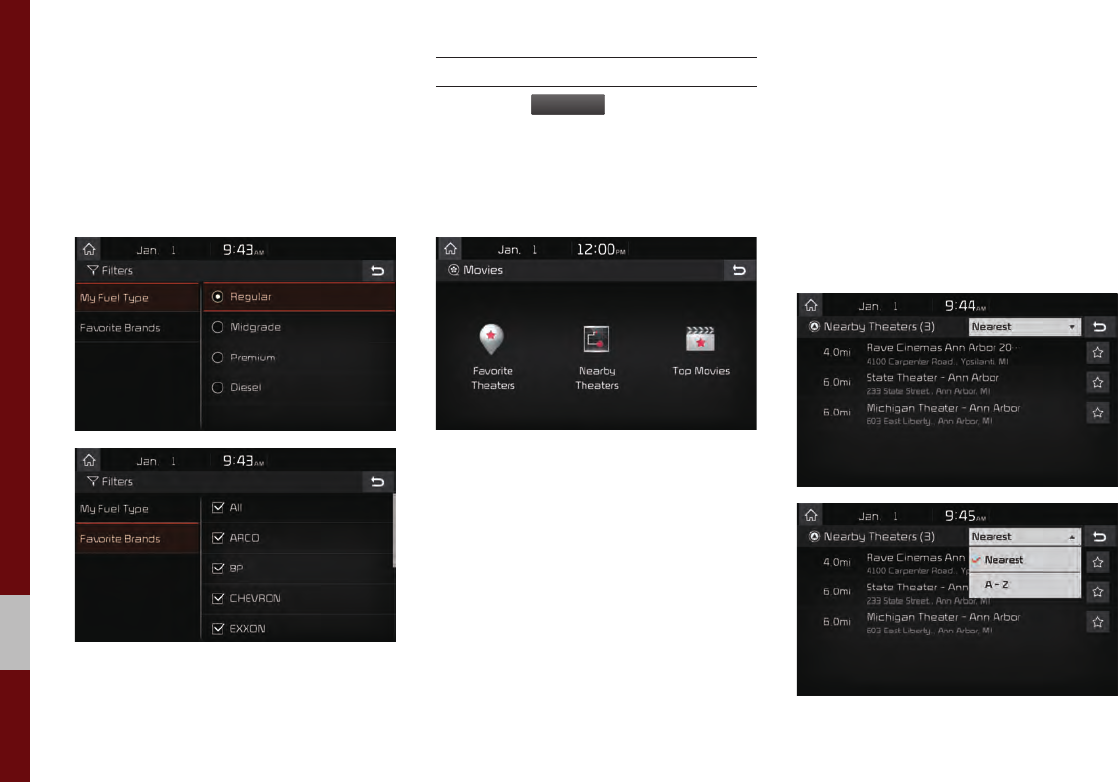
6-8 I Apps/Info
My Fuel Type Settings
With the “Filters” menu, you can select fuel
types and favorite brands.
When searching for Nearby Stations, the
results will reflect selected fuel types and
brand information.
SiriusXM™ Movie Information
Select the
M
ovies
icon to enter the
Movie mode.
You can check recent movies and nearby
theaters, and also register your favorite
theater locations.
Search for Nearby Theaters, and
Register Any Key Locations as Favorite
Theaters.
In the “Nearby Theaters” menu, you can
search for any nearby theaters.
It shows theaters, starting from the nearest
one, and selecting the “Nearest” menu at
the top right side will sort them by name.
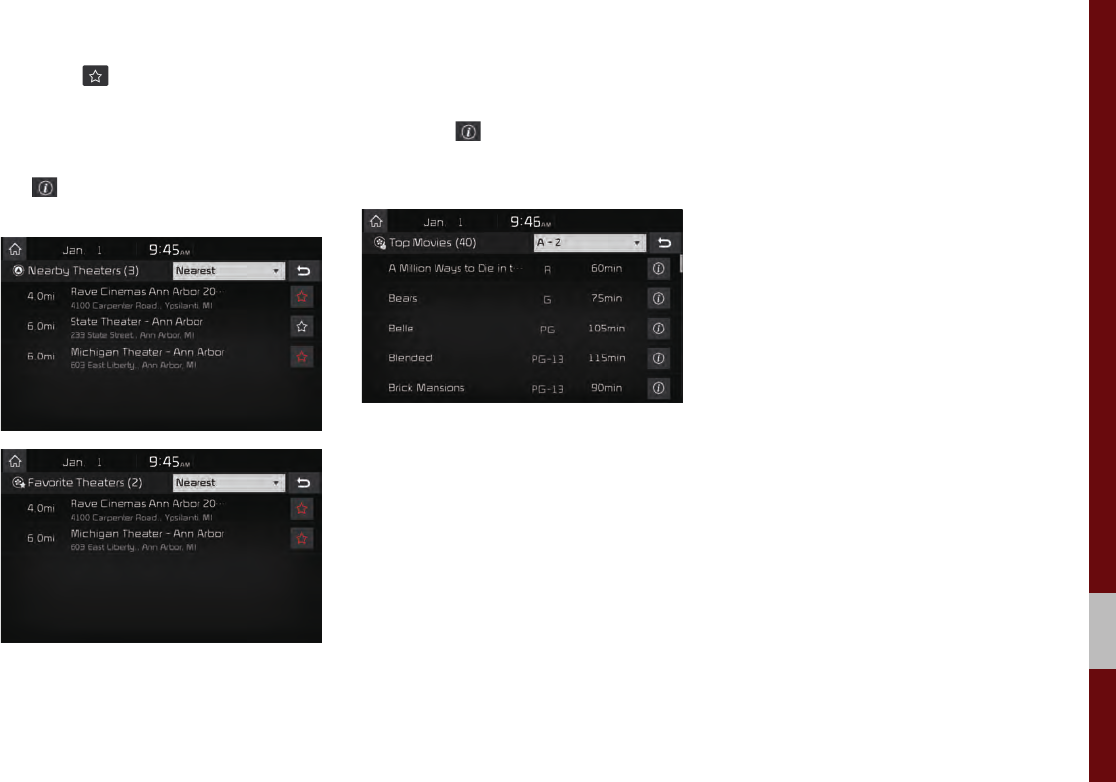
SiriusXM™ Data I 6-9
06
Select the button to the right of the list
to register your favorite theater so that you
can always check it again using the
“Favorite Theaters” menu and selecting
the button to view the current movie
information for that theater.
In the “Top Movies” menu, you can check
for any movies that are currently popular.
Select the button to the right of a
movie title to view the plot summary and
any other detailed information.

MEMO

Climate Mode
Camera
part.7 Other Features
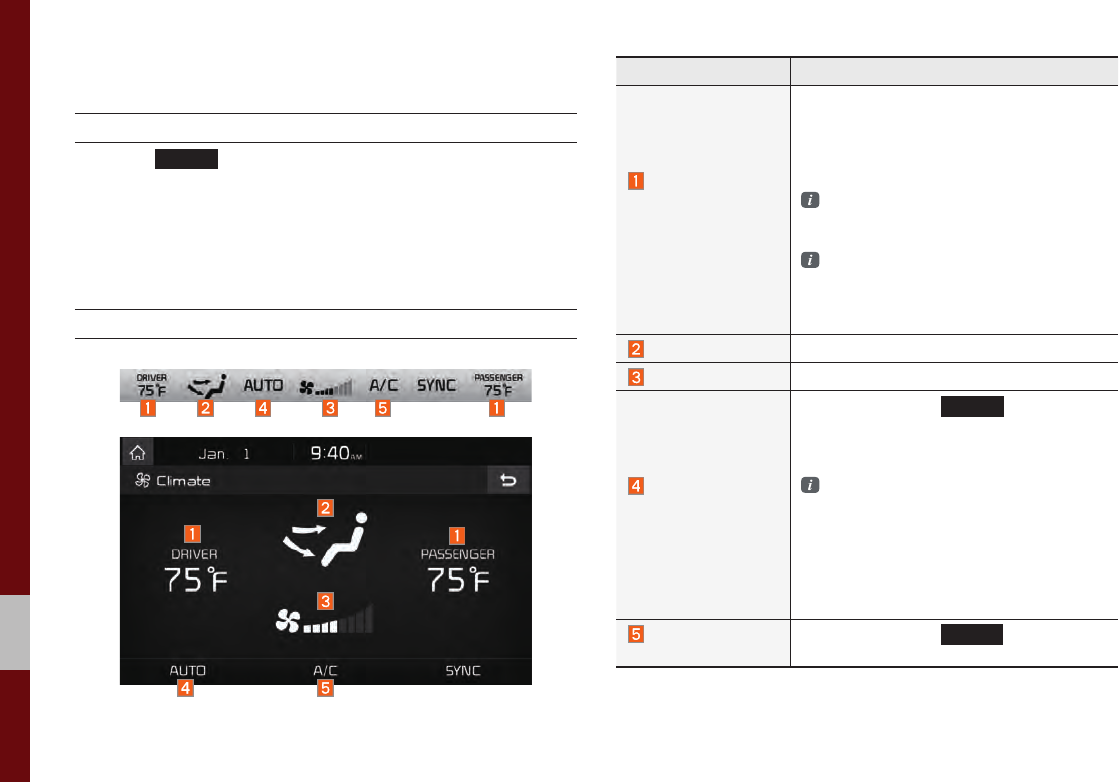
7-2 I Other Features
Other Features
Climate Mode
Operating Climate Mode
Press the
CLIMATE
key for the climate system to see status infor-
mation in the full screen display.
While multimedia or navigation is in use, the climate system infor-
mation will be displayed over top when you control the tempera-
ture (TEMP) or turn on the air conditioner (A/C).
Basic Mode Screen
Name Description
Set the temperature
of the driver's seat
and passenger
seats
Displays the configured temperature set-
tings for the driver's seat and the passenger
seats. Cooling or heating will continue until
the temperature matches the configured
temperature settings.
The internal temperaure can be con-
trolled in incrments of 1°F within a range
of 63°F to 89°F.
LOW is displayed when the temperature
is set to anything below 63°F, and HIGH
is displayed when it is set to anything
above 89°F.
Air direction Displays the configured air direction settings.
Air volume Displays the configured air volume settings
Cooling/heating
control status
(AUTO)
Displayed when the
AUTO
key is pressed
and cooling/heating operates automatically
according to the configured temperature
settings.
AUTO will be turned off when you try to
do the following with AUTO on:
- Control the air volume
- Control the air direction
- Turn the air conditioning (A/C) on/off
- Turn on the moisture removal function
for the windshield
Air conditioning
control status
Displayed when the
A/C
key is pressed
and the air conditioning starts cooling/heating.
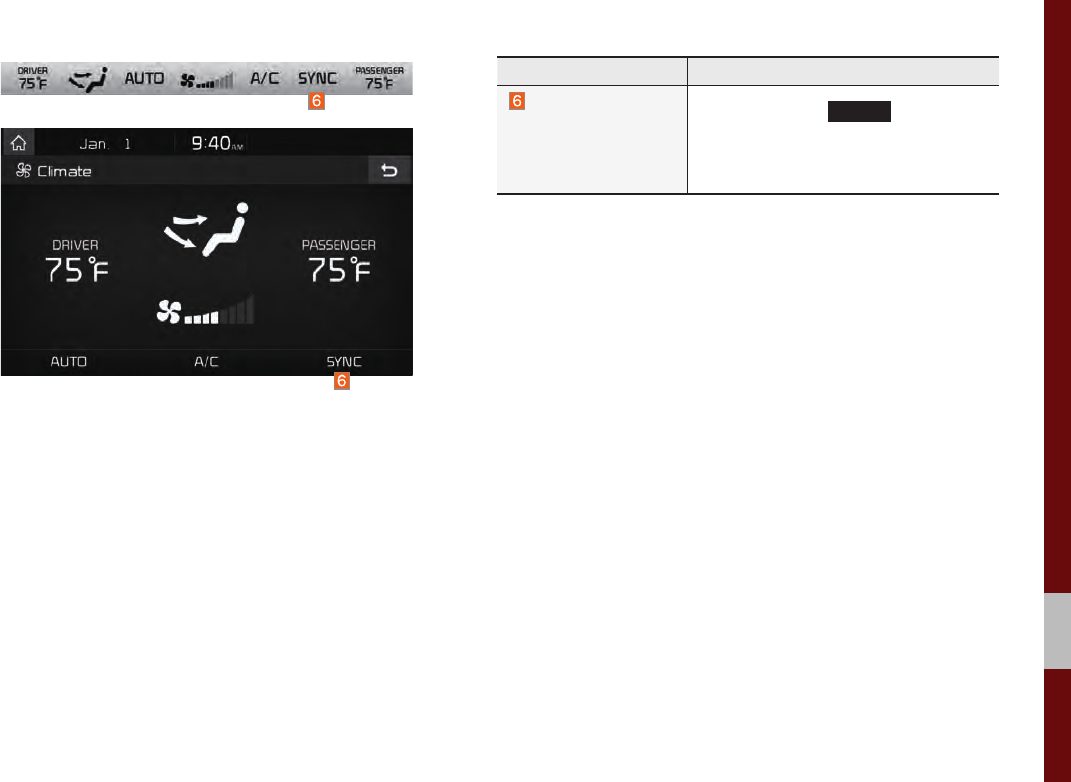
Climate Mode I 7-3
07
Name Description
Simultaneous tem-
perature settings for
the driver's seat and
the passenger seats
(SYNC)
Displayed when the
SYNC
key is pressed
and the temperatures of the driver's seat
and the passenger seats can be config-
ured at the same time.
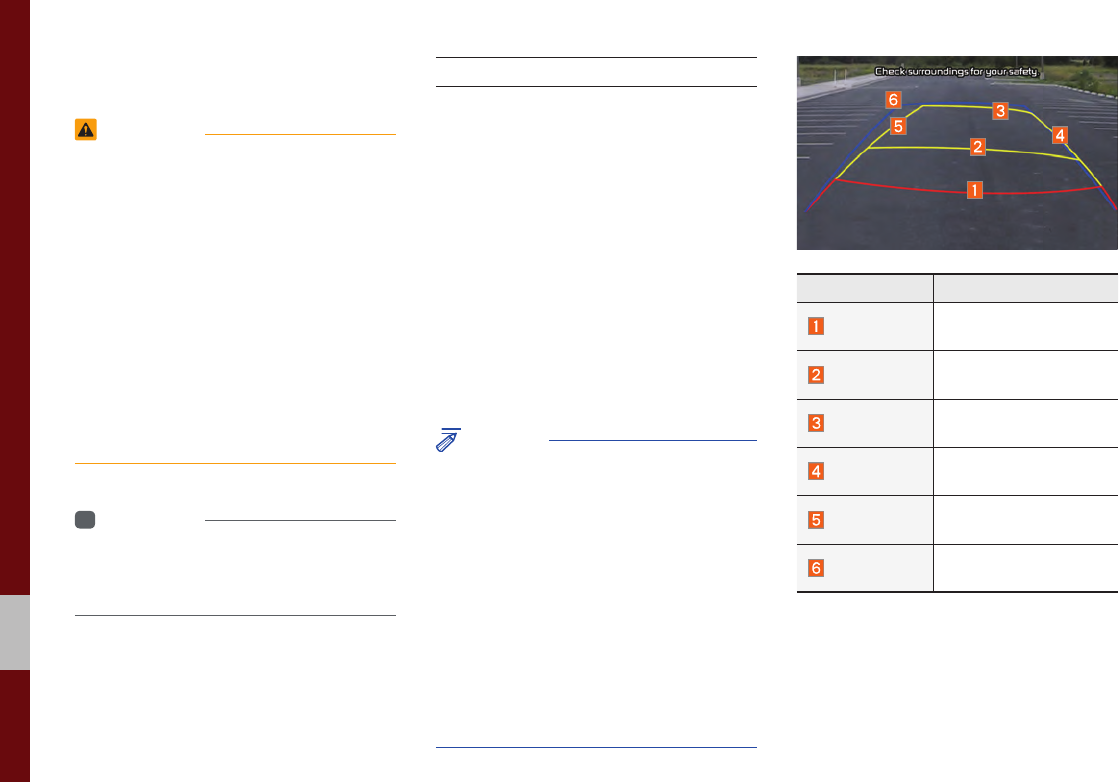
7-4 I Other Features
Camera
WARNING
- Backing Up & Using Camera
• Never rely solely on the rear view camera
when backing up. Prior to entering your
vehicle always do a visual check of the area
behind your vehicle, and before backing up be
aware of your surroundings and supplement
the rear view camera by looking over your
shoulders and checking your rear view mir-
rors. Due to the difficulty of ensuring that the
area behind you remains clear, always back
up slowly and stop immediately if you even
suspect that a person, and especially a child,
might be behind you.
i
Information
• A separate chipset is used for the camera
screen while booting up, so it may be different
after booting up.
Steering-linked camera
• This device is connected to a rear
detection camera to see behind the car
for safe reversing.
• The Rear View Camera turns on auto-
matically if you shift the gear to R when
the power is on or the engine has
started.
• While the device boots up, shift the gear to
"R" to activate the rear detection cameras.
Shift the gear to another position to deac-
tivate the rear detection camera.
NOTICE
• A wide-angle lens is installed as the rear
detection camera to get a wider view, so
there may be some difference between the
actual distance and the distance that appears.
on-screen. For safety, make sure to view
the back, right, and left sides of the car for
yourself.
• The color of the parking guidelines displayed
in the picture may differ from the actual
screen.
• When booted up, blinking may occur when
you switch to a UI screen.
Name Description
Red Line About 0.5 m from the
rear bumper
Yellow Line 1 About 1 m from the
rear bumper
Yellow Line 2 About 3 m from the
rear bumper
Yellow Line 3 Trajectory of the wheel
on the driver’s side
Yellow Line 4 Trajectory of the wheel
on the passenger side
Blue Line Neutral steering trajec-
tory
As you reverse your car and monitor the
area behind your car, the steering-linked
driving trajectory and the neutral driving
trajectory are both displayed.

Setup
Sound Settings
Display Settings
Bluetooth Settings
UVO eServices Settings
Home Screen Settings
Wi-Fi Settings
Clock Settings
Voice Recognition Settings
Language Settings
Keyboard Settings
Screen Saver Settings
System Info
part.8 Setup
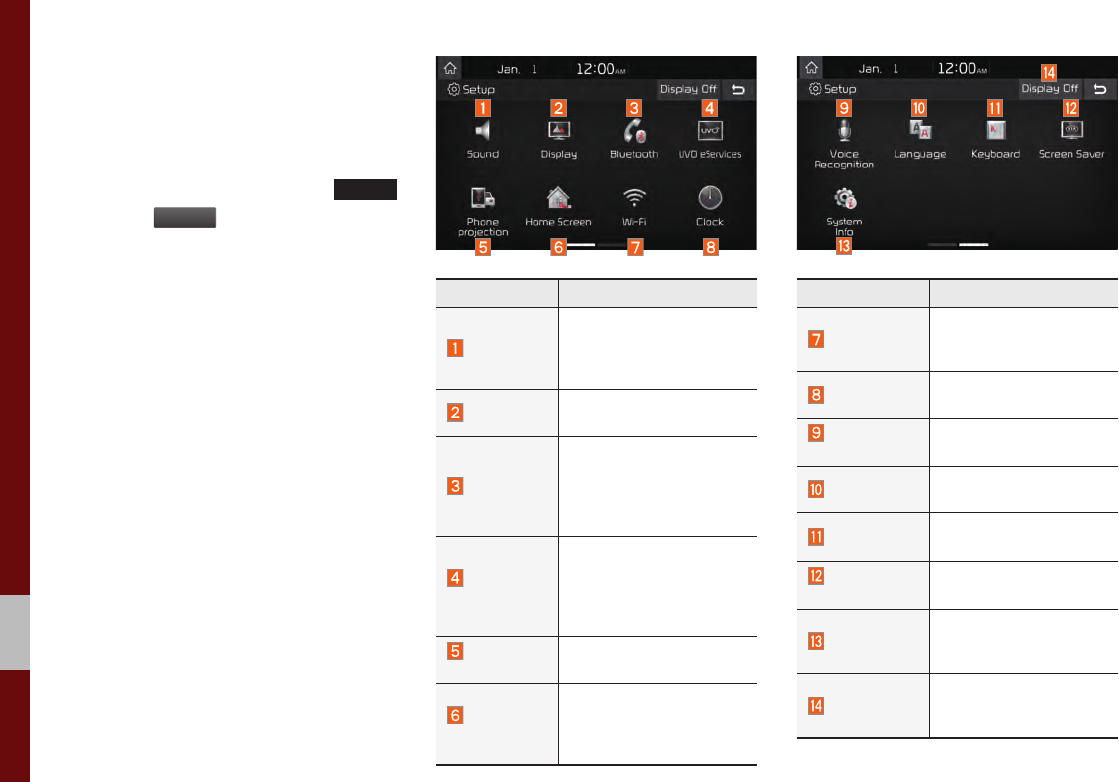
8-2 I Setup
Setup
Setup
Setup is the screen to control Audio sys-
tem settings.
To enter the screen, press the
SETUP
key or the
S
etup
icon in All Menus.
Features Description
Sound
Provides the sound con-
trol options for Position,
Bass, Mid, Treble, Volume
and Advanced settings.
Display Provides the Mode/
Illumination settings.
Bluetooth
Provides the Bluetooth
Connection/Auto
Connection Priority/
Bluetooth System
Information settings.
UVO
eServices
Provides the 911
Connect/Parking Minder/
My Car Zone/Scheduled
Diagnostics/Trip Info
Sync Reminder Settings.
Phone
projection
For more details, refer to
Phone projection guide.
Home
Screen
Provides the function
to customize the three
menu items at the bottom
of the Home Screen.
Features Description
Wi-Fi
Provides the Wi-Fi
On and Network
Connection settings.
Clock Provides the Time and
View settings.
Voice
Recognition
Provides the Guidance
and Priority settings.
Language Provides the Change
Language settings.
Keyboard Provides settings to
switch keyboard layouts.
Screen
Saver
Provides the Clock/
None settings.
System Info
Provides software and
storage space informa-
tion.
Display Off
Provides the Display Off
(touch activation) func-
tion.
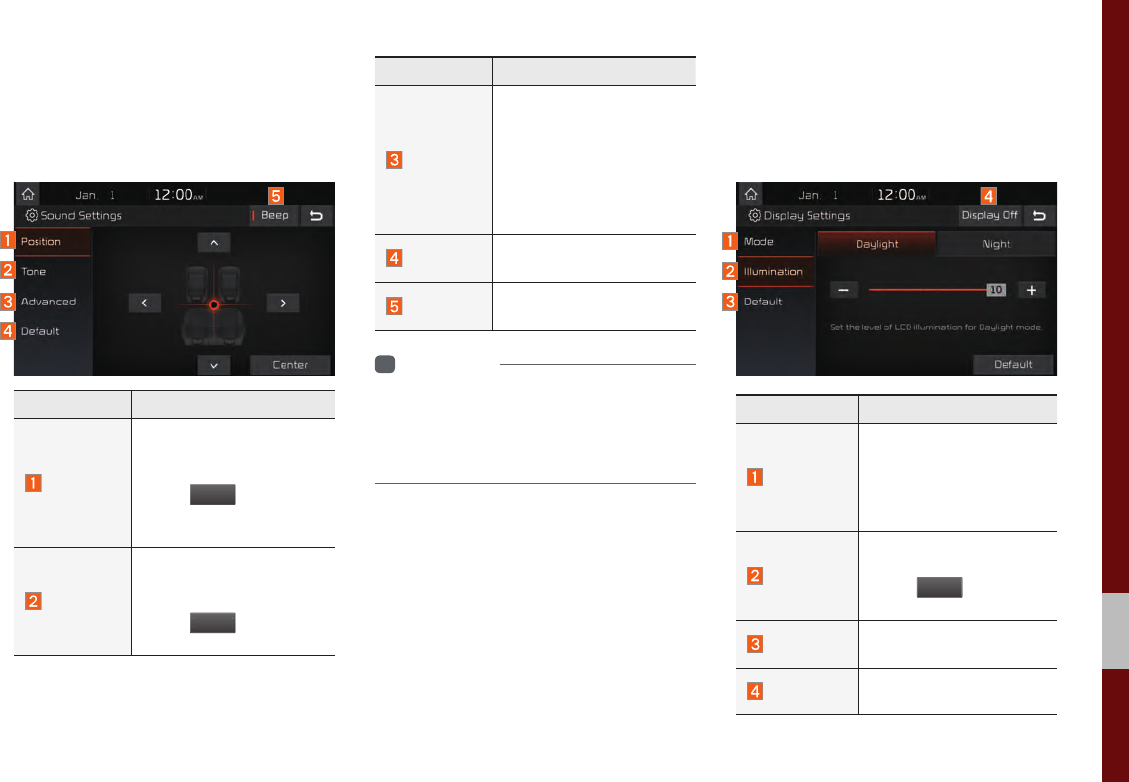
Setup I 8-3
08
Sound Settings
Adjusts the sound effects for the whole
system.
Features Description
Position
Select the Up/Down/Left/
Right button to control
sound positioning.
Select
Ce
n
te
r
to concen-
trate the sound on the
center of vehicle.
Tone
Drag the slide bar to
control bass/mid/treble
settings.
Select
Ce
n
te
r
to initialize
the settings.
Features Description
Advanced
Select additional audio
options such as “Speed
Dependent Volume
Control” that automatically
controls Audio volume
according to vehicle speed
as well as “Variable EQ”.
Default Resets the sound to fac-
tory default settings.
Beep Select to activate a beep
when pressing buttons.
i
Information
• Advanced sound settings may differ according
to selected AMP option.
• The seat shape may differ according to
vehicle model.
Display Settings
Adjusts the level of illumination for the
entire system.
Features Description
Mode
Select any of LCD illumi-
nation change modes:
Automatic (changes
the level automatically),
Daylight, and Night.
Illumination
Set the levels of illumina-
tion for day and night.
Select
D
e
f
au
lt
to initialize
the settings.
Default Resets the display to fac-
tory default settings
Display Off Provides the Display Off
(touch activation) function.
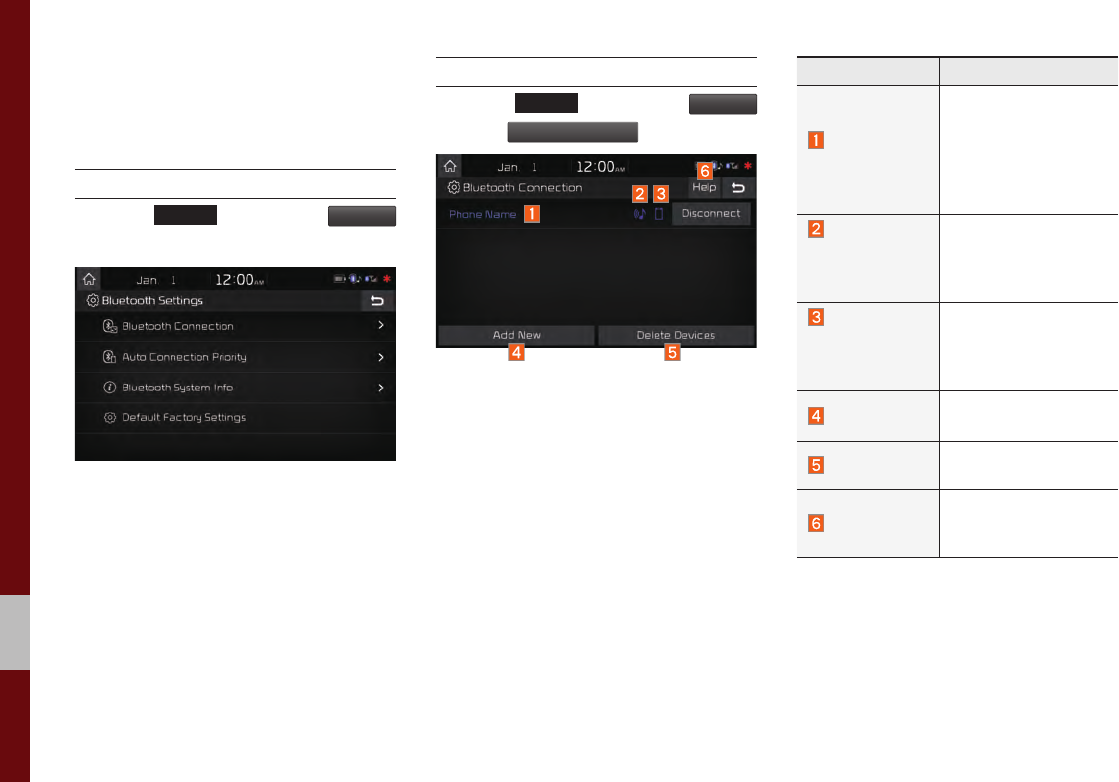
8-4 I Setup
Bluetooth Settings
Changes Bluetooth phone settings.
Bluetooth Settings
Press the
SETUP
key ▶ Select
Bluetooth
icon.
Bluetooth Connection Settings
Press the
SETUP
key ▶ Select
Bluetooth
▶ Select
Bl
ue
t
oo
th
C
onnec
ti
on
.
Features Description
Paired Device
List
Displays the paired
Bluetooth device list.
When selecting from
the list, the device is
connected or discon-
nected.
Bluetooth
Audio
Connection
Status
An icon appears when
you make a Bluetooth
Audio connection.
Bluetooth
Hands-Free
Connection
Status
An icon appears when
you make a Bluetooth
Hands-free connection.
Add New Register a new
Bluetooth device.
Delete Devices Select and delete a
paired device.
Help
Switches to the
Bluetooth Connection
Help screen.
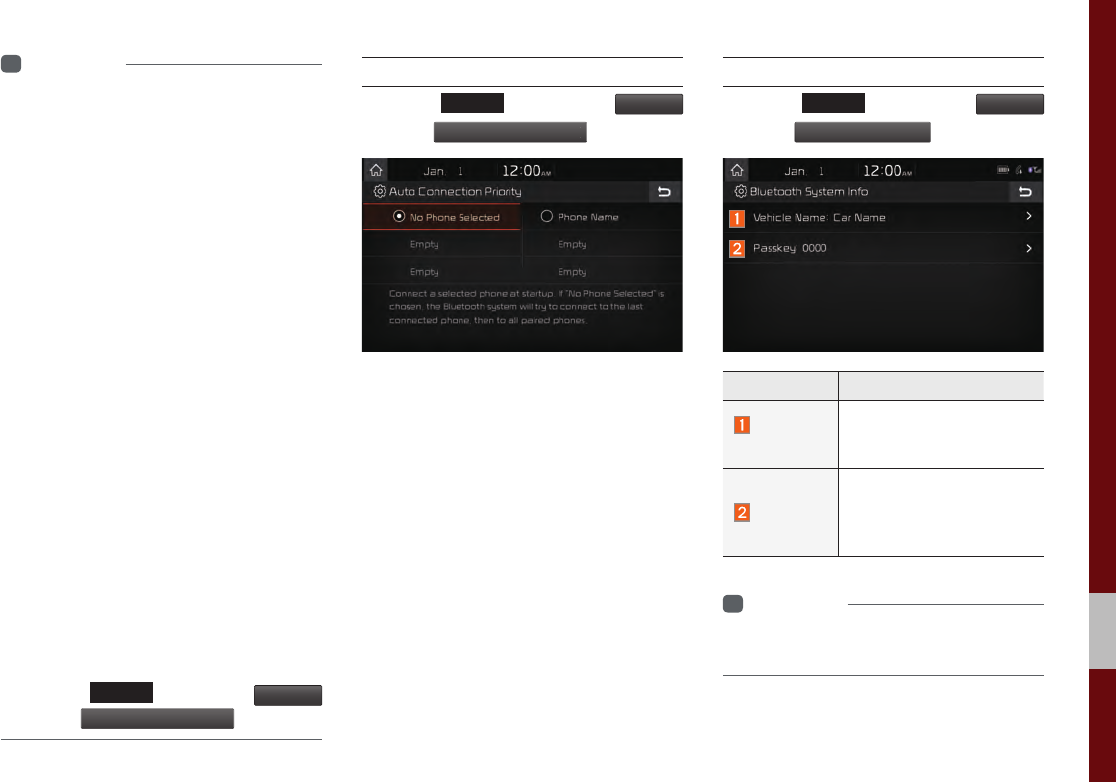
Setup I 8-5
08
i
Information
• Up to 5 Bluetooth devices can be paired.
• Only one Bluetooth device can be connected
at a time.
• During a Bluetooth device connection, another
device cannot be paired.
• When you delete a paired device, the Call
History and Contacts stored in the head unit
are also deleted.
• Bluetooth Hands-free and Bluetooth Audio
functions are supported.
• Hands-free and audio-supported devices,
such as a Bluetooth smartphone or audio, will
function normally.
• When a Bluetooth device is connected, if
the Bluetooth connection is unexpectedly
disconnected, due to being out of
communication range, the device powering
off, or a Bluetooth communication error, the
Bluetooth device automatically searches for
and connects to nearby Bluetooth devices.
• If the system is not stable, due to a vehicle-
Bluetooth device communication error, restore
the Default Factory Settings.
• For Default Factory Settings, the bluetooth
settings are reset to factory settings.
• Press the
SETUP
key ▶ Select
Bluetooth
▶ Select
D
e
f
au
lt
F
ac
t
ory
S
e
tti
ng
s
.
Auto Connection Priority
Press the
SETUP
key ▶ Select
Bluetooth
▶ Select
Auto Connection Priorit
y
.
When the engine is running, the selected
Bluetooth device is automatically con-
nected. If you fail to connect the selected
device, the previously-connected device is
automatically connected, and if it also fails,
then it tries to connect all paired devices
sequentially.
Depending on auto connection priority,
connection to a device may take time.
Bluetooth System Information
Press the
SETUP
key ▶ Select
Bluetooth
▶ Select
Bl
ue
t
oo
th
S
ys
t
em
I
n
f
o
.
Features Description
Vehicle
Name
You can change the
Bluetooth device name of
the vehicle.
Passkey
You can change the pass-
key used for Bluetooth
device authentication. the
initial passkey is 0000.
i
Information
• The vehicle name above is an example.
Check the actual information on the product.
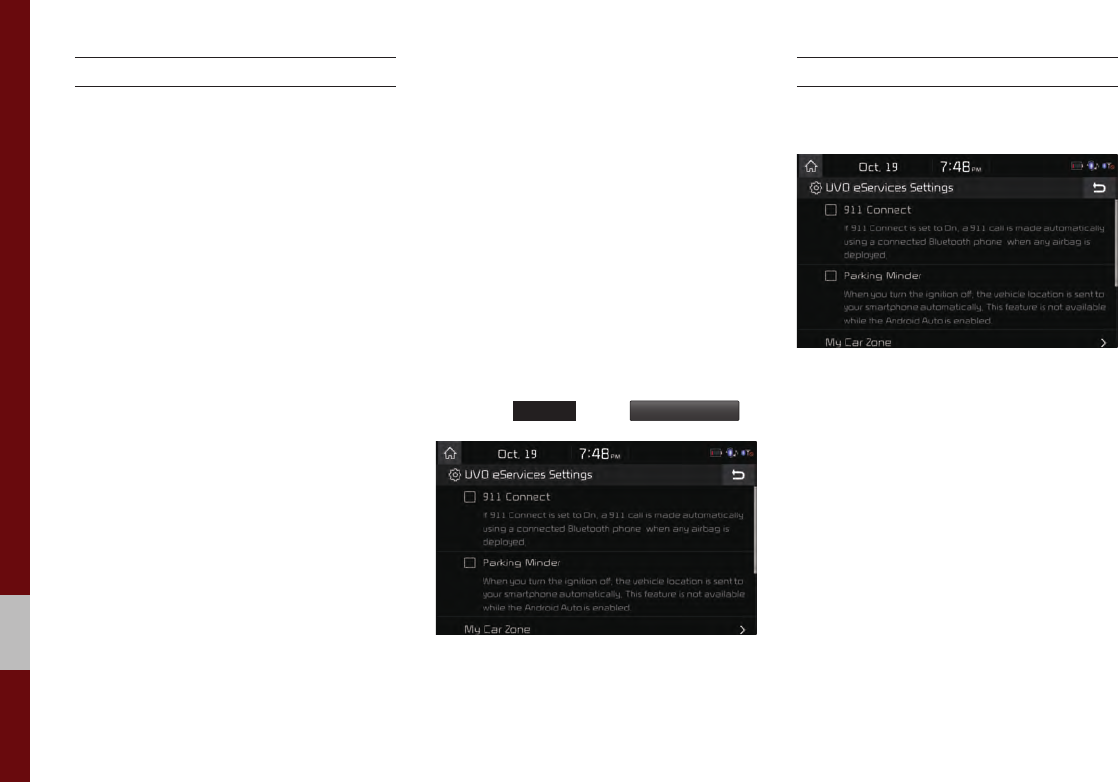
8-6 I Setup
Default Factory Settings
You can delete all paired devices and
restore the Default Bluetooth Settings. For
Default Factory Settings, all paired devices
are deleted, and the system is reset to
factory settings.
UVO eServices Settings
Within the eServices Settings screen,
UVO eServices related features can be set,
such as activating 911 Connect, Parking
Minder and setting the My Car Zone.
For safety reasons, My Car Zone Settings
cannot be adjusted while driving. Park
the vehicle before making any changes to
your settings.
Press the
SETUP
key ▶
UVO eServices
911 Connect
This feature is used to turn on or off the
911 Connect feature.
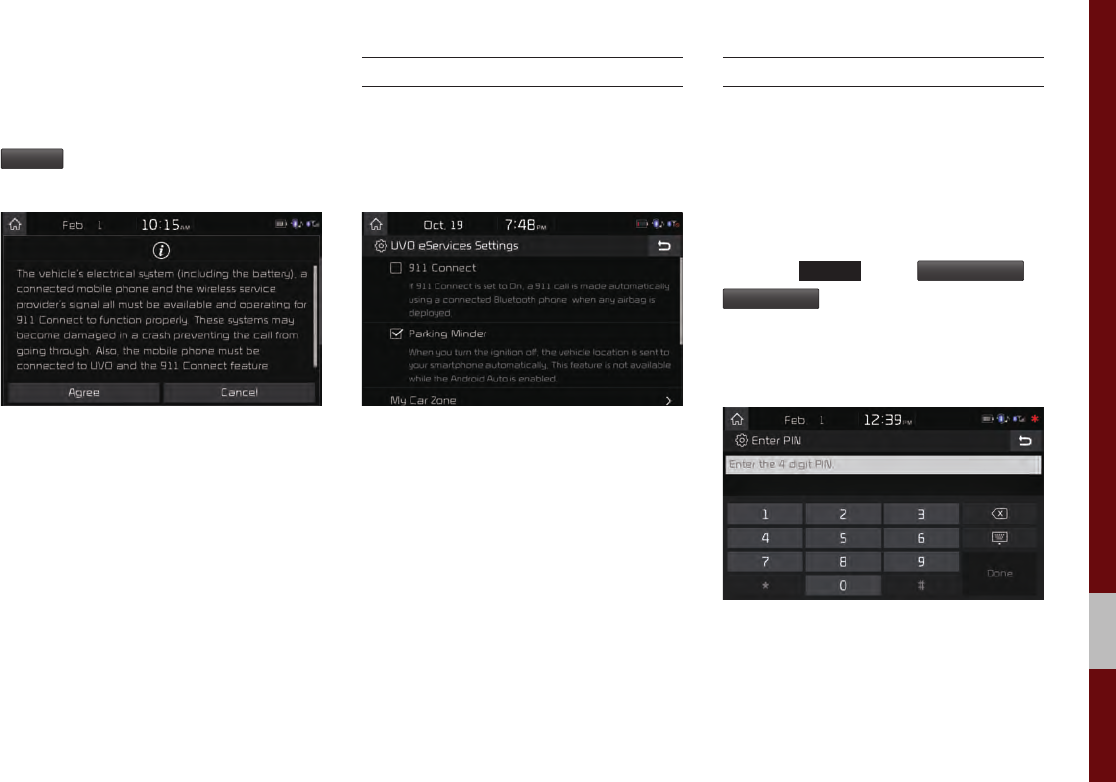
Setup I 8-7
08
When enabing this feature, you must first
agree to the 911 Connect tems of use.
After reading the tems of use, press the
Agree
button on the touch screen to
accept.
Parking Minder
If you want to send vehicle location to your
smartphone automatically when you turn
the ignition off, turn the Parking Minder
feature On.
My Car Zone
This feature is used to set My Car Zone
(Curfew Limit, Speed) alert conditions.
My Car Zone Settings is unavailable when
UVO eServices has not been activated.
Press the
SETUP
key ▶
UVO eServices
▶
My Car Zone
.
The PIN must be entered to use My Car
Zone Settings.
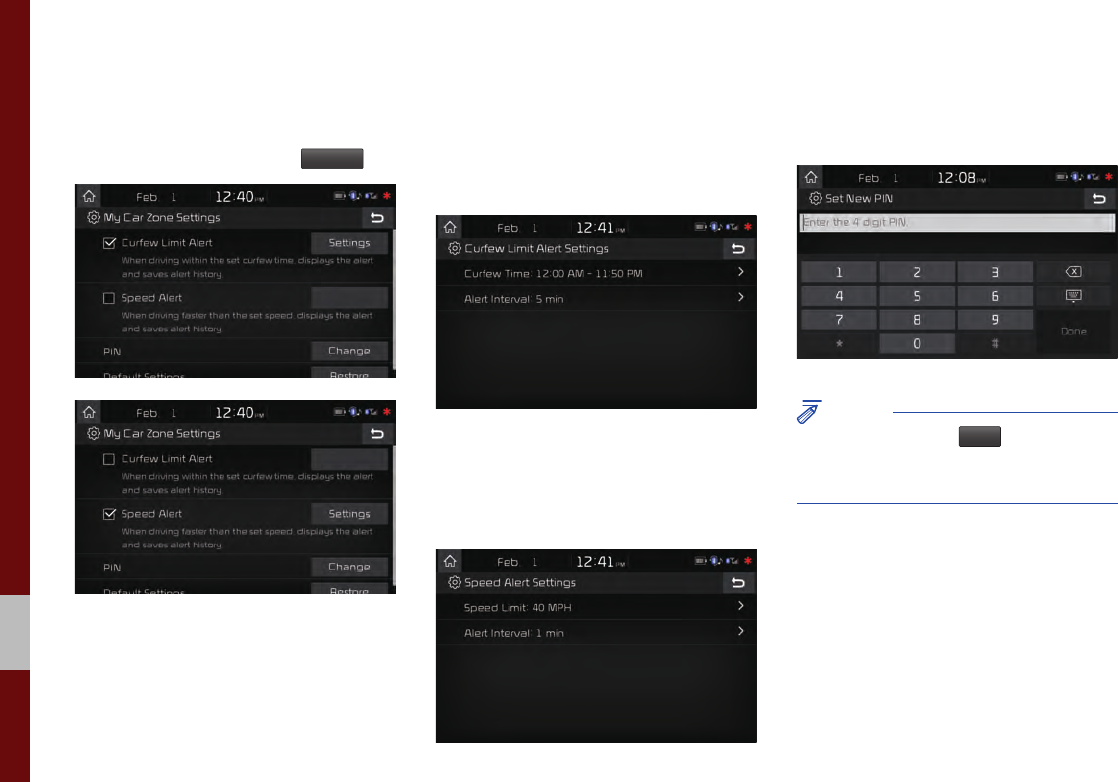
8-8 I Setup
This screen is used to set Curfew Limit
and Speed Alert features.
Set the alert conditions On ▶
Settings
.
Curfew Limit Alert Settings
Within Curfew Limit Alert Settings, you can
set the Curfew Limit Alert Start and End
Time. You can also set the Alert Interval of
alerts upon Curfew Limit.
Speed Alert Settings
Within Speed Alert Settings, you can set
the vehicle speed limit and Alert Interval of
alerts upon overspeeding.
PIN
This feature is used to change the PIN to
enter My Car Zone Settings.
NOTICE
• Before pressing
Done
, ensure your
smartphone is connected to UVO eServices
system via USB cable.
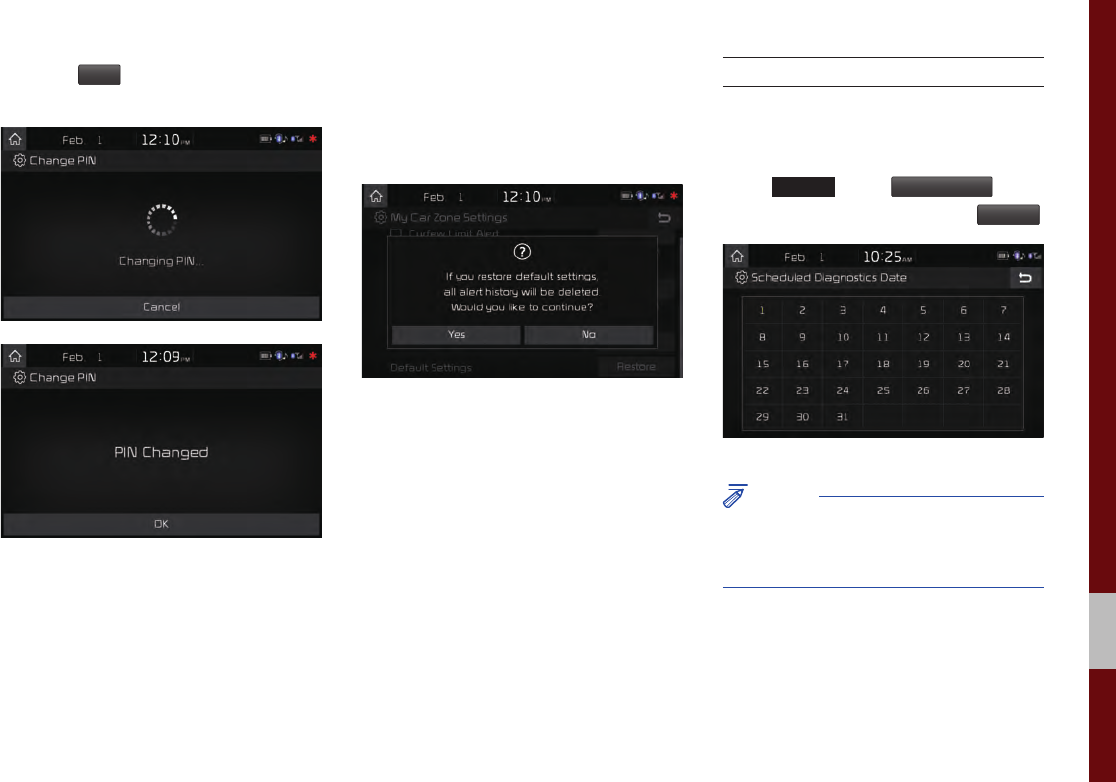
Setup I 8-9
08
Press the
Done
button to transmit the new
PIN to your My UVO com account.
Restore Factory Settings
This feature is used to restore all My Car
Zone alert history and settings back to
default state.
Scheduled Diagnostics
This feature is for setting when scheduled
diagnostics alerts display.
Press
SETUP
key ▶
UVO eServices
▶ Set
the Scheduled Diagnostics On ▶
Settings
NOTICE
• For months without the corresponding day,
the last day of the month will automatically be
set as the scheduled diagnostics date.
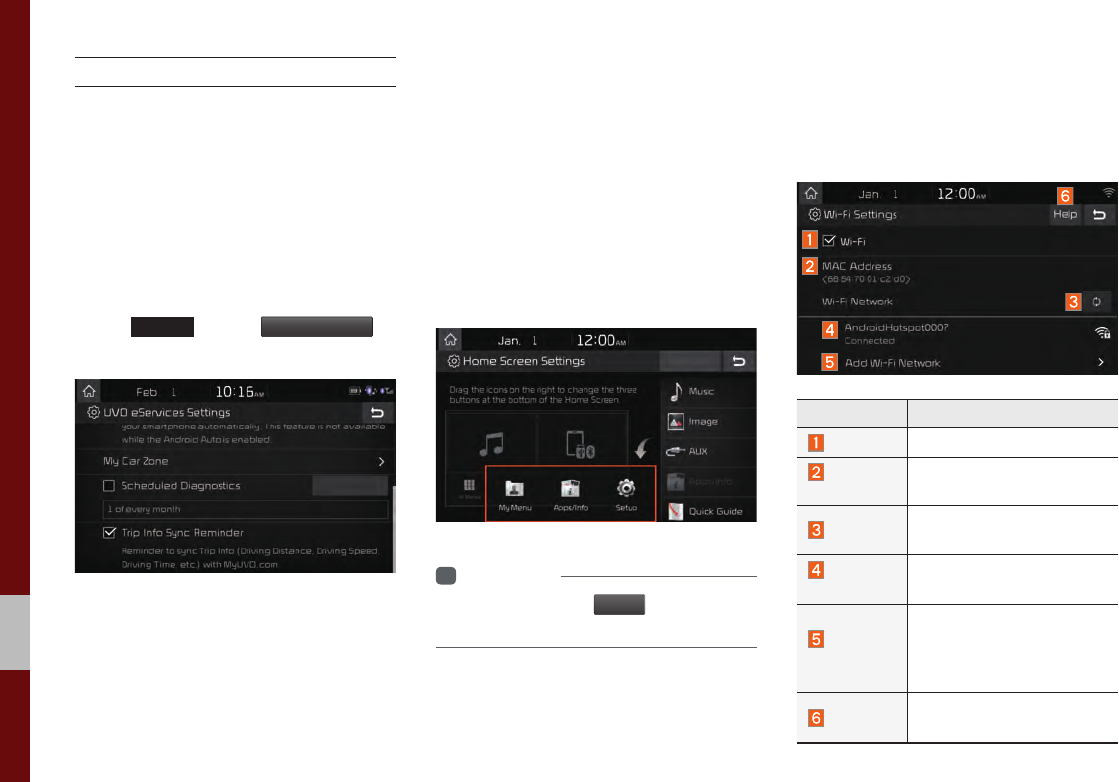
8-10 I Setup
Trip Info Sync Reminder
Trip Info is a feature used to set whether
system displays alert when trip info(Driv-
ing Distance, Driving Speed, Driving Time,
etc). reaches 90% of memory.
UVO eServices must be activated to use
this feature.
Press
SETUP
key ▶
UVO eServices
▶
Set Trip Info Sync Reminder On
Home Screen Settings
You can customize the three menu items
at the bottom right of the Home Screen
into the ones you want.
On the Home Screen Settings screen,
drag the menu items on the right to the
area marked in red in the screen below.
i
Information
• You can select the
D
efaul
t
button to reset
to the factory default settings.
Wi-Fi Settings
You can share a digital-device network
with the vehicle device through Wi-Fi.
Features Description
Wi-Fi Turn on/off Wi-Fi.
MAC
Address Displays the MAC address.
Refresh Searches available net-
works near the vehicle.
Network
Name
Displays available network
AP (Access Point) names.
Add Wi-Fi
Network
Enter the network ID/
password to connect to
a hidden network AP
(Access Point).
Help Shows the Wi-Fi setup
guide.
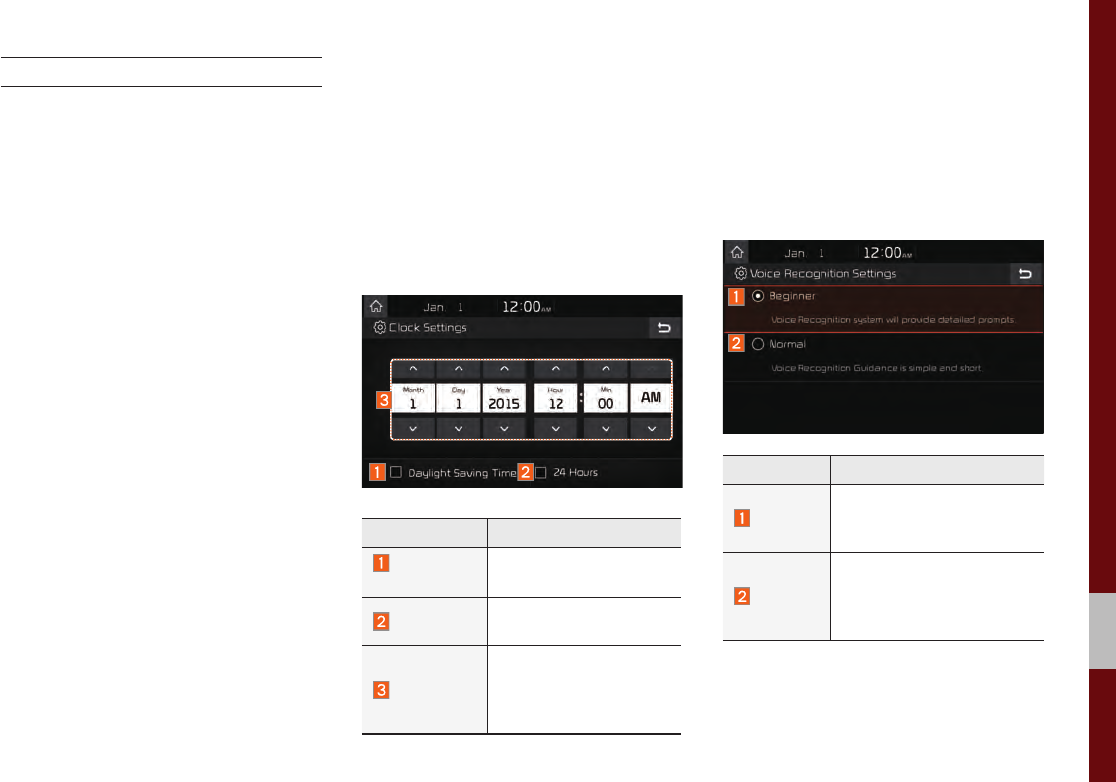
Setup I 8-11
08
How to Connect to a Network
1. In the Wi-Fi settings of a digital device,
activate Internet sharing (Hotspot).
2. In the vehicle network list, select the
desired device to connect to. Enter
the password to connect, if any.
Clock Settings
Configure the settings for time and date.
Using the arrow buttons, you can change
the values. Clock settings do not automat-
ically change when crossing into different
time zones. The time must be changed
manually on this screen.
Features Description
Daylight
Saving Time
The daylight saving
time (DST) is applied.
24 Hours The time display is set
in 24-hour format.
Direct entry
If you tap any value,
you can directly enter
the number in the fol-
lowing screen.
Voice Recognition
Settings
Configure how to make a call with
Voice Recognition Guidance and Voice
Recognition.
Features Description
Beginner
For beginners, the voice
recognition system pro-
vides voice prompts.
Normal
For normal users, the
voice recognition system
provides simple and short
voice guidances.
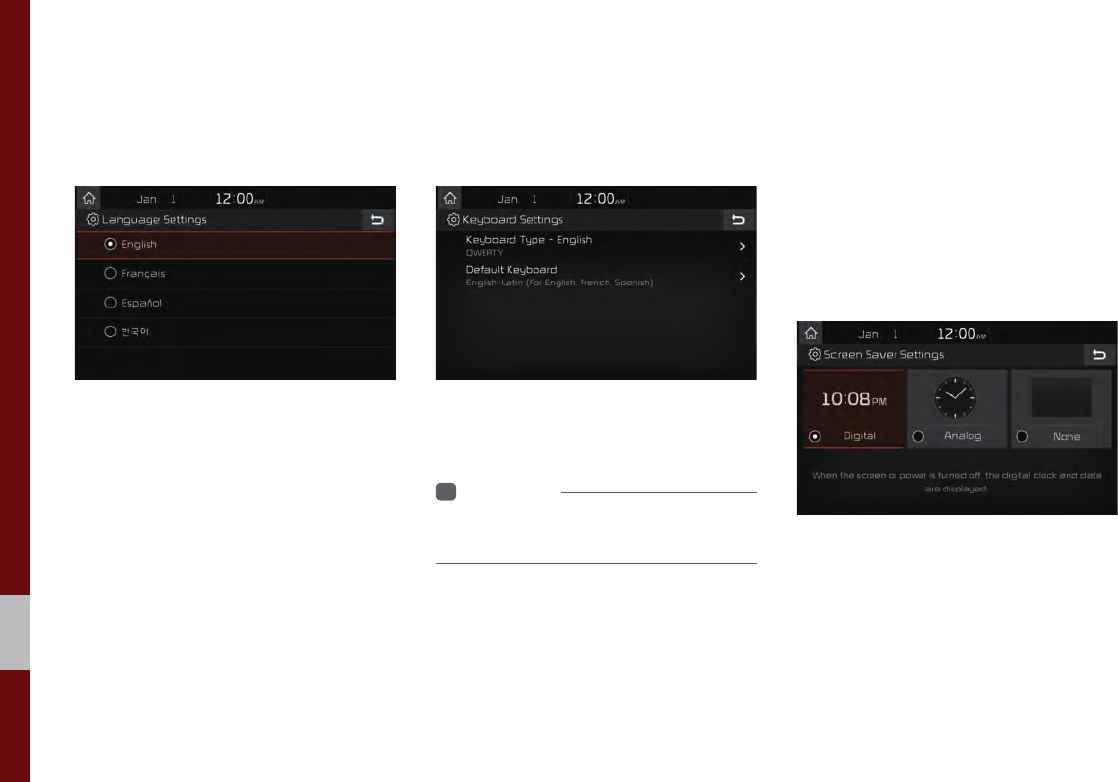
8-12 I Setup
Language Settings
You can configure the displayed system
language.
When the language is changed, the sys-
tem language is automatically changed.
Unique data including MP3 file name is
not changed and voice recognition does
not support some languages.
Keyboard Settings
You can configure the keyboard layout for
each language.
You can configure ABCD or QWERTY
keyboards for the system.
i
Information
• Configured keyboard layouts are applied
to all input modes.
Screen Saver Settings
You can select any of the following screen
formats to be displayed when the screen
or power is turned off (Press and hold the
Power button).
• Digital clock and date
• Analog clock and date
• None
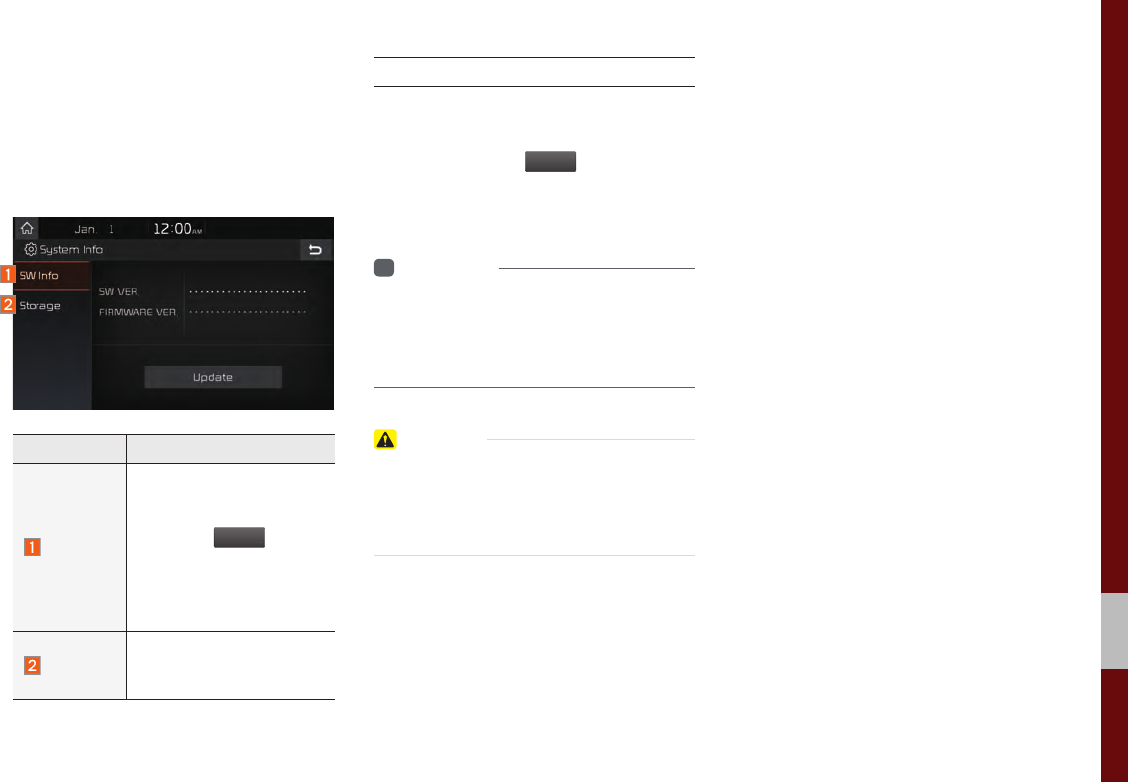
Setup I 8-13
08
System Info
At the System Info screen, software ver-
sion information, updates, and storage
status details are available.
Features Description
SW Info
System version informa-
tion and update details
are available.
Select the
U
p
d
a
t
e
button
to update the system.
After update is complete,
the system will reboot
automatically.
Storage
Displays the memory
space available for media
storage.
System Update
At the System Info screen, insert the USB
memory with the latest file downloaded,
and then select the
U
pdate
button to begin
updating. The system will then reboot
automatically.
i
Information
• This product needs supplemented software
updates and additional functions, which
collectively may take some time to complete,
depending on the amount of data.
CAUTION
• If the power is disconnected or the USB is
removed during an update, the data might be
damaged. Please do not turn off the vehicle
while an update is in progress.

MEMO

Product Specification
Troubleshooting
FAQ
part.9 Appendix
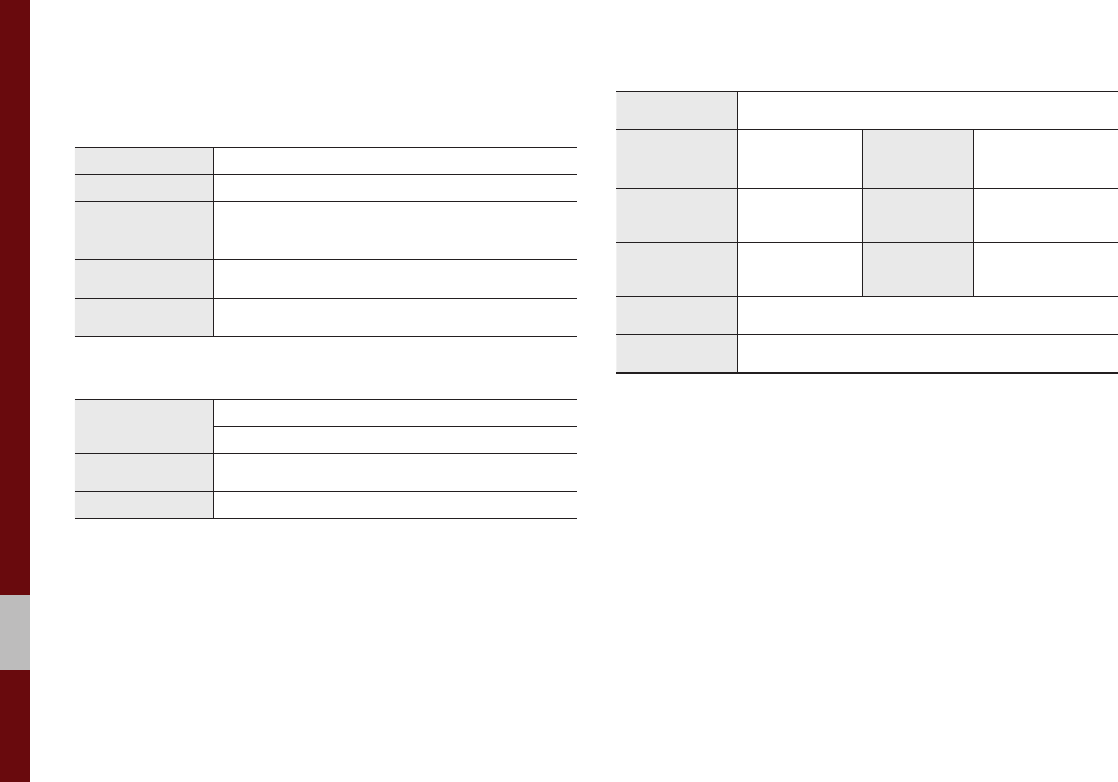
9-2 I Appendix
Product Specification
TFT-LCD
Screen Size 7 inch(152.4 X 91.44 mm)
Resolution 384000 pixels (Resolution: 800 x 480)
Operating
Method TFT(Thin Film Transistor) Active Matrix
Viewing Angle Left/Right, Top/Bottom: ALL 89°
Internal Lighting LED
Radio
Channels FM: 87.5 MHz ~ 107.9 MHz(Step: 200 kHz)
AM: 530 kHz ~ 1710 kHz(Step: 10 kHz)
Sensitivity FM: Under 10 dBu/AM: Under 35 dBu
Distortion Factor Within 2 %
Common
Name Car TFT LCD Display Audio Unit
Power Supply DC 14.4 V Operating
Power DC 9 V ~ DC 16 V
Current
Consumption 2.5 A Sleep
Current
1 mA
(Head Unit Only)
Operating
Temperature
-20 ~ +70 °C
(-4 ~ +158 °F)
Storage
Temperature
-30 ~ +80 °C
(-22 ~ +176 °F)
Dimensions 178 X 140.2 X 60 mm (Main BOX)
Weight 1.940 kg
Appendix
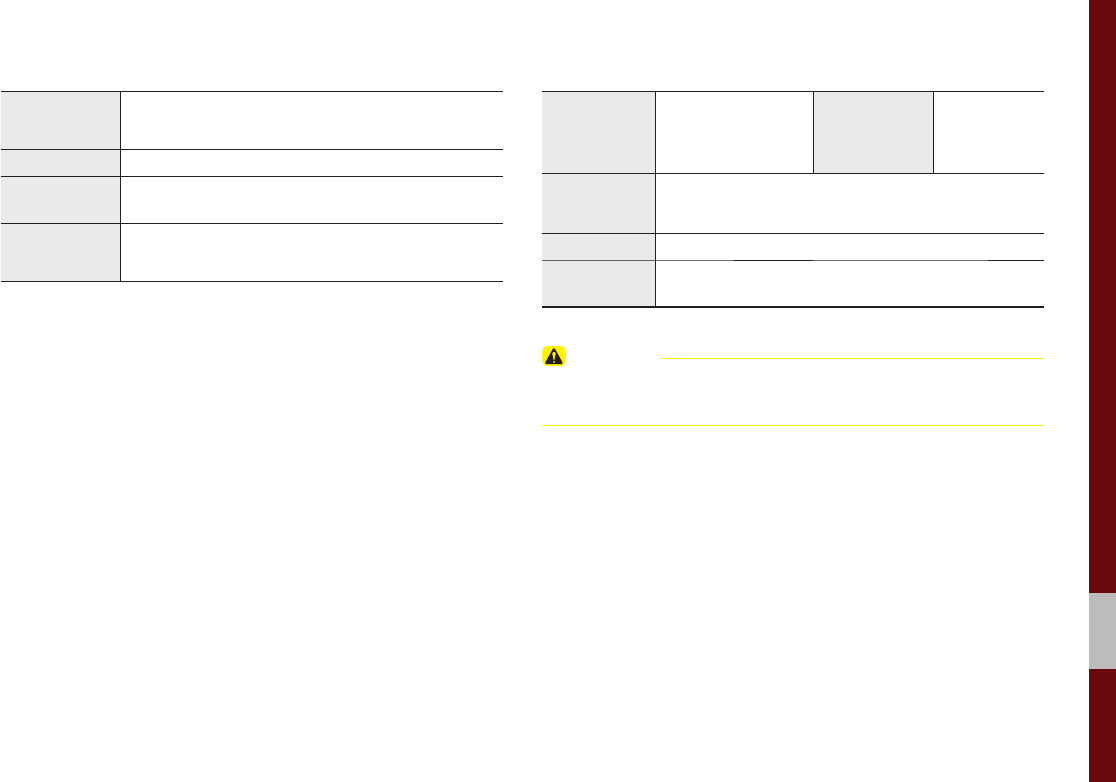
Appendix I 9-3
09
Wi-Fi Details
Frequency 2412 ~ 2462 MHz,
5180 ~ 5825 MHz
Specification IEEE802.11 a/b/g/n/ac
Operating
Temperature
-20 ~ +70
°C
(-4 ~ +158
°F
)
Supported
Bandwidth 20/40/80 MHz
Bluetooth®
Wireless Technology
Frequency
Range 2402 ~ 2480 MHz
Supported
Bluetooth
®
Specification
3.0
Supported
Profile Handsfree(1.6), A2DP(1.2), AVRCP(1.4), PBAP(1.0)
Output -6~4 dBm (Power Class2, Conducted)
Number of
Channels 79 channels
CAUTION
• The producer and installer cannot provide services related to life safety
as the concerned radio equipment is liable to radio interference.
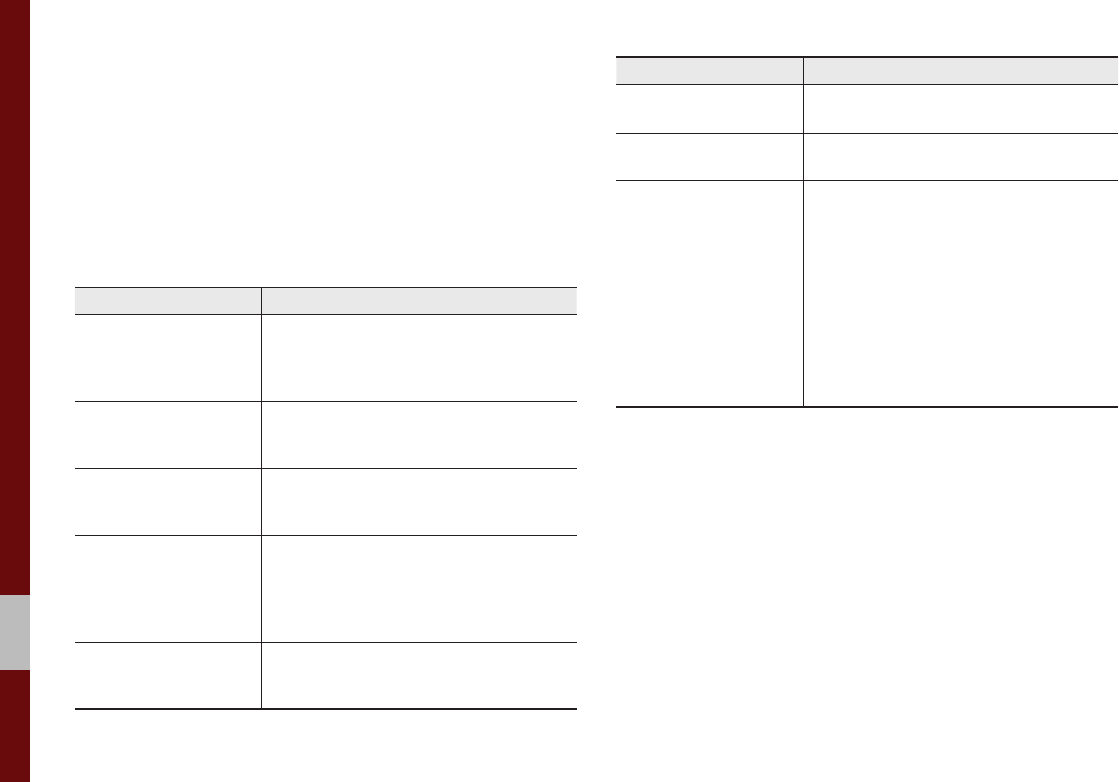
9-4 I Appendix
Troubleshooting
1. Errors which occur during the operation or installation of the
device may be mistaken as a malfunction of the actual device.
2. If you are having problems with the device, try the suggestions
listed below.
3. If the problems persist, contact your Kia dealer.
Problem Possible Cause
There are small red,
blue, or green dots on
the screen
• Because the LCD is manufactured with
technology requiring high point density,
a pixel or lighting deficiency may occur
within 0.01% of total pixels
The sound or image is
not working
• Has the Switch for the vehicle been
turned to [ACC] or [ON]?
• Has the SYSTEM been turned OFF?
The screen is being
displayed but sound is
not working
• Has the volume been set to a low level?
• Has the volume been muted?
When the power is
turned on, the corners
of the screen are dark
• The display appearing somewhat dark
after prolonged periods of use is normal
with LCD panels. It is not a malfunction
• If the screen is very dark, contact your
nearest Kia dealer for assistance
Sound is working from
only one speaker
• Are the positions of Fader or Balance
sound controls adjusted to only one
side?
Problem Possible Cause
Sound does not work in
AUX mode
• Are the audio connector jacks fully
inserted into the AUX terminal?
The external device is
not working
• Is the external device connected with a
standard connector cable?
Upon turning power on,
the most recent mode
screen is not displayed
Within modes that play files by reading
external sources, such as USB, iPod, or
Bluetooth
®
streaming mode, the most
recently played mode screen prior to turn-
ing off power may not properly load
• If the corresponding device is not con-
nected, the mode operated prior to the
most recent mode will operate
• If the previous mode still cannot be
properly played, the mode operated
prior to that will operate

Appendix I 9-5
09
Problem Possible Cause Countermeasure
The power
does not
turn on
The fuse is discon-
nected
• Replace with a suitable fuse
• If the fuse is disconnected
again, please contact your
point of purchase or Kia
dealer
Device is not properly
connected
• Check to see that the
device has been properly
connected
The system
does not
play
The vehicle battery is
low
• Charge the battery If the
problem persists, contact
your point of purchase or
Kia dealer
Problem Possible Cause Countermeasure
The image
color/tone
quality is
low
• The brightness,
saturation, hue,
and contrast levels
are not set properly
• Properly adjust the bright-
ness, saturation, hue, and
contrast levels through
Display Setup
Sound does
not work
• The volume level
is set to the lowest
level
• The connection is
not proper
• The device is
currently fast-for-
warding, rewinding,
scanning, or play-
ing in slow mode
• Adjust the volume level
• Check to see that the
device has been properly
connected
• The sound will not work
when the device is fast-for-
warding, rewinding, scan-
ning, or playing in slow
mode
The sound
or image
quality is
low
• Vibration is occur-
ring from where
the conversion
switch has been
installed
• Image color/tone
quality is low
• The sound may be
short-circuited and the
image distorted if the
device vibrates
• The device will return to
normal once vibrations stop
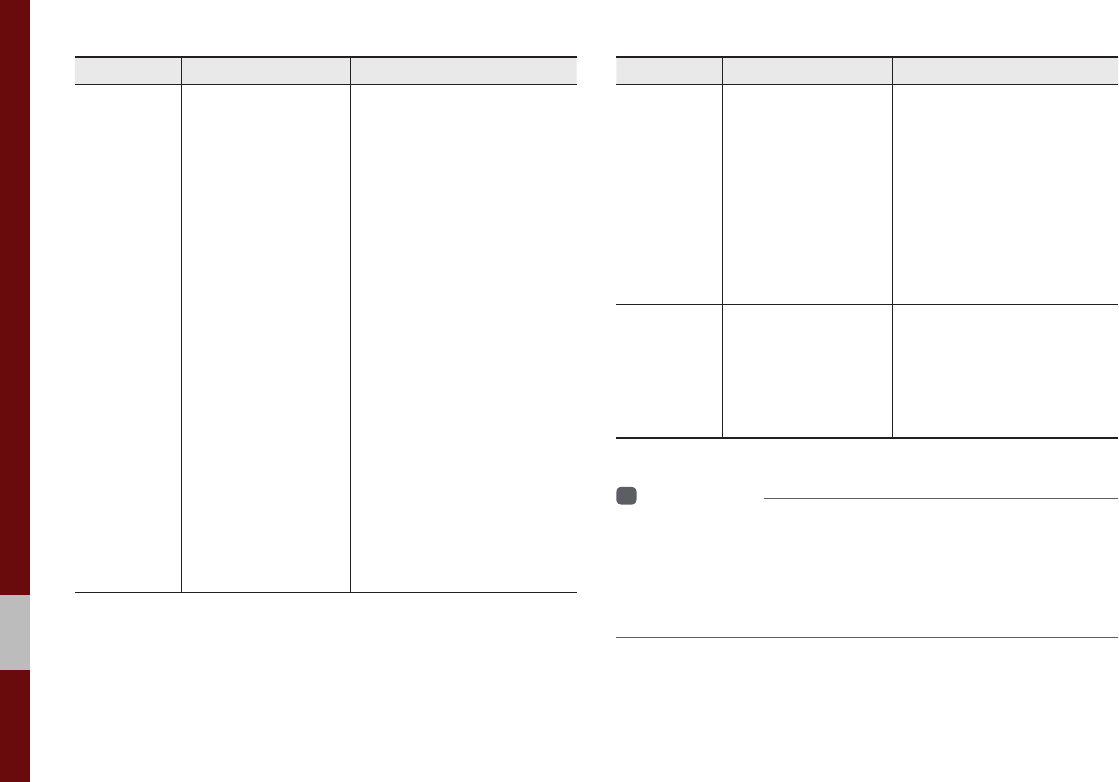
9-6 I Appendix
Problem Possible Cause Countermeasure
The USB
does not
work
• USB memory is
damaged
• Please use the USB after
formatting it.
• USB memory has
been contaminated
• Remove any foreign sub-
stances on the contact
surface of the USB memory
and multimedia terminal
• A separately pur-
chased USB HUB
is being used
• Directly connect the USB
memory with the multime-
dia terminal on the vehicle
• A USB extension
cable is being
used
• Directly connect the USB
memory with the multime-
dia terminal on the vehicle
• A USB which is
not a Metal Cover
Type USB Memory
is being used
• Use standard USB
Memory
• An HDD type, CF,
SD Memory is
being used
• Use standard USB
Memory
• There are no
music files which
can be played
• Only MP3, WMA file
formats are supported.
Please use only the sup-
ported music file formats
Problem Possible Cause Countermeasure
The iPod is
not recog-
nized even
though it
has been
connected
• There are no titles
which can be
played
• Use iTunes to download
and save MP3 files into the
iPod
• The iPod firmware
version has not
been properly
updated
• Use iTunes to update
the firmware version and
reconnect the iPod with the
device
• The iPod device
does not recog-
nize downloads
• Reset the iPod and recon-
nect with the device
Bluetooth
does not
work or
its limited
functions are
available
• Bluetooth on your
mobile phone is
set to OFF
• Set it to ON
• The Bluetooth
connection is not
made
• Make the connection
active
i
Information
• While operating the device, if an abnormality occurs that cannot be
corrected with the above described measures, press the
RESET
key to
reset the system.
• Press and hold the
RESET
key (more than 1 second). The device power
will turn off and the system will reset.

Appendix I 9-7
09
FAQ
About Pairing Mobile Phones
Q I cannot pair my mobile phone. What is the cause?
A Check to see that the mobile phone supports Bluetooth® func-
tion. Verify if Bluetooth on the cell phone is set to OFF. If so, set
it to ON. If the cell phone still can’t be registered, try again after
turning Bluetooth off and on, or delete the device registration on
the multimedia system and cell phone and then register the cell
phone again.
Q What is the difference between pairing a mobile phone and con-
necting a mobile phone?
A Pairing occurs through authenticating the head unit and mobile
phone. Mobile phones paired to the head unit can be connected
and disconnected until the paired mobile phone is deleted from
the system. Bluetooth® Handsfree features, such as making/
answering calls or managing contacts, are supported only in
mobile phones connected with the head unit.
Q What is a Passkey?
A A passkey is the password used to authenticate the connection
between the head unit and mobile phone. The passkey only
needs to be entered once when pairing the mobile phone for
the first time.
The initial passkey is 0000. You can change it with
SETUP
▶
Bluetoot
h
▶
B
luetooth System Info
▶
P
asske
y
menu options.
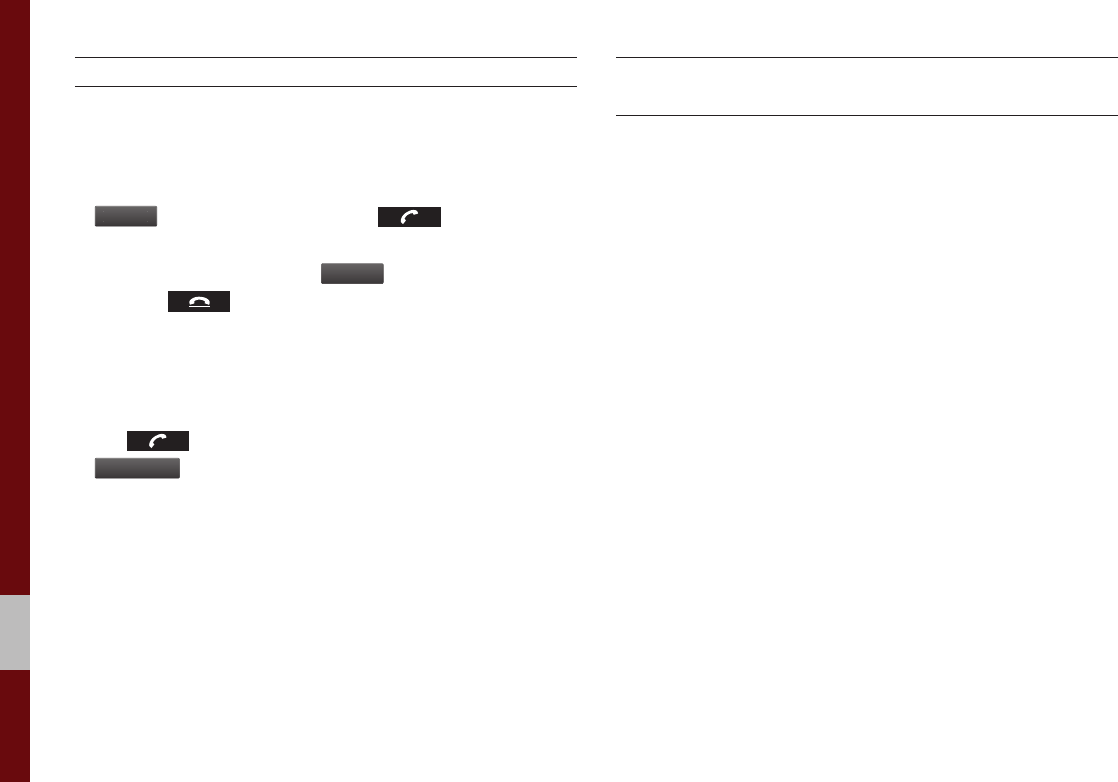
9-8 I Appendix
About Making/Answering Phone Calls
Q How can I answer a call?
A When there is an incoming call, a notification pop-up will
become displayed. To answer the incoming call, select the
A
ccep
t
button on the screen or the key on the steer-
ing
wheel control
.
To reject the call, select the
Reject
button on the screen or
press the key on the steering wheel control.
Q What should I do if I am talking on the Handsfree but want to
switch the call to the mobile phone?
A While on a call, press and hold (more than 0.8 seconds)
the key on the steering
wheel control
or select the
U
se
P
r
i
va
te
button at the bottom of the Phone screen to switch
the call to your mobile phone.
About
Bluetooth
® Wireless Technology/
Head Unit Use Environment
Q What is the range of my wireless connection?
A The wireless connection can be used within 15 yards.
Q How many mobile phones can be paired?
A It is possible to pair up to five mobile phones.
Q Why is call quality sometimes poor?
A
Check the reception sensitivity of the mobile phone when call
quality becomes worsened. The call quality may deteriorate when
the signal strength is low. Call quality may also worsen if metal
objects, such as beverage cans, are placed near the mobile
phone. Check to see if there are metal objects in the vicinity of
the mobile phone. The call sound and quality may differ depend-
ing on the type of mobile phone.

09
Important Information
Before using your Multimedia system, read and follow all instructions and safety information provided in this end user manual ("User's
Guide"). Not following precautions found in this User's Guide can lead to an accident or other serious consequences.
Keep User's Guide in Vehicle
When kept in the vehicle, the User's Guide will be a ready reference for you and other users unfamiliar with the Multimedia system. Please
make certain that before using the system for the first time, all persons have access to the User's Guide and read its instructions and
safety information carefully.
Warning
Operating certain parts of this system while driving can distract your attention away from the road, and possibly cause an accident or other
serious consequences. Do not change system settings or enter data non-verbally (using your hands) while driving. Stop the vehicle in a
safe and legal manner before attempting these operations. This is important since while setting up or changing some functions as you may
to distract your attention away from the road and remove your hands from the wheel.

General Operation
Voice Command Control
Functions within the Multimedia system may be accomplished using only voice commands. Using voice commands while driving allows
you to operate the system without removing your hands from the wheel.
Prolonged Views of Screen
Do not access any function requiring a prolonged view of the screen while you are driving. Pull over in a safe and legal manner before
attempting to access a function of the system requiring prolonged attention. Even occasional short scans to the screen may be hazardous
if your attention has been diverted away from your driving task at a critical time.
Volume Setting
Do not raise the volume excessively. Keep the volume at a level where you can still hear outside traffic and emergency signals while
driving. Driving while unable to hear these sounds could cause an accident.
Use of Speech Recognition Functions
Speech recognition software is inherently a statistical process which is subject to errors. It is your responsibility to monitor any
speech recognition functions included in the system and address any errors.

FCC Warning
FCC Part 15.19 Statements:
This device complies with Part 15 of the FCC Rules. Operation is subject to the following two conditions: (1) this device may not
cause harmful interference, and (2) this device must accept any interference received, including interference that may cause
undesired operation.
FCC Part 15.105 statement
This equipment has been tested and found to comply with the limits for a Class B digital device, pursuant to part 15 of the FCC
Rules.
These limits are designed to provide reasonable protection against harmful interference in a residential installation. This equipment
generates, uses and can radiate radio frequency energy and, if not installed and used in accordance with the instructions, may
cause harmful interference to radio communications. However, there is no guarantee that interference will not occur in a particular
installation. If this equipment does cause harmful interference to radio or television reception, which can be determined by turning
the equipment off and on, the user is encouraged to try to correct the interference by one or more of the following measures:
- Reorient or relocate the receiving antenna.
- Increase the separation between the equipment and receiver.
- Connect the equipment into an outlet on a circuit different from that to which the receiver is connected.
- Consult the dealer or an experienced radio/TV technician for help.
FCC Part 15.21 statement
Any changes or modifications not expressly approved by the party responsible for compliance could void the user's authority to
operate this equipment.
RF Exposure Statement (MPE)
The antenna (s) must be installed such that a minimum separation distance of at least 20 cm is
maintained between the radiator (antenna) and all persons at all times. This device must not be co-located or operating in
conjunction with any other antenna or transmitter.
06